There are plenty of gas and charcoal options across a variety of price points, so let’s dive right in, shall we?
What’s the best BBQ in the UK?
We reckon Char-Broil’s Gas2Coal hybrid model (buy now) is one of the best choices for most people, given its ability to use both gas and charcoal for cooking. You can even use gas to quickly and easily ignite the charcoal, making for a much faster all-charcoal experience, if you prefer.
Other BBQ recommendations
The Char-Broil’s Gas2Coal isn’t quite right for you? Fear not, for there are plenty of other grills we recommend:
The Weber Master-Touch (buy now) blends Weber’s iconic Kettle design with smarter functionality (including modular accessories and a lid holder), the Master-Touch is a premium charcoal BBQ with superb performance, and looks to match.
The Landmann Triton MaxX 4.1 (buy now) has plenty of space for even the largest of get-togethers, with a built-in warming rack to help serve everything simultaneously. It’s the included infrared side grill though, that sets it apart — perfect for searing steaks at blistering temperatures.
The Blackstone 36-inch Flat Top Griddle Station (buy now) proves there’s nothing like a flat-top griddle for perfect smash burgers, browned steaks, eggs, omelettes, or pretty much anything else you care to think of. It’s one of the very best, and is built to last.
If you’re looking for a portable BBQ, then check out our guide to the best portable BBQ, too.
The best BBQs in the UK you can buy today:
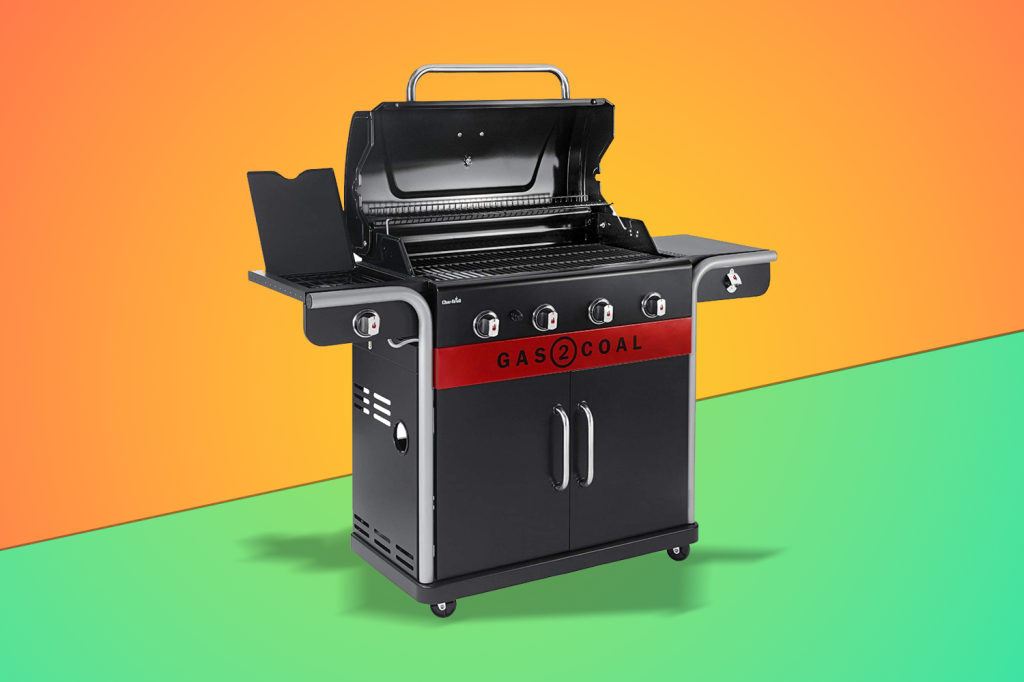
1. Char-Broil Gas2Coal
Stuff Verdict
Char-Broil’s hybrid grill effortlessly transitions between gas and charcoal cooking, making it perfect for indecisive users, and it includes a side burner and warming rack.
Pros
- Hybrid fuel is really useful
- Very economic on gas usage
Cons
- Coal tray can be difficult to clean
- Takes a while to assemble
| Char-Broil Gas2Coal specs | |
|---|---|
| Fuel | Gas and charcoal |
| Weight | 63.7 kg |
If you’re indecisive, then Char-Broil’s hybrid model is one of the best choices for you, thanks to its ability to convert from gas to charcoal in less than 60 seconds. Simply remove the supplied charcoal tray, and cook with regular gas burners if you’re short on time with hungry mouths to feed.
If you’ve got a hankering for old-fashioned charcoal though, load up the tray, and handily light the charcoal with the gas burners themselves — no chimney stacks or lighter materials required. The charcoal tray itself also helps prevent flare-ups, resulting in more even cooking.
Better yet, there’s a built-in side burner for additional cooking powers, along with a warming rack and porcelain-coated cast iron grates for longevity and easy cleaning.
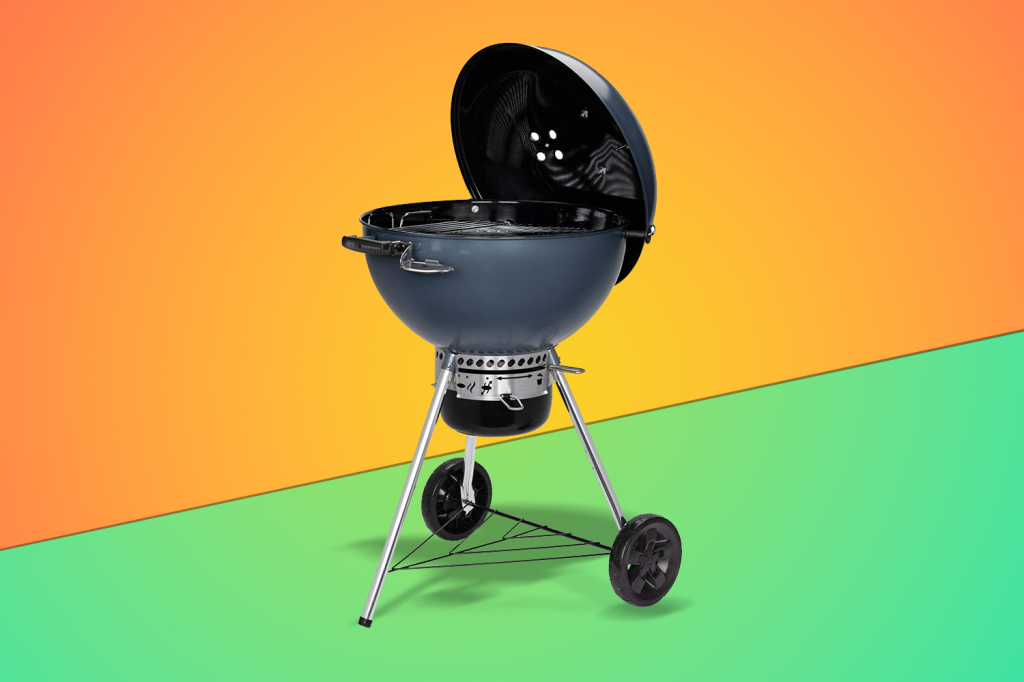
2. Weber Master-Touch
Stuff Verdict
The Weber Master-Touch charcoal BBQ offers a refined take on the iconic Kettle design, with added height, a deeper lid with a built-in holder.
Pros
- Tuck-Away lid holder is very useful
- Versatile design
Cons
- Not the most stable on un-even ground
- Much more expensive than cheaper models
| Weber Master-Touch specs | |
|---|---|
| Fuel | Charcoal |
| Weight | 21.3 kg |
Weber’s Original Kettle charcoal BBQ is one of the most iconic choices and one that will spring to mind for most people. But we’re big fans of the Master-Touch model, which keeps the essence of the Kettle, while serving up a multitude of improvements in the process.
It’s a little taller, for starters, making for a more comfortable grilling experience. The lid is a little deeper too, and can be handily stored in a built-in lid holder, which is an improvement over the original’s lid hook. The addition of Weber’s Gourmet BBQ System grill is another big draw, letting you swap out different modules like pizza stones for more versatility. It’s easy to clean too, thanks to a clever ash sweeping/collection system, and we think the Slate Blue variant, in particular, is rather dashing.
Overall, if you’re a charcoal fan, this is a BBQ that will serve you well for years to come, while looking superb in the process.

3. Landmann Triton MaxX 4.1
Stuff Verdict
This spacious four-burner grill features enamel-coated steel flame tamers for even heat distribution, a warming rack, a modular cooking system for accessories like pizza stones etc.
Pros
- Enamel coating for even heat distribution
- Large cooking area
Cons
- Could be too large for some
| Landmann Triton MaxX 4.1 specs | |
|---|---|
| Fuel | Gas |
| Weight | 47 kg |
Landmann’s capacious four-burner entry has more than enough space to feed large, ravenous groups, with specially designed enamel-coated steel flame tamers to help distribute heat evenly across the grill. A built-in warming rack lets you serve everything at an appropriate temperature at the same time, while a modular cooking system supports extra accessories like pizza stones.
The real star of the show though, is the infrared side burner, which is capable of reaching a blistering 1500°F (800 °C). This makes it an absolute godsend for creating perfectly seared steaks in record time, letting you create perfect outer crusts without over-cooking the insides. Once you’ve tried infrared, you’ll never want to sear on anything else ever again.

4. Blackstone 36-inch Outdoor Flat Top Gas Griddle Station
Stuff Verdict
A top choice for those who appreciate this style of cooking, offering ample space for various dishes, four independent heat zones for precision cooking.
Pros
- Massive grilling surface
- Four heat zones for lots of control
Cons
- Side trays don’t fold for storage
- Heavy
| Blackstone 36-inch Outdoor Flat Top Gas Griddle Station specs | |
|---|---|
| Fuel | Gas |
| Weight | 58 kg |
If you’re sold on the wonderful world of flat-top griddles, then you can’t get much better than Blackstone. This huge gas-powered 36in model is one of the best BBQs in the UK, and features more than enough space for feeding smash burgers to a horde of hungry guests — though there’s nothing stopping you from using it for stir-fries, pancakes, eggs, or anything else you require.
Four independent heat zones provide plenty of control over your cooks, while there’s plenty of space on either side for storage/prep. If you find yourself cooking in cast iron skillets, why not cut out the middleman and cook directly on this massive surface instead? You won’t regret it.
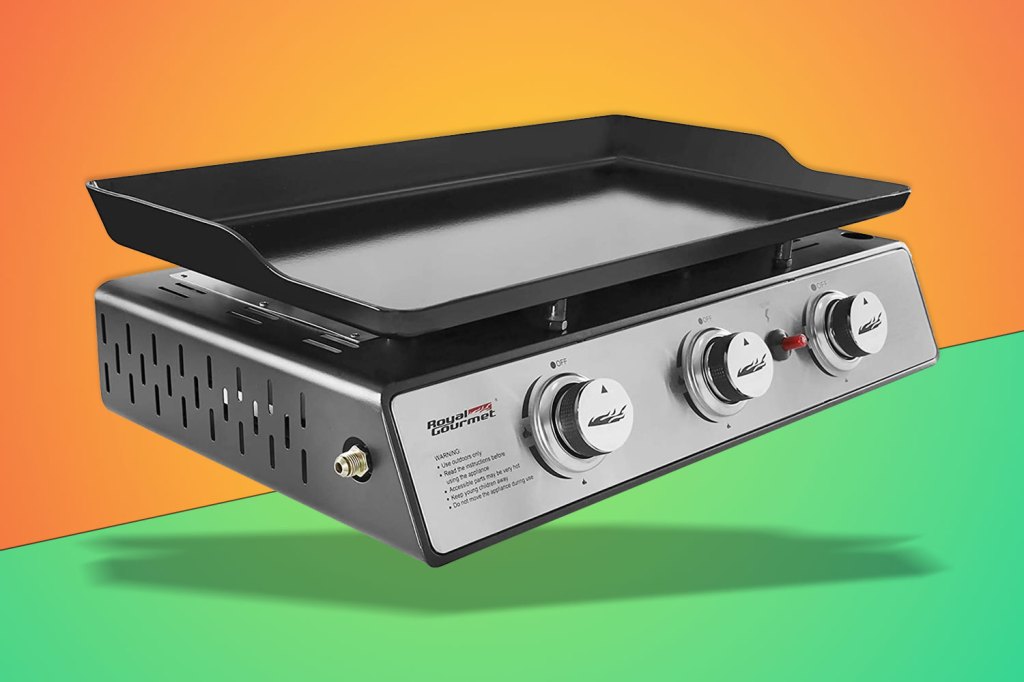
5. Royal Gourmet Portable Table Top Gas Grill Griddle
Stuff Verdict
Despite the absence of grill lines, the flat-top griddle excels, ideal for smash burgers, versatile for various dishes, and portable for both backyard and camping use.
Pros
- Lightweight and portable
- Non-stock grill top
Cons
- Tricky to control temprature
- Takes a while to heat up
| Royal Gourmet Portable Table Top Gas Grill Griddle specs | |
|---|---|
| Fuel | Gas |
| Weight | 13.3 kg |
Don’t be put off by the flat-top nature of this griddle. Yes, the lack of bars means no aesthetic grill lines, but it makes up for it in practically every other way. The flat surface means that everything from burgers and sausages, to steaks and vegetables will make full contact with a heated surface, resulting in a much better, more consistent Maillard reaction (aka, the delicious browning that makes food extra delicious).
This also makes it a perfect choice for smash burger fans, who can press down balls of mince to create super-slim and crispy patties for multi-layered burgers bursting with flavour. Throw in the fact that this is easily portable for both backyard and camping use, and it could potentially even replace your dedicated BBQ. Win-win.
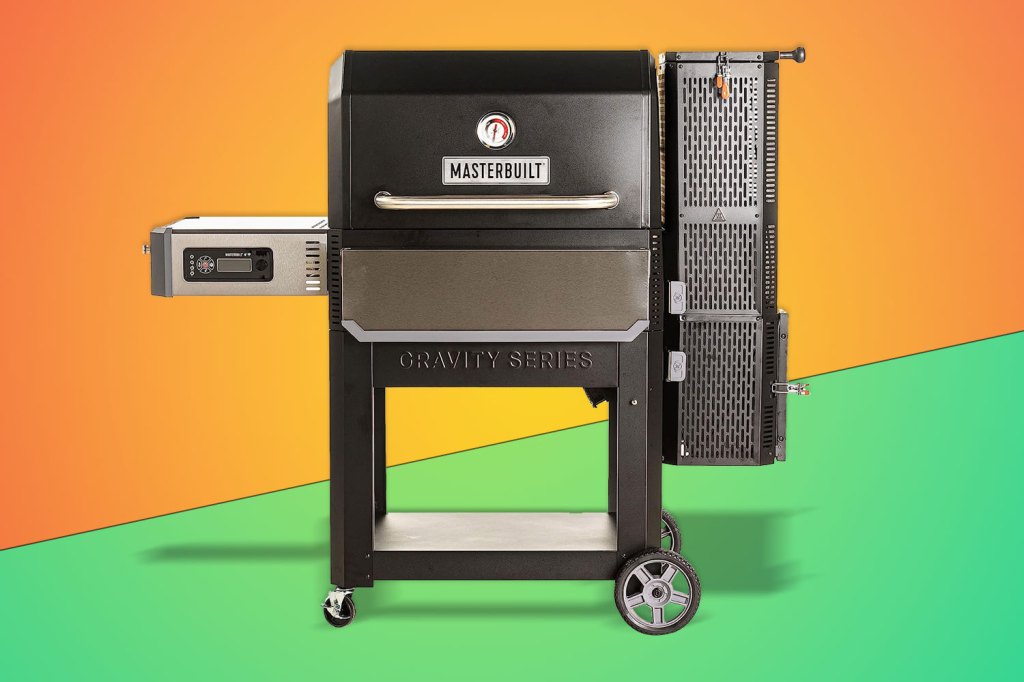
6. Masterbuilt Gravity Series 1050
Stuff Verdict
Masterbuilt’s Gravity Series 1050 boasts a capacious hopper, long cook times, cast-iron grates, digital controls, and convenient features for a hassle-free backyard cookout.
Pros
- Digital controls are super innovative
- So many smart design details
Cons
- No real direct heat cooking
- Very heavy
| Masterbuilt Gravity Series 1050 specs | |
|---|---|
| Fuel | Charcoal |
| Weight | 92 kg |
Masterbuilt’s Gravity Series is aptly named, with the 1050 model featuring a capacious gravity-fed hopper capable of fuelling your cooks for a whopping 12-15 hours of use. Supporting up to 9.9lbs (4.5kg) of lump charcoal or 15.4lbs (7kg) of briquettes, you can enjoy slow-cooked delicacies like brisket and ribs without being chained to your outdoor cooking station.
Cast-iron grates produce perfectly-seared results, while a digital control panel, complete with an accompanying Bluetooth/Wi-Fi controlled app, make keeping an eye on everything a breeze too. With convenient racks and numerous shelves, it’s got everything you need for a hassle-free backyard cookout.
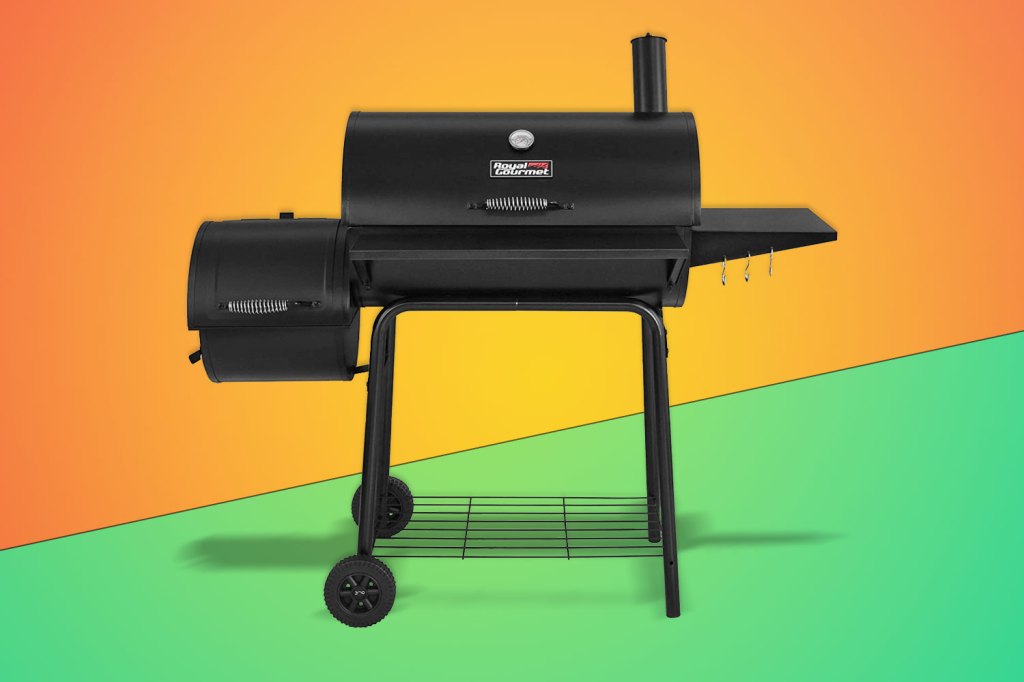
7. Royal Gourmet Charcoal Grill
Stuff Verdict
Affordable, capacious charcoal grill with durable grates, adjustable heat, built-in smoker, and extras for excellent value.
Pros
- Great price
- Porcelain-enamelled steel cooking grates
Cons
- Smoker box could be larger
| Royal Gourmet Charcoal Grill specs | |
|---|---|
| Fuel | Charcoal |
| Weight | 22.8 kg |
This capacious, affordable charcoal grill features ample cooking space, along with porcelain-enamelled steel cooking grates for durability and performance. A built-in thermometer provides an easy way to keep an eye on the temperature at a glance, while a height-adjustable charcoal pan allows for quick and easy control over the level of cooking heat.
If that wasn’t enough, it also has a useful built-in offset smoker, complete with its own lid, letting you smoke anything from meat to vegetable side dishes for an extra dash of BBQ goodness. An included cover, utensil hooks, and a smoke stack, round off the features rather nicely. Plenty for your money, at this price.

8. Everdure by Heston Blumenthal Hub charcoal BBQ
Stuff Verdict
Heston Blumenthal-approved Hub BBQ combines style and performance but comes with a hefty price tag, offering a design statement and a built-in rotisserie system for culinary excellence.
Pros
- Attractive design
- Rotisserie system is so impressive
Cons
- Expensive
- More accessories should be included
| Everdure by Heston Blumenthal Hub charcoal BBQ specs | |
|---|---|
| Fuel | Charcoal |
| Weight | 40 kg |
If a BBQ has world-renowned chef Heston Blumenthal’s seal of approval, it’s not going to be cheap. Or ordinary. And the charcoal-fuelled Hub BBQ makes good on both.
Hefty price tag aside, you’re clearly getting something that’s far more refined than your average heap of industrialised, functional metal. With sharp lines, rounded corners, and angular legs, it’s as much a design talking point as it is a food-searing powerhouse.
On that note, it’s a heck of a performer too, managing to stand out from the rest of the competition with its built-in rotisserie system. From succulent chicken to mouth-watering pork, the possibilities for both taste and visual theatre are endless. And if you require something a little easier, there’s an electric-powered version too.
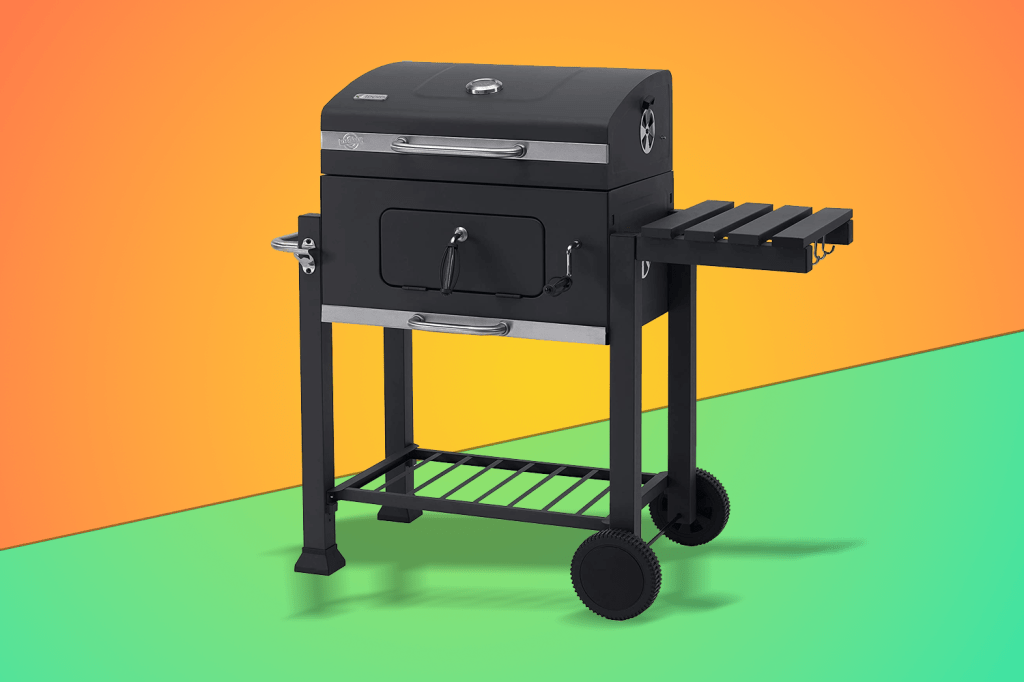
9. Tepro Grillwagen Toronto
Stuff Verdict
Tepro’s Grillwagen offers excellent value with speedy assembly, a generous grilling area, warming rack, ash collection tray, and adjustable coal height for perfect cooking, all at an affordable price.
Pros
- Affordable price
- Super quick assembly time
Cons
- Build quality isn’t the best
- Instructions could be better
| Tepro Grillwagen Toronto specs | |
|---|---|
| Fuel | Charcoal |
| Weight | 27 kg |
While Tepro’s Grillwagen is lacking in the brand recognition department, it more than makes up for it with excellent bang for your buck. The cheapest offering on our list, this is a charcoal BBQ that offers plenty to love, including a speedy assembly time of just 30 minutes.
A generous grilling area is made even better by a built-in warming rack and handy ash collection tray, while a Grid in Grid system lets you pop in modular accessories like pizza stones if you wish to mix things up.
The best part, though, is a built-in handle that can be turned to raise and lower the coals, letting you change the intensity of the heat to achieve the perfect finish. If you’ve ever suffered from burnt buns or overly sizzled sausages in the past, this will be a particularly useful defence mechanism.
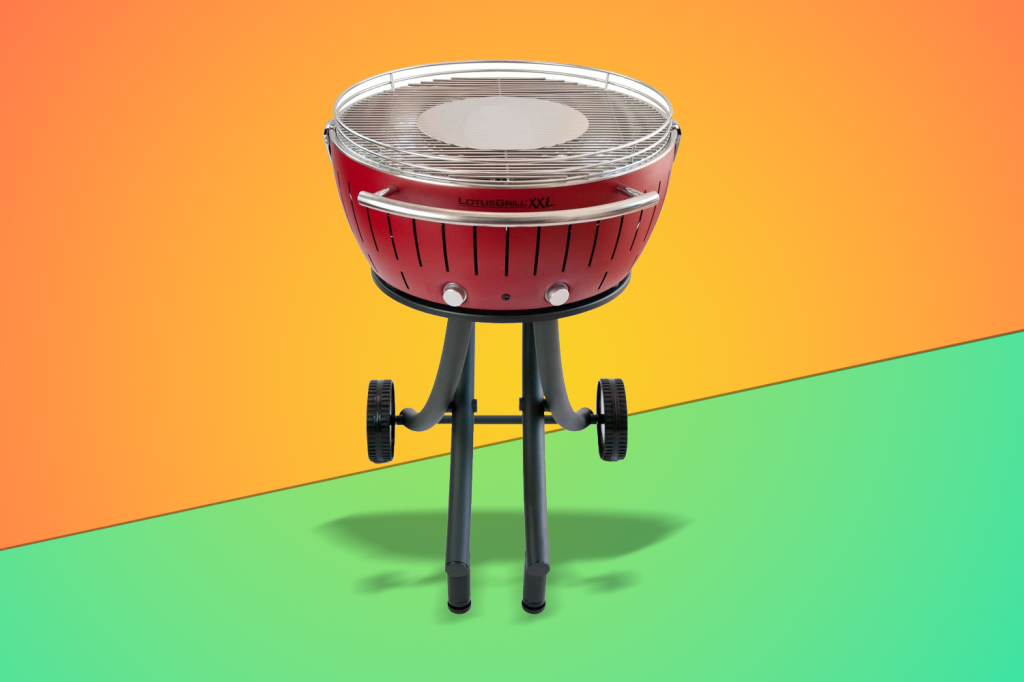
10. LotusGrill XXL
Stuff Verdict
A smokeless charcoal grill with battery-powered fans for quick heating, temperature control, and safety, available in eye-catching designs.
Pros
- Easy to use and quick to light
- Stays cool to touch and move when lit
Cons
- Requires batteries
- Don’t forget your lighting gel
| LotusGrill XXL specs | |
|---|---|
| Fuel | Charcoal |
| Weight | 22 kg |
If you fancy that delicious charcoal flavour without the pesky smoke, then LotusGrill’s clever grill should be your first choice. Its built-in battery-powered fans not only help your coals come to temperature in a blistering five minutes, but the extra aeration they provide also results in far less smoke than a regular charcoal BBQ.
You can even adjust the speed of the fans to control the temperature, and the generous grill size of the XXL model should be good enough to feed around 20 people. It looks the part too, with a range of eye-catching colours and a UFO-like design.
Its closed-container nature also reduces the risks of flying sparks and escaping embers, providing extra peace of mind if you’re surrounded by curious pets and inquisitive toddlers.

11. Char-Broil Kettleman
Stuff Verdict
Char-Broil’s Kettleman BBQ offers efficient charcoal use with 360-degree air inlet holes, TRU-Infrared tech for even cooking, and juicier results, making it a standout choice.
Pros
- Easy to move
- Temperature control is easy
Cons
- Assembly takes a while
- Coals are quite close to the cooking grate
| Char-Broil Kettleman specs | |
|---|---|
| Fuel | Charcoal |
| Weight | 17 kg |
Char-Broil’s answer to Weber’s iconic kettle BBQ is far from a mere shape-inspired copy. Thanks to some clever design features, it promises to do more with less charcoal. In other words, you can cut back on how much charcoal you use per cook, while getting more heat out of it. Neat.
The first of these clever design tricks is the 360-degree air inlet holes that surround the main body of the BBQ itself, letting plenty of oxygen get sucked in to fuel those flames at all times. Not only that, but the Kettleman also has Char-Broil’s TRU-Infrared tech, which prevents flare-ups for more evenly cooked food.
This not only creates an even temperature across the entire grill surface, but the end result also provides juicier food than normal. Up to 50 per cent juicer, in fact, according to Char-Broil. Consider us sold.

12. Weber Genesis EPX-335
Stuff Verdict
Weber’s Genesis gas grill offers premium features: 3 burners, sear zone, real-time temperature monitoring, expandable grate, and more, making it a high-end outdoor kitchen.
Pros
- Illuminated controls
- Incredible high quality
Cons
- Very expensive
- Batteries required
| Weber Genesis EPX-335 specs | |
|---|---|
| Fuel | Gas |
| Weight | 97 kg |
After the Lambo of gas grills? Look no further than Weber’s eye-wateringly expensive Genesis. Featuring three gas burners and an extra large sear zone, it also has an expandable top cooking grate for simultaneous grilling, letting you whip up mains and sides at the same time.
Its biggest trick though, lies in its smart real-time food temperature monitoring, which lets you keep an eye on internal meat temperatures remotely via your smartphone, letting you achieve perfectly delicious results without any guesswork involved.
Compatible with Weber’s Gourmet Barbecue System, you can add additional accessories as you see fit, and it even has built-in illumination, for night-time grilling sessions. With an extra side burner, generous side shelves, hooks, and a spacious cabinet, it’s practically an outdoor kitchen in its own right.
Is a charcoal BBQ or a gas BBQ better?
Choosing between a charcoal barbeque and a gas barbeque depends on several factors, we’ll go through them all below.
In terms of taste, a charcoal BBQ generally provides a smoky flavour that many grill enthusiasts love. The high heat and smoky aroma from the burning charcoal can enhance the taste of grilled foods significantly. On the other hand, while a gas BBQ may not impart the same intense smoky flavour, it can still produce delicious grilled food. Some gas grills even come with smoker boxes to add a hint of smokiness, though it may not be as pronounced as with charcoal.
Convenience is another major consideration. Charcoal barbeques take longer to heat up and require more effort to maintain a consistent temperature. Additionally, cleaning up ash and disposing of charcoal can be more time-consuming. In contrast, gas barbeques are quick to start and offer easy temperature control, making them more convenient for quick grilling sessions. Cleaning a gas BBQ is generally easier as well, with no ash to dispose of.
When it comes to cost, charcoal BBQs are typically less expensive upfront than gas grills. However, the ongoing cost of charcoal can add up over time, whereas gas can be more economical in the long run, as propane or natural gas is generally cheaper and more efficient than buying charcoal regularly.
When considering environmental impact, charcoal BBQs produce more carbon emissions and particulate matter, contributing to air pollution. Charcoal production also involves deforestation and can be less sustainable. Gas BBQs burn cleaner than charcoal, producing fewer emissions and making them a more environmentally friendly option.
In terms of versatility, charcoal grills offer higher cooking temperatures, which can be better for searing meat. They also allow for different cooking methods, such as direct and indirect grilling. Gas grills, however, provide precise temperature control and often come with additional features like side burners and rotisserie attachments, enhancing their versatility.
Ultimately, if you prioritize flavour and don’t mind spending extra time on preparation and cleanup, a charcoal barbeque might be the better choice. However, if you value convenience, ease of use, and a cleaner-burning option, a gas barbeque would be more suitable.
Now check out the best camping accessories.
]]>Today, you can buy cracking handsets that are nigh-on inseparable from smartphones that cost twice as much, covering almost all of your needs without bleeding your wallet dry. From premium builds to nippy performance, all-day battery life, and even decent cameras, there are plenty of handsets out there that more than nail the basics, while capable of serving you well for years to come.
What is the best mid-range smartphone?
We think the Google Pixel 8a (buy now) is the best mid-range smartphone you can buy. It’s the latest phone in Google’s more affordable ‘a’ series. You’ll love its impeccable camera skills, punchy performance, minimalist Pixel design and pure Android experience.
Other mid-range smartphone recommendations
While the iPhone SE (2022) (buy now) doesn’t have the most modern design, it more than makes up for it on the inside, with the same powerful A15 Bionic processor as the iPhone 13.
With the Red Magic 8 Pro (buy now) you get Qualcomm Snapdragon 8+ Gen 2 power and 256GB storage, along with a seriously geeky, fit-for-purpose UI that’s perfect for gamers.
The Google Pixel 7a (buy now) is a more affordable version of the Pixel 7, but still delivers some of the best camera image processing you can get from a phone without dropping serious cash on a flagship.
The Nothing Phone 2 (buy now) is a genuinely refreshing take on the mid-range phone formula, Phone 2 is a step up from Nothing’s debut effort in almost every area. We still love the distinctive styling and clever lighting, only now it comes with more power, longer battery life and a bigger screen.
The best mid-range phone you can buy today:
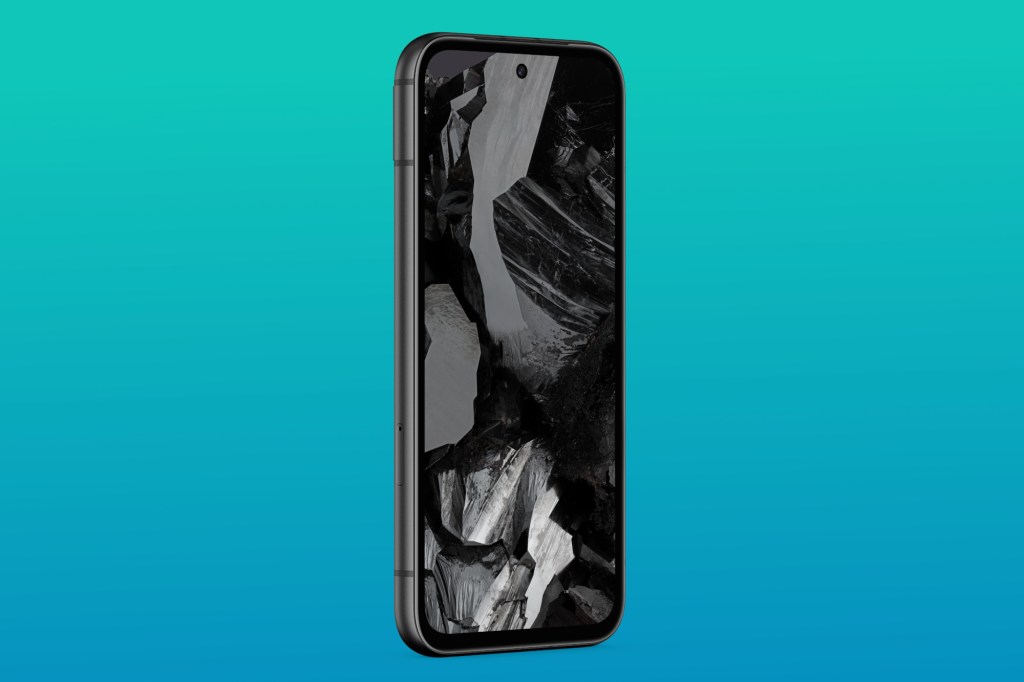
1. Google Pixel 8a
Stuff Verdict
With similar hardware to its more expensive siblings, the Pixel 8a is the cheapest way to access Google’s AI smarts. With amazing photography skills, the Pixel 8a is the mid-range smartphone to beat.
Pros
- Same superb photography skills we expect from Pixel phones
- Performance punches above its price bracket
- Slick design and strong build
Cons
- Gemini AI chatbot not available in UK and Europe
- Charging speeds remain behind rivals
| Google Pixel 7a specs | |
|---|---|
| Screen | 6.1in, 2400×1080 OLED w/ 120Hz |
| CPU | Google Tensor G3 octa-core |
| Memory | 8GB RAM |
| Cameras | 64MP, f/1.9 main w/ OIS + 13MP,f/2.2 ultrawide rear 13MP, f/2.2 front |
| Storage | 128/256GB |
| Operating system | Android 14 |
| Battery | 4,492 mAh w/ 18W wired, 7.5W wireless charging |
| Dimensions | 152.1 x 72.7 x 8.9mm, 188 g |
The Pixel 8a is part of Google’s affordable ‘A’ series, which promises a similar Pixel experience to its more expensive siblings for less money. We think this makes it a superb bang-for-buck option. And there’s lots to love here.
From its impeccable camera skills and punchy performance to a minimalist Pixel design and pure Android experience, this could be the ultimate choice for Google fans. Previous Pixel A phones had a few specs that lagged behind some of the competition, but the latest 8a has fixed that, making it unquestionably the best mid-range smartphone around.
Okay, the charging speeds remain slightly behind rivals, and not all AI features are available to buyers in the UK and Europe, but unless you’re willing to spend nearly double the money on a flagship with even more versatile cameras, the Pixel 8a is everything you’ll ever need.
- Read more: Google Pixel 8a review
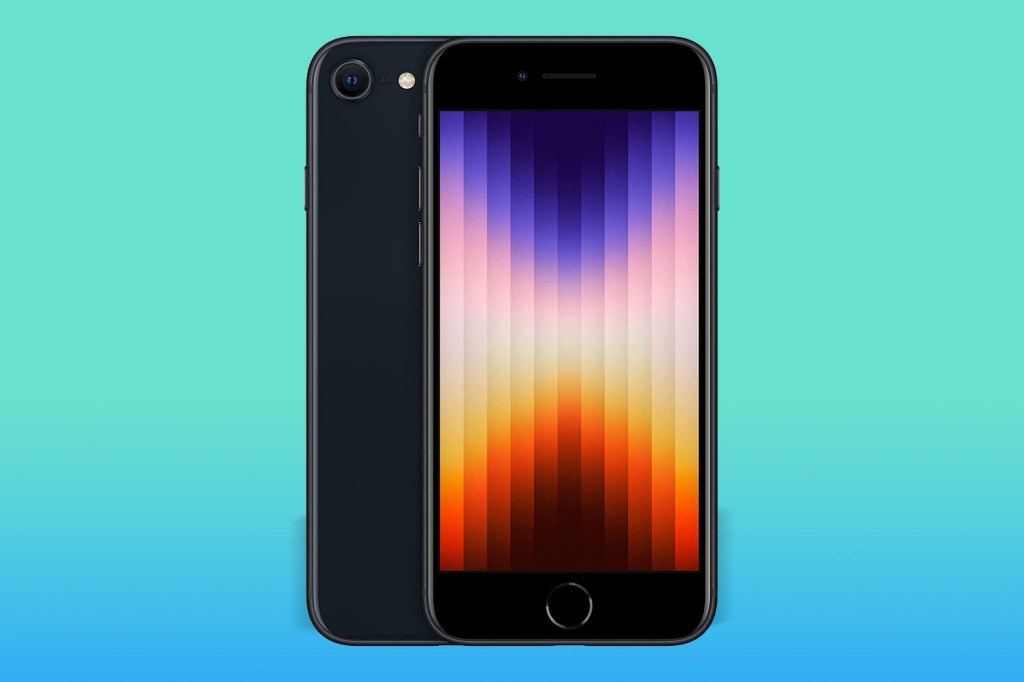
2. Apple iPhone SE (2022)
Stuff Verdict
If you’re iOS rather than Android, there’s no better option. Flagship power in a compact shell
Pros
- Familiar design
- Incredibly powerful
Cons
- No Face ID
- Display not as good as some
| Apple iPhone SE (2022) specs | |
|---|---|
| Screen | 4.7in, 750 x 1334, Retina IPS LCD |
| CPU | Apple A15 Bionic |
| Memory | 4GB RAM |
| Cameras | 12 MP, f/1.8, PDAF, OIS (rear) 7 MP, f/2.2 (front) |
| Storage | 64GB, 128GB, 256GB |
| Operating system | iOS 15 |
| Battery | 2018 mAh, 20W wired |
| Dimensions | 138.4 x 67.3 x 7.3 mm, 144 g |
The new iPhone SE (aka the iPhone SE 3, released in 2022) is one of the best-value iPhones ever made. While it looks seriously old-fashioned by today’s standards thanks to its home button and thick bezels, it more than makes up for it on the inside — despite costing less than half the price of the iPhone 13, it’s still rocking the same incredibly powerful A15 Bionic processor.
If you prefer dinkier screens for easy one-handed use, then its 4.7in LCD display (sadly not OLED) will be an absolute joy to use, banishing over-stretched thumbs for good. If you don’t mind the fact that it’s only got a single camera, smaller battery, and no Face ID smarts, then this should definitely be a consideration for Apple fans on a budget. Is it the best affordable mobile on sale? No siree – but it is the best mid-range Apple one.
- Best iPhone: every Apple phone compared
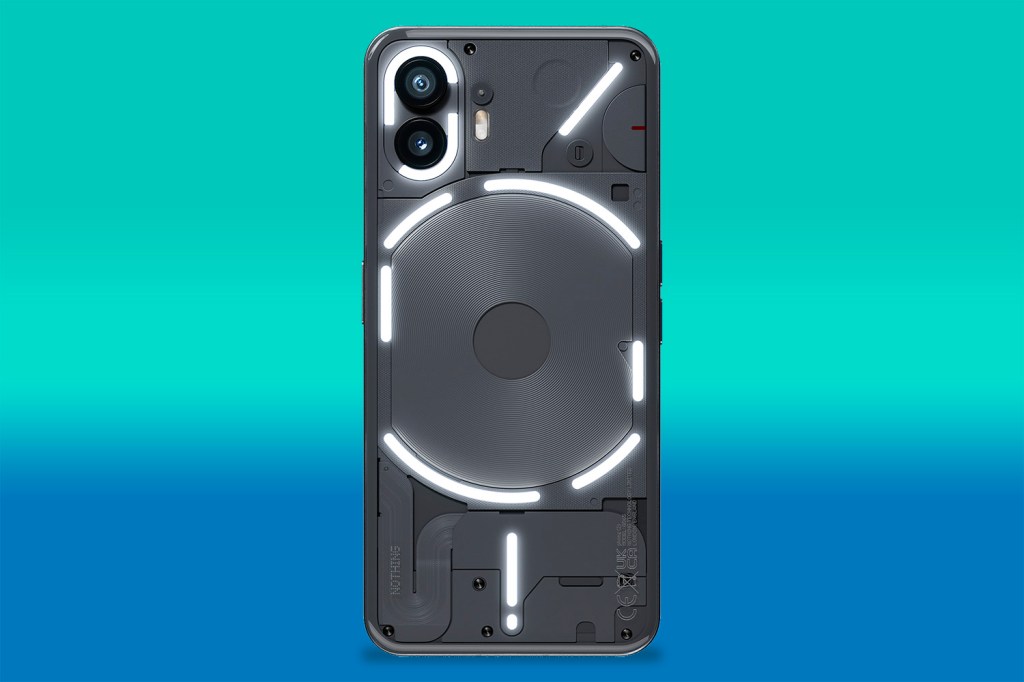
3. Nothing Phone 2
Stuff Verdict
A beautiful big-screen blower with unique style and plenty of substance. Rivals have it beat in one or two areas, but none have Phone 2’s charm.
Pros
- Refines everything that Made Phone 1 so fun
- Streamlined software puts a fresh spin on the Android home screen
Cons
- Rivals still hold the crown for photography
- Not such great value in certain territories
| Nothing Phone 2 specs | |
|---|---|
| Screen | 6.7in, 2410×1080 OLED w/ 120Hz |
| CPU | Qualcomm Snapdragon 8+ Gen 1 octa-core |
| Memory | 8/12GB RAM |
| Cameras | 50MP, f/1.9 w/ PDAF, OIS + 50MP, f/2.2 ultrawide w/autofocus rear 32MP, f/2.5 front |
| Storage | 128/256/512GB |
| Operating system | Android 13 w/ NothingOS 2.0 UI |
| Battery | 4700mAh w/ wired, wireless charging |
| Dimensions | 162x76x8.6mm, 201g |
Don’t be fooled by the see-through shell: the Nothing Phone 2 is no gimmick. Sure, the transparent design and lighting strips do plenty to catch the eye, but there’s also one of the best mid-range smartphone models on sale lurking beneath the surface.
The 6.7in OLED display punches above its weight, while the construction materials give it the feel of a more premium device. The CPU is last year’s flagship, so plenty potent: running Nothing’s minimalist take on Android 13, it operates very smoothly in day-to-day use, with no noticeable slowdowns.
Battery life is much improved over Phone 1, and while the revised rear camera hardware can’t dislodge Google as the best snapper going under £600, it still shows meaningful gains over Nothing’s debut effort. If you’re keen on a genuinely refreshing take on the affordable smartphone formula, Phone 2 should sit near the top of your list.
- Read more: Nothing Phone 2 review
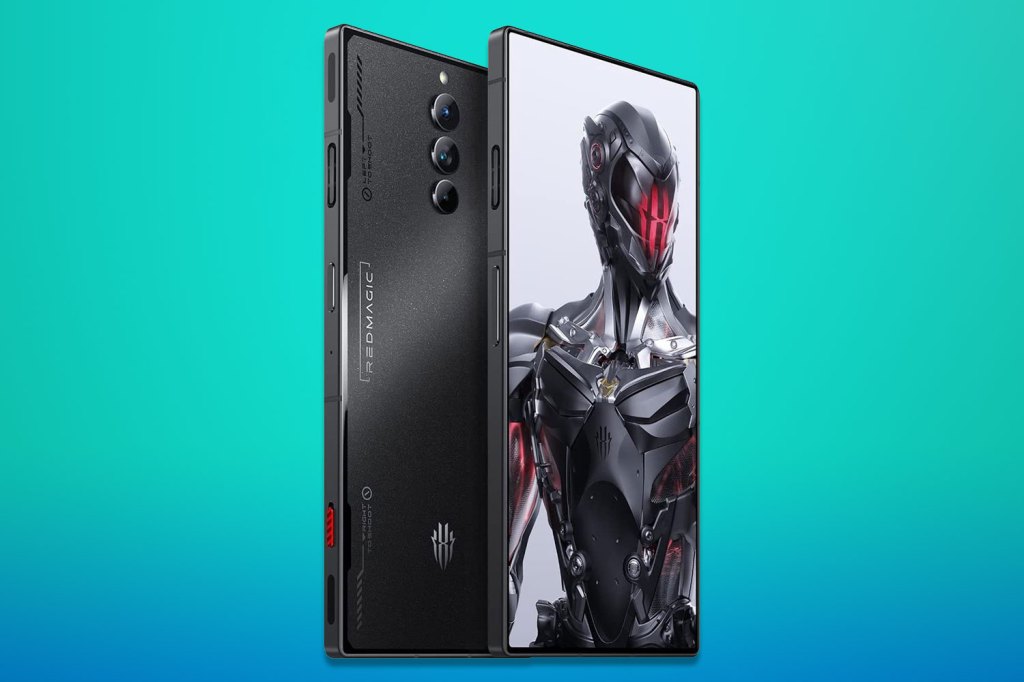
4. Red Magic 8 Pro
Stuff Verdict
Quite simply the best value gaming phone around right now, with powerful specs and not to mention a seriously geeky, fit-for-purpose UI that’s perfect for anyone who loves to game and tinker.
Pros
- Looks great for a gaming phone
- Striking uninterrupted screen
- Excellent gaming performance and internal fan
Cons
- Main camera misses out on OIS
- Occasional interface niggles
- Screen refresh rate isn’t best-in-class
| Red Magic 8 Pro specs | |
|---|---|
| Screen | 6.8in, 2480×1116 AMOLED w/ 120Hz |
| CPU | Qualcomm Snapdragon 8 Gen 2 |
| Memory | 12/16GB |
| Cameras | 50MP, f/1.8 w/ OIS + 8MP, f/2.4 ultrawide + 2MP, f/2.4 macro rear 32MP front |
| Storage | 256/512GB |
| Operating system | Android 13 w/ RedMagicOS |
| Battery | 6000mAh w/ 65W wired charging |
| Dimensions | 164x76x8.9mm, 228g |
Searching for an excellent value gaming phone? Your answer is the RedMagic 8 Pro. For a reasonable mid-range sum, you’re getting Qualcomm Snapdragon 8+ Gen 2 power and 256GB storage, along with a seriously geeky, fit-for-purpose UI that’s perfect for gamers and tinkerers alike.
We particularly loved its large, uninterrupted near-bezel-less display in our review, along with its transparent back that offers something different from the norm. And while its camera won’t deliver best-in-class performance, it’s hard to argue with its overall features at this price — making it a great choice for the overall best mid-range smartphone as well as the best mid-ranger gaming phone.
- Read more: Red Magic Pro 8 review

5. Motorola Moto G82
Stuff Verdict
It’s not the pinnacle of performance, but the G82 is more evidence that Motorola is a master of well-specced affordable mobile
Pros
- Superb screen for the cash, with high refresh rate
- Stabilised main camera takes impressively clear snaps
- Long-lasting battery
Cons
- More powerful rivals don’t cost much more
- Macro camera doesn’t add much value
- No 4K video recording
| Motorola Moto G82 specs | |
|---|---|
| Screen | 6.6in, 2400×1080 AMOLED w/ 120Hz refresh rate |
| CPU | Qualcomm Snapdragon 695 octa-core |
| Memory | 6GB RAM |
| Cameras | 50MP f/1.8 w/ PDAF, OIS + 8MP, f/2.2 ultrawide + 2MP, f/2.4 macro rear. 16MP, f/2.2 front |
| Storage | 128GB on-board, microSD |
| Operating system | Android 12 |
| Battery | 5000mAh non-removable |
| Dimensions | 161x75x8mm, 173g |
Hitting the price-performance sweet spot, the Moto G82 is a welcome reminder that Motorola knows how to nail a keenly priced all-rounder. A surefire steal of a smartphone, it packs a superb OLED panel with high refresh rates, a giant 5000mAh battery and an optically stabilised 50MP main camera – all specs you’d expect to find in handsets costing a good chunk more.
It’s not the last word in performance for the money, and you can get more power for not much more cash. But Motorola’s marvellously minimalist take on Android runs bloat-free and briskly enough, while 30W charging means a full refuel in an hour. Provided you don’t need the option to record 4K video, you’re getting a lot of smartphone here for your readies.
- Read more: Motorola Moto G82 review
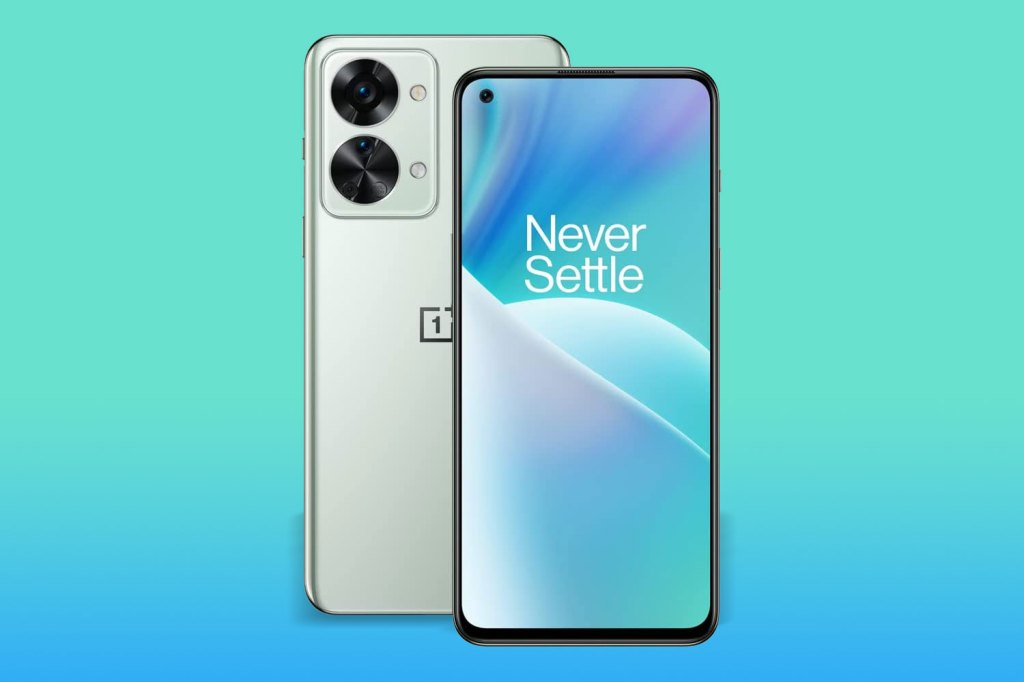
6. OnePlus Nord 2T 5G
Stuff Verdict
A neat 5G smartphone with decent specs at a tidy price: the Nord 2T is one of the best mid-range Android smartphones you can buy
Pros
- Everything is super quick
- The charging speed is brilliant
Cons
- Photo samples are mixed
- Not sure about the camera housing
| OnePlus Nord 2T 5G specs | |
|---|---|
| Screen | 6.43in 2400×1080 90Hz AMOLED |
| CPU | MediaTek Dimensity 1300 |
| Memory | 8/12GB |
| Cameras | 128/256GB |
| Storage | Android 12 with OxygenOS 12 |
| Operating system | 50+8+2MP rear, 32MP front |
| Battery | 4500mAh |
| Dimensions | 159x73x8.2mm, 190g |
The OnePlus Nord 2T 5G might have a horrifically convoluted name, but it more than makes up for it with a beautiful, premium design, bolstered by quality specs and performance in all the right places. Slathered front and back in gorilla glass, it’s available in grey or a head-turning Jade Fog finish, making it one of the best looking mid-range handsets money can buy.
Ready for super-fast 5G, it’s powered by MediaTek’s powerful Dimensity 1300 processor, which has made a name for itself as one of the best mid-range CPUs currently available. It’s got a triple-camera setup too, though its main snapper will be the one that gets the majority of the legwork done.
Throw in speedy Google, Samsung and Apple-trouncing 80W fast charging, a 90Hz AMOLED display, and a dual-SIM slot for extra flexibility, and you’ve got one of the top mid-range Android picks around.
- Read more: OnePlus Nord 2T review
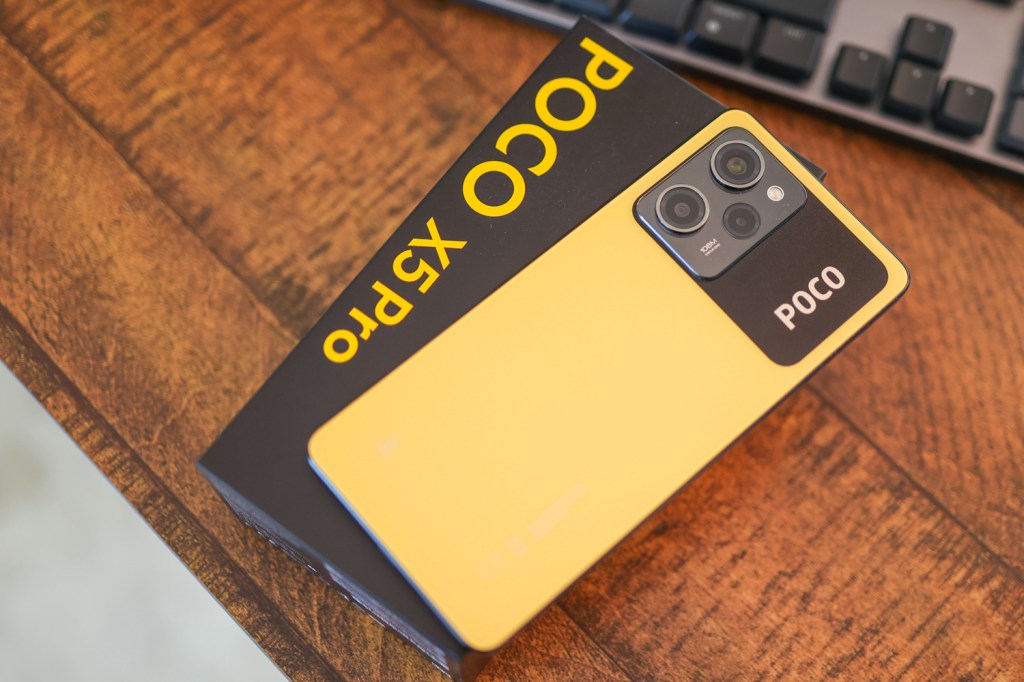
7. Poco X5 Pro
Stuff Verdict
Far from perfect, but a welcome refinement to Poco’s wallet-friendly line.
Pros
- A good screen for a midrange phone
- The main camera grabs plenty of detail
- Rapid charging & strong battery life
Cons
- Weak secondary cameras
- Textured rear feels a bit cheap
- MIUI 14 is a heavy Android skin
| Poco X5 Pro specs | |
|---|---|
| Screen | 6.67in, 2400×1080 OLED w/ 120Hz |
| CPU | Qualcomm Snapdragon 778G octa-core |
| Memory | 8/12GB RAM |
| Cameras | Camera 108MP, f/1.9 main w/ PDAF, 8MP, f/2.2 ultrawide, 2MP f/2.4 macro. 16MP, f/2.5 front |
| Storage | 128/256GB |
| Operating system | Android 12 w/ MIUI 14 |
| Battery | 5000mAh w/ 67W wired charging |
| Dimensions | 163mmx76x 7.9mm, 181g |
A better budget gaming phone than its forebear, with a UI that runs delightfully smoothly – not always a given when talking this sort of cash. The Poco X5 Pro is also thinner and lighter than the phone that came before, and brings back great battery life (and fast charging).
Adding 4K video recording is welcome, but there haven’t been too many meaningful updates to the camera hardware, so this isn’t the phone for photographers with tight purse strings.
The screen doesn’t get quite as bright as the X4 Pro, and the weird-feeling plastic back won’t be to all tastes. But ultimately it doesn’t make you feel like you’re compromising in too many areas, so find one at the right price and it’s still a good buy.
- Read more: Poco 5 Pro review
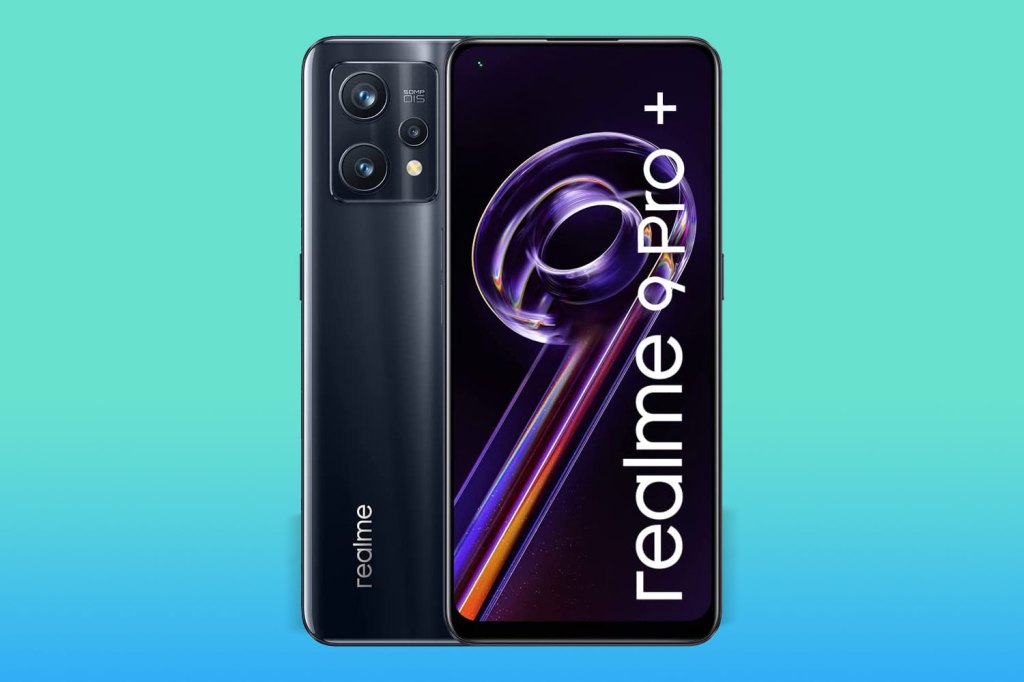
8. Realme 9 Pro+
Stuff Verdict
A killer camera makes the Realme 9 Pro+ a winner
Pros
- Best-in-class main camera
- Bright, vibrant, smooth screen
- 60W fast charging
Cons
- Poor macro camera
- No SD card slot
- No zoom camera
| Realme 9 Pro+ specs | |
|---|---|
| Screen | 6.43-inch 90Hz OLED |
| CPU | MediaTek Dimensity 920 5G |
| Memory | 8GB |
| Cameras | 50MP primary (f/1.8), 8MP ultra-wide (f/2.2), 2MP Macro (f/2.4) rear, 16MP (f/2.4) front |
| Storage | 256GB |
| Operating system | Android 12 |
| Battery | 4500mAh, 60W Super DART fast charging |
| Dimensions | 160.2 x 73.3 x 8 mm, 182 g |
The Realme 9 Pro+ might just be the best overall choice for most people searching for the best mid-range smartphone (unless, of course, you’re after an iPhone).
Its primary selling points are a 90Hz OLED display, and a best-in-class main camera that genuinely goes toe to toe with premium flagships come day or night. It can even shoot HEIF 10-bit photos like the iPhone 13 Pro, for smoother gradients and colours for enthusiasts to work their editing magic. Its digital zoom isn’t too shabby either, and the same goes for its 8MP ultra-wide snapper.
As usual, the third macro camera isn’t really worth using more than a few times for experimentation, but given the imaging quality elsewhere, that’s fine by us. Powerful enough for smooth gaming with 60W charging thrown in for good measure, this is one of the best mid-range handsets currently available, at a borderline budget price tag.
- Read more: Realme 9 Pro+ review
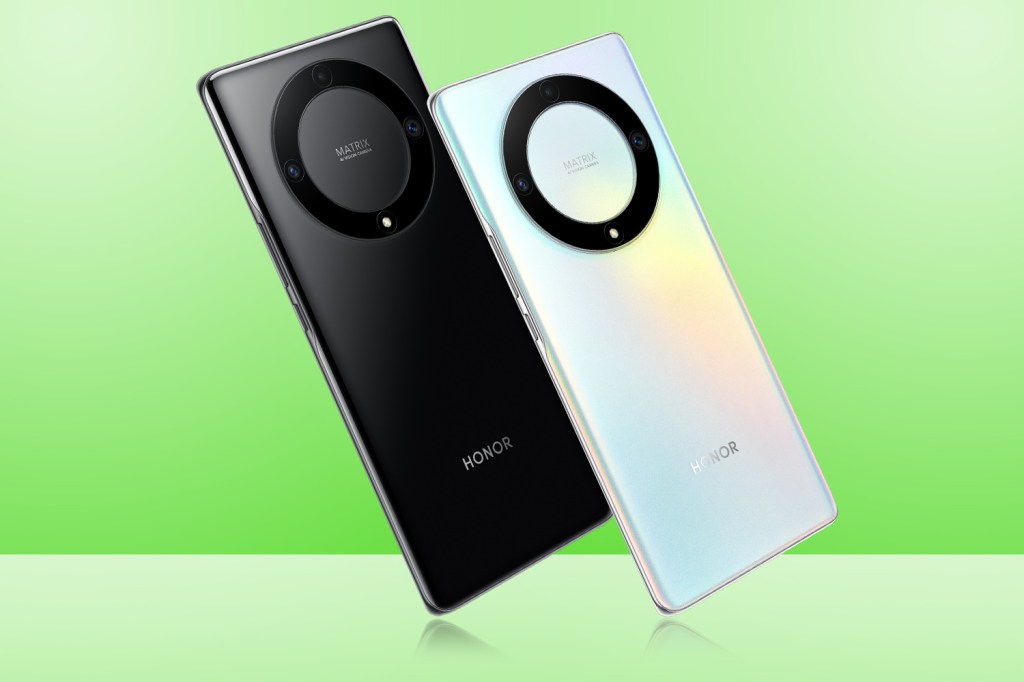
9. Honor Magic 5 Lite
Stuff Verdict
A keenly-priced mid-ranger with sharp looks, a quality screen and stellar battery life – although mobile photographers have better options for similar cash.
Pros
- Stylish looks and quality display
- Great battery life
- Main camera a decent enough performer
Cons
- Secondary cameras a weak link
- Outperformed by similarly-priced rivals
| Honor Magic 5 Lite specs | |
|---|---|
| Screen | 6.67in, 2400×1080 OLED w/ 120Hz |
| CPU | Qualcomm Snapdragon 695 octa-core |
| Memory | 6GB RAM |
| Cameras | 64MP w/ PDAF + 5MP ultrawide + 2MP macro rear 16MP front |
| Storage | 128GB |
| Operating system | Android 12 w/ MagicUI 6.1 |
| Battery | 5100mAh w/ 40W wired charging |
| Dimensions | 162x74x7.9mm, 175g |
One of those phones for people who spend more time in Google Chrome than Call of Duty, the Honor Magic 5 Lite is a great-looking handset that sticks with a modestly mid-range CPU in order to go big in other areas, like its screen. A 6.67in AMOLED is a treat for the eyes, especially at 120Hz, and the 5100mAh battery is capable of excellent longevity away from the mains.
While its secondary snappers don’t add a whole lot of value, the main sensor does a decent job of justifying the price. The super slim dimensions, glass rear and choice of head-turning colours are what give the Magic 5 Lite its strongest appeal, so if you like your tech to make a design statement, it’s a great choice.
- Read more: Honor Magic 5 Lite review
How to choose the best mid-range smartphone for you
Choosing the best mid-range smartphone is a lot like choosing the best smartphone, but if you’re reading this then you’ve already defined a budget of between $450/£450 and $650/£650. If that’s still too much money, then you should check out Stuff’s guide to the best cheap smartphones.
These affordable mobiles tend to offer a good balance between features and affordability. You may miss out on some headline features, such as a super-zoom camera or massive OLED display, but if you want a phone that’s brilliant at the basics without anything flashy, then these are perfect for you.
As we mentioned in the introduction as well, performance shouldn’t be an issue, with mid-range processors from reputable brands like Qualcomm Snapdragon and MediaTek performing much better than they used to.
In terms of display, you should be looking for smartphones with at least Full HD (1080p) resolution and an IPS or AMOLED panel for vibrant colours and good viewing angles.
Despite being mid-range, you can expect a decent camera with multiple lenses and sensors (although, it may not be market-leading). You can look for features like optical image stabilization (OIS) or night mode.
If you’re looking for more specific buying recommendations, then you can check out Stuff’s guides to the best smartphone for gaming, the best smartphones for photography, and the best Android phones.
How we test the best mid-range smartphones
We have used and reviewed every phone on this list, so you can trust us when it comes to recommending the best mid-range smartphone to buy.
We usually spend a week or longer reviewing phones, testing out all of the software features, build quality and performance. Our reviews are very comprehensive, testing every single aspect of a smartphone, including battery life, quality of the display, and camera.
For more information on Stuff’s rating and review process, read our page on how we test products.
A VPN can help you surf safely and anonymously whether you’re watching sports or streaming on Netflix and other services.
What’s the best free VPN service?

1. Proton VPN Free
Stuff Verdict
Proton’s free VPN service is one of the best around, with no data limits!
Pros
- Unlimited data
- Fast speeds
Cons
- Only three locations on offer
| Proton VPN Free specs | |
|---|---|
| Data limit | Unlimited |
| Countries | 3 |
| Connections | 1 |
We think Proton’s free VPN service is one of the best around. One of its biggest selling points is the fact that it has no data limits, which means you never have to worry about hitting any pesky caps. Despite being free, it also offers key features like a kill switch (your connection drops if the VPN service goes down so you’re not left unprotected), and the superior WireGuard VPN protocol.
Obviously, you’re going to have some limitations. In this instance, you only have access to three locations — the USA, Netherlands and Japan. And while you can install Proton VPN on as many devices as you like, you can only connect to one at a time if you’re using the free package. Still, considering it’s one of the fastest VPN services around (even on the free tier), there’s very little to complain about here, as long as the limited country choice doesn’t affect your specific use case.

2. PrivadoVPN Free
Stuff Verdict
A generous choice of thirteen locations to choose from, with a decent data limit
Pros
- Generous choice of locations
- Fast speeds
Cons
- Data not unlimited
| PrivadoVPN Free specs | |
|---|---|
| Data limit | 10GB (then unlimited at 1Mbps) |
| Countries | 9 |
| Connections | 1 |
While PrivadoVPN can’t match Proton VPN’s unlimited data allowance, it still offers a respectable 10GB monthly limit. We find this should be enough for more casual use on, say, a smartphone, but even if you do reach the maximum amount, you can still use an emergency server to get online. Sure, the latter is limited solely to the Netherlands with a crawling speed of just 1Mbps, but it’s better than nothing.
When you’re within the data limit, you have a generous choice of thirteen locations to choose from, with speedy 350Mbps connectivity to boot. The best part, though, is the fact that you can use the free version to unblock streaming services, including Netflix USA, Prime Video, Disney+, and more.
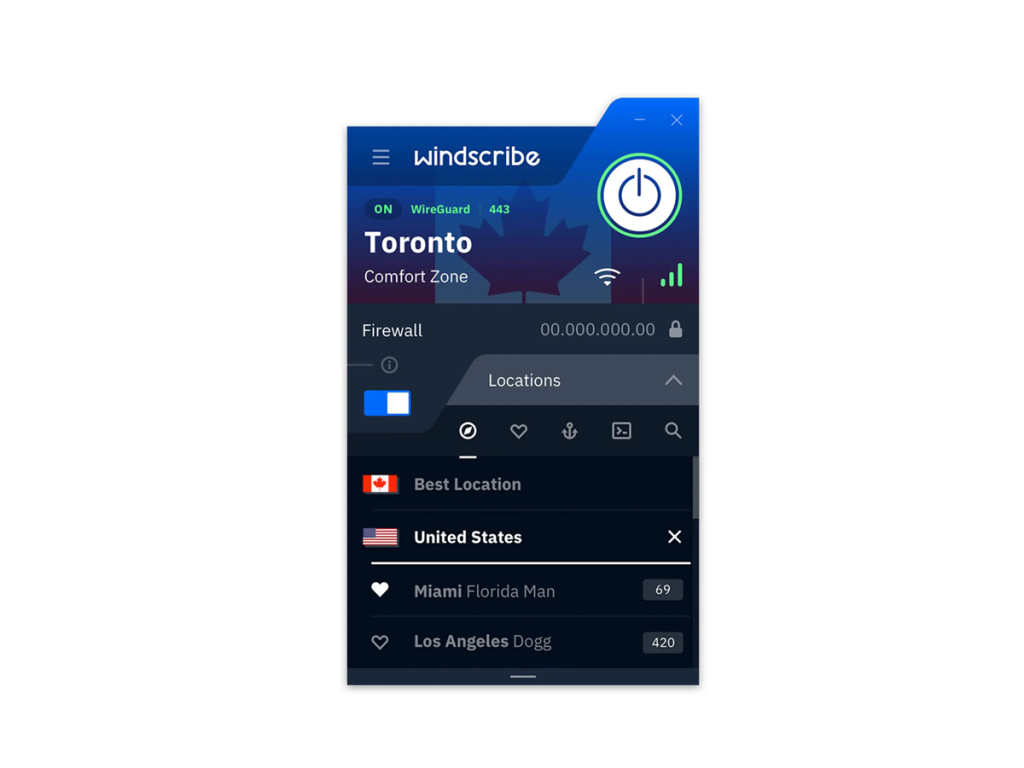
3. Windscribe Free
Stuff Verdict
Got lots of devices? This free VPN offers unlimited connections
Pros
- Unlimited simultaneous connections
- Extra features
Cons
- Slower than some rivals
| Windscribe Free specs | |
|---|---|
| Data limit | 10GB |
| Countries | 11 |
| Connections | Unlimited |
Windscribe stands out from the crowd in a few key areas. While it has the common 10GB monthly cap, you can install and use it on more than one device, which is a feature that many other free alternatives lack. We appreciate that you have the choice of 11 different countries as well, which is more generous than most.
Overall, it’s definitely worth considering — especially if you’re after light use across different devices like phones and tablets. Just be wary of that strict 10GB cap, and you’ll be good to go.

4. Atlas VPN Free
Stuff Verdict
This is the best free VPN for Mac users, with a generous 2GB limit per day
Pros
- Decent speeds
- Reasonable data allowance
Cons
- Basic features compared to some rivals
| Atlas VPN Free specs | |
|---|---|
| Data limit | 10GB (2GB/day on Mac) |
| Countries | 2 |
| Connections | 2 |
While its 10GB monthly data allowance is decent enough, its Atlas VPNs Mac-specific allowance that really shines. If you’re a Mac user, like us, you can take advantage of a whopping 2GB per day, making Atlas VPN one of the most competitive free VPNs around.
There are, of course, some catches — namely the limit to just two countries (the Netherlands and the USA). Still, you can connect two devices simultaneously, and the speeds are far from shabby. While streaming site unblocking isn’t officially supported, some people have tried their luck and found success, so it could be worth a shot. Not that we condone that, mind.

5. Hotspot Shield Basic VPN
Stuff Verdict
Unlimited data and fast speeds, but only a single US-based location is offered
Pros
- Unlimited data
- Fast speeds
Cons
- Only offers a single US-based location
| Hotspot Shield Basic VPN specs | |
|---|---|
| Data limit | Unlimited |
| Countries | 1 |
| Connections | 1 |
Hotspot Shield’s free VPN service offers an unmatched unlimited data limit, letting you stream and surf to your heart’s content. There’s one major catch though — you can only connect via one USA-based location, which might be a dealbreaker for some users, depending on their needs.
If that’s not an issue for you though, then it’s hard to beat that glorious unlimited data allowance. If you can also live without a kill switch, then we think this is one of the best free VPN services.
Best VPN FAQs:
What is a free VPN?
A virtual private network (commonly referred to as VPN), is a powerful tool that enables you to cloak your whereabouts on the web. VPNs work by directing your online traffic through the servers of the VPN provider, which are often located in various parts of the world.
You could, for example, use a VPN service to simulate your presence in the USA, letting you access Netflix content that may not be available in the United Kingdom. While we don’t officially endorse such usage, this is just one example of a common VPN use case.
Additionally, for individuals travelling to certain regions such as China (where access to popular social media platforms like Facebook, Instagram, and Google are restricted), VPNs become indispensable tools, letting you use your preferred apps while helping you stay in touch with people back home.
Are free VPNs safe?
The safety of free VPNs is a significant concern, and the answer isn’t straightforward because it varies based on the provider.
Many free VPN services log user data and may sell this information to third parties. This practice can compromise your privacy, which is the opposite of what a VPN should do.
Free VPNs might not have strong encryption protocols, leaving your data vulnerable to interception.
To generate revenue, many free VPNs display intrusive ads and pop-ups. These ads can be annoying and, in some cases, may lead to malicious websites.
You may also find that free VPN providers may not have the resources or motivation to maintain robust security measures or provide customer support. This lack of accountability can result in a poor and potentially unsafe user experience.
To avoid these potential free VPN pitfalls, read the section below on how to choose the best free VPN, as well as our reviews above.
How to choose the best free VPN
If you’re worried about choosing a free VPN, then follow these steps:
First, you’ll want to look for reviews (like ours above) from reputable sources and user feedback. Investigate whether the VPN provider has a history of privacy violations or security issues.
You will probably also want to read the privacy policy carefully to understand what data the VPN logs and how it is used. A trustworthy VPN should have a clear and transparent privacy policy.
Some well-known, trusted VPN providers (like the ones included Stuff’s best VPN guide) offer limited free versions of their paid services. These options might be safer as they often use the same infrastructure and security protocols as their premium counterparts.
Finally, consider why you actually need a VPN. For basic tasks like bypassing geo-restrictions or casual browsing, some free VPNs might suffice, but for more critical activities, such as handling sensitive information, investing in a reputable paid VPN service is advisable.
Are VPNs illegal?
VPNs are absolutely not illegal (although there are some exceptions in certain countries so it’s always worth checking), and there’s nothing wrong with wanting to anonymise your personal data and internet activity. Still, this doesn’t give you a blanket excuse to then carry out illegal activity, such as the downloading of copyrighted material. This also means that you shouldn’t use a VPN to bypass per-country streaming rights for services such as Netflix.
Can VPNs protect you from viruses and malware?
Short answer? No. Using a VPN to browse anonymously is one thing, but you’re still susceptible to malware and viruses. Stay away from dodgy sites, and practice your usual (hopefully alert) levels of internet safety. In other words, don’t go downloading .exe files willy-nilly.
Will using a VPN make your internet slower?
Any VPN will have the unfortunate effect of slowing down your internet connection, which makes total sense when you think about the extra steps your traffic is taking when passing through various server locations. Still, if you’ve got a reasonably fast internet connection already, then you shouldn’t notice too much of a difference.
Are paid VPNs better than free VPNs?
Paid VPNs will offer more services in exchange for your cash. In most cases, this means that you have a larger selection of countries and locations to choose from, with more supported devices to boot. If you’re planning on light usage though, then one of the best free VPNs should be enough for your needs.
What to watch with a VPN
Want to watch the NBA from outside your own country? You can, with the help of a VPN and our series of ‘how to’ guides. We’ve covered how you can watch NBA, MBL, the Bundesliga and more, wherever you are in the world. Want to know more? Take a look on the links below:
How we test the best VPNs
Where possible, we’ve included VPN services that we’ve personally used ourselves over the years. Elsewhere, we’ve carried out in-depth research into each VPN service selected, cross-referenced against user reviews, company reputation, and other sources of expertise, such as the VPN selections and reviews at security.org.
And if you’ve got a blockbuster budget, there’s no shortage of classy gear to transform your movie room. Need help to pick the right panel for your pad? We’ve tested a battalion of big-screen TVs to bring you the best 4K TVs fit for every budget (need to upgrade your audio? Check out the best soundbar too)
What’s the best 4K TV in the UK?
The Hisense A6BG (buy now) offers a large 65in 4K screen, decent picture, and Alexa/Google Assistant support? At this price? Officially a bargain, especially if you’re not fussed about HDMI 2.1 ports (which it lacks).
The Samsung S95B OLED (buy now) offers stunning performance and picture quality. It wasn’t long ago that OLED performance used to require a second mortgage, so this feels like a great deal.
The Sony XR-55A95K (buy now) combines the brightness of QD-OLED, accurate colours, natural tones, and slick gaming performance, this is one of the best TVs that money can buy, with a price tag to match.
The LG C2 (buy now), specifically the 42in variant, is an incredible double-duty screen, capable of acting as a superb PC gaming monitor, with plenty of real estate for punchy media performance too.
The TCL 5-Series (buy now) is a 4K TV at a more affordable price, with flagship-matching connectivity and video/audio standard support? What’s not to love?
The best cheap 4K TVs:
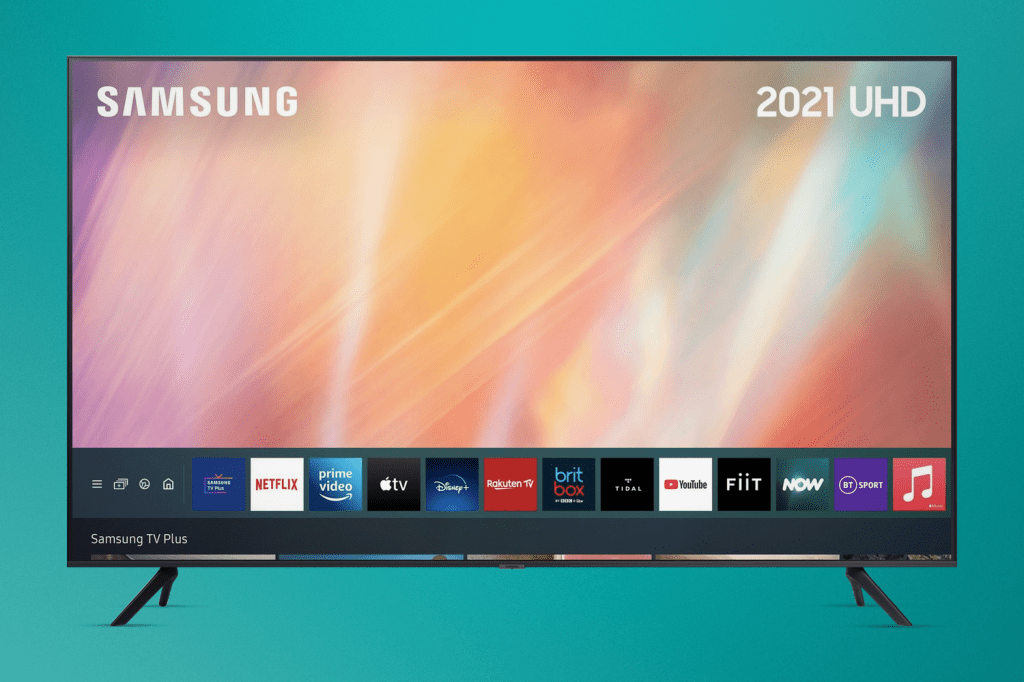
1. Samsung UE43AU71000
Stuff Verdict
An almost ideal compromise between performance and price
Pros
- Accomplished 4K images
- Predictably impressive smart TV interface
Cons
- No Dolby Vision HDR
- Upscaling has its limits
| Samsung UE43AU71000 specs | |
|---|---|
| Display | 43in 3840×2160 LCD/LED |
| Supported formats | HLG, HDR10+ |
| UI | Tizen |
| Connectivity | 3x HDMI, CI, USB, RF, Ethernet, Wi-Fi, Bluetooth 4.2 |
When we go shopping for a new TV, few of us are looking for a flagship model. Buying an entry-level box? Samsung’s AU7100 doesn’t require you to make too many sacrifices.
With detailed, vibrant images, a solid build and a slick interface, the AU7100 represents excellent value – especially if you opt for the 43in version. Its materials might not be the most indulgent, but the AU7100 is flawlessly finished and built to last.
Front and centre is an LCD/LED panel with edge-positioned backlighting. It works best with native 4K content, serving up detailed, realistic images with nuanced tones – especially when there’s HDR10+ dynamic metadata involved. Motion is handled confidently, too. Things only really deteriorate when you drop below 1080p.
Sound from the 20W drivers is better than you might expect, although there’s no low-end punch. As long as you don’t watch lots of vintage content – and you’re not expecting the quality of the audio to match the quality of the pictures – this is one of the best ‘real world’ TVs around.
- Read more: Samsung UE43AU71000 review
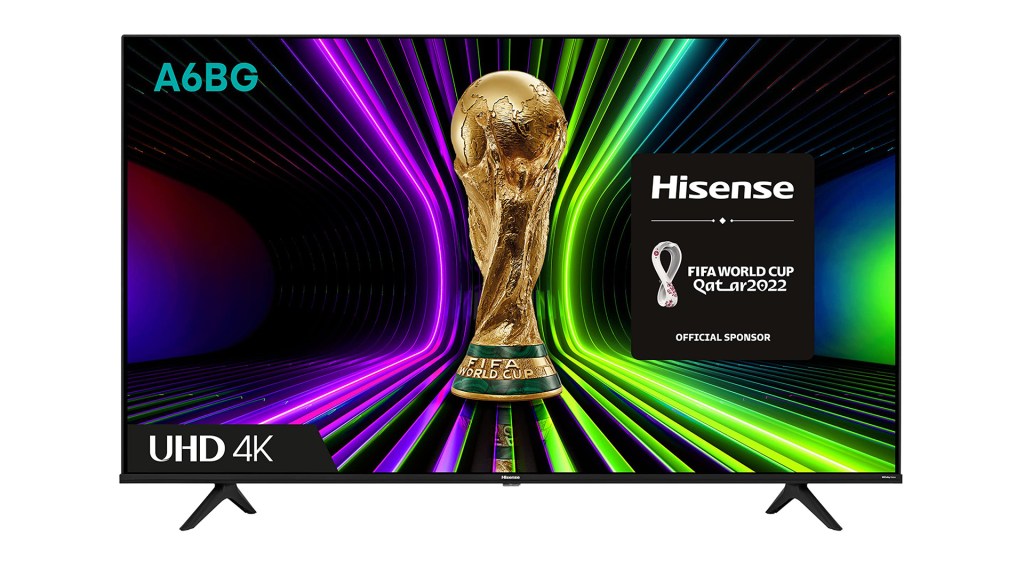
2. Hisense A6BG
Stuff Verdict
This isn’t the highest-spec TV at this price, but it’s a big bargain.
Pros
- Attractive design
- Super affordable price
Cons
- 2.0 HDMI ports
- Limited viewing angles
| Hisense A6BG specs | |
|---|---|
| Display | 43/50in 3840×3160 VA LCD |
| Supported formats | HDR, HLG, Dolby Vision |
| UI | VIDAA |
| Connectivity | 3 x HDMI, 2 x USB, Ethernet, Optical, Wi-Fi, Bluetooth |
Hisense knows its stuff when it comes to delivering very good entry-level TVs, and this large 65in offering is an absolute bargain at this price. Serving up 4K resolution with HDR (including Dolby Vision support), there’s also an auto low latency mode for gamers, along with built-in Freeview HD. Oh, and it works with Google Assistant and Amazon Alexa too.
Naturally, given its price, there are a few compromises. The HDMI ports are 2.0, not 2.1, for starters, and the screen itself had fairly limited viewing angles and can struggle with darker scenes. But there’s a comprehensive selection of streaming apps on offer, and again, there’s not much to complain about at this price.
The perfect choice if you’re looking for something simple, straightforward, and really rather massive.
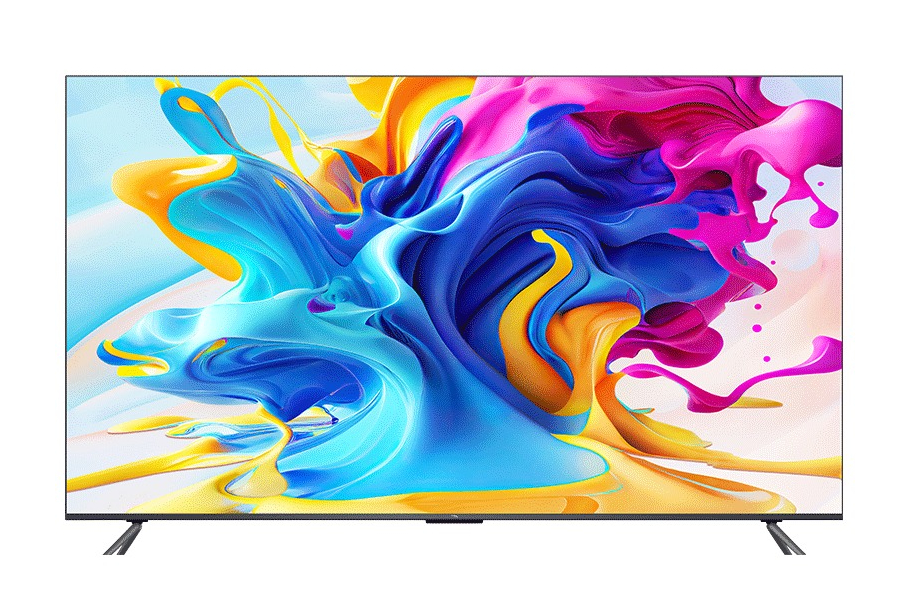
3. TCL 55C645
Stuff Verdict
Keep your expectations realistic and there’s plenty to like about the TCL 55C645, especially if you don’t really listen to it all that much
Pros
- Impressive specification at the money
- Stable, colourful images
Cons
- Pictures lack brightness and contrast
- Smart TV can take a while to do its thing
| Hisense A6BG specs | |
|---|---|
| Display | 43, 50, 55 (version tested), 65, 75, 85in, 3840×2160 |
| Supported formats | HDR10+, Dolby Vision, HLG |
| UI | Google TV |
| Connectivity | 1x HDMI 2.1, 2x HDMI 2.0, 1x USB 3.0, digital optical audio, Wi-Fi, Bluetooth |
The TCL 55C645 gives us 90 percent of the performance we want for a lot less than 90 percent of the price. It’s got the technology, the functionality and the specification of a TV costing three or four times its asking price.
In terms of actual performance, the TCL 55C645 is pretty decent. The colour palette is quite extensive and the colour balance is naturalistic, it manages to keep a solid grip on on-screen movement of all kinds, and, although not an especially bright TV, the white tones it generates are clean and every bit as varied as its black tones
Now of course, you can’t expect perfection when you’re shopping at the entry-level – and sure enough, the TCL 55C645 isn’t perfect, but it gets way more right than it gets wrong, though, and in many ways, it outperforms its asking price to a significant degree.
- Read more: TCL 55C645 review
The best mid-range 4K TVs:
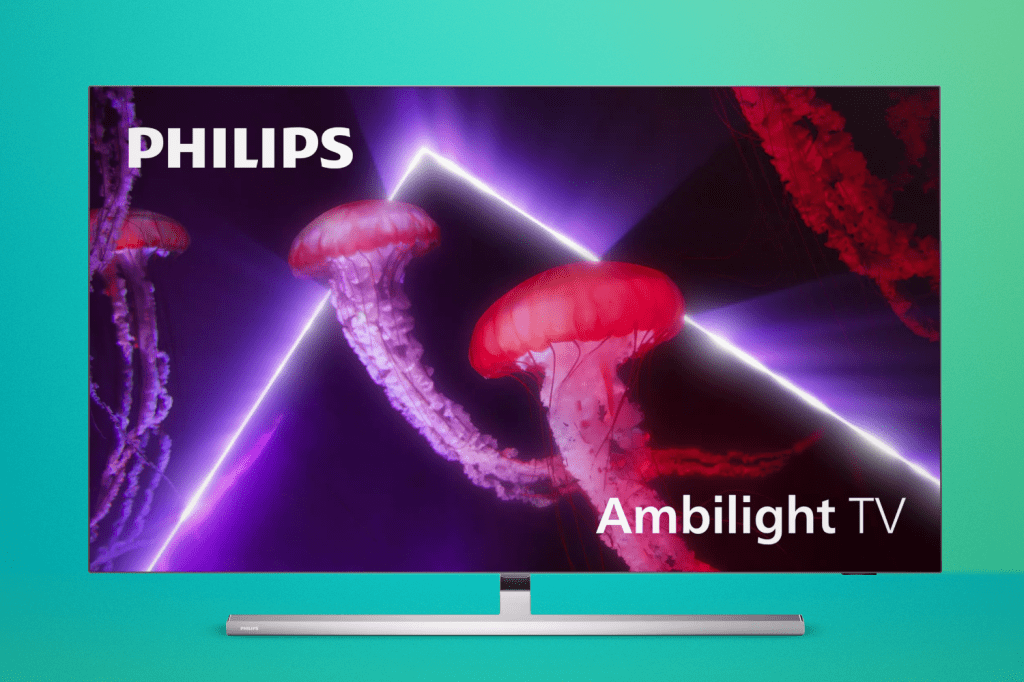
1. Philips 55OLED807
Stuff Verdict
A new benchmark for mid-range OLED performance, the 55OLED807 is competitive in every respect – not least its profoundly impressive 4K HDR images
Pros
- Great picture quality in almost every circumstance
- Competitive build, finish and specification
- Ambilight is always worth having
Cons
- Interminable set-up menus
- Sounds a bit hesitant in the upper register
| Philips 55OLED807 specs | |
|---|---|
| Display | 55in 3840×2160 OLED |
| Supported formats | HDR10, HDR10+ Adaptive, HLG, Dolby Vision |
| UI | Android TV 11 |
| Connectivity | 4x HDMI, 3x USB, Wi-Fi, Bluetooth 5.0, CI+, Optical, Ethernet, Headphone, Satellite |
Philips has established itself as a hero of the 4K TV sweet spot, delivering great sets where affordability meets performance. And the 55OLED807 knocks it out of the park again. Nicely designed and robustly built, it shows no signs of corner cutting. Philips has even added some swivel adjustment for easier positioning.
Its feature set doesn’t come up short, either. The 55OLED807 works with every mainstream HDR standard and offers a stack of inputs, including a pair of HDMI 2.1 ports for next-gen console compatibility. Four-sided Ambilight also remains a perfect complement to pictures. We still found setup menus complex and relentless in testing, but the remote at least made it easier to battle through. And the reward is great picture quality in almost every circumstance.
Peak brightness is right up there with the best OLED panels, resulting in incredible contrast, with both white and black tones packed with detail. The colour palette is extensive yet natural, too. Spend time tweaking and you can also achieve smooth, expertly rendered motion. Upscaling is similarly effective and even the 2.1-channel sound system is pretty composed for the set’s size. In short, this is one of the best pound-for-pound TVs around right now.
- Read more: Philips 55OLED807 review
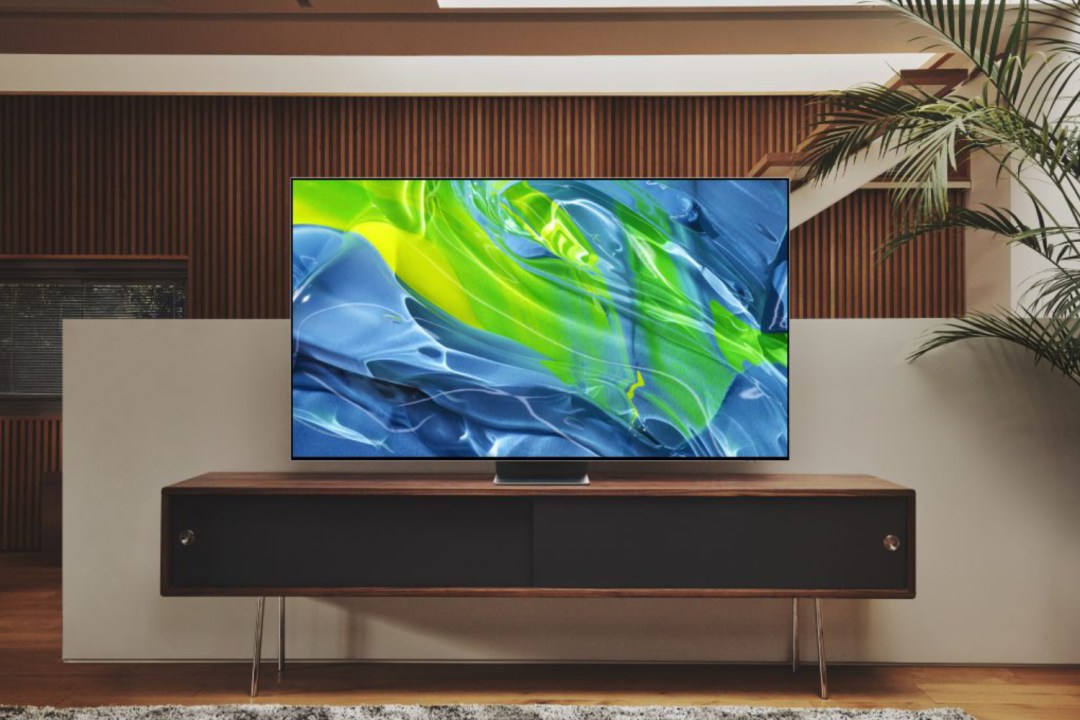
2. Samsung S95B OLED
Stuff Verdict
You’ll find a rather impressive picture with vibrant colours and the best brightness on an OLED telly… but you’ll have to fiddle around to get there.
Pros
- The brightest OLED we’ve seen
- Vibrant colours, with smartphone calibration
- A beautifully slim design
Cons
- Sluggish software that slows you down
- Picture settings need tweaking for brightness
| Samsung S95B OLED specs | |
|---|---|
| Display | 55in 3840×2160 OLED |
| Supported formats | HDR, HDR10+, HLG |
| UI | Tizen OS |
| Connectivity | 4x HDMI, 2x USB, Ethernet, optical, Wi-Fi, Bluetooth |
Samsung’s S95B is incredibly bright for an OLED, although not as bright as any QLED (which is to be expected. Still, it’s bright enough, and colours are beautifully vivid, if not the most realistic. If you’re a stickler for colour accuracy without any tweaking, then you might want to look elsewhere. Most people though, seem to like punchy, saturated colours, and if you’re one of them, then all the more power to you.
Another thing to bear in mind, are the size options available. The S95B has two models: 55in and 65in. If size is key, and you’re after something bigger (or smaller), then you might want to look elsewhere. If it ticks all your boxes though, then you definitely won’t be disappointed.
- Read more: Samsung S95B OLED review
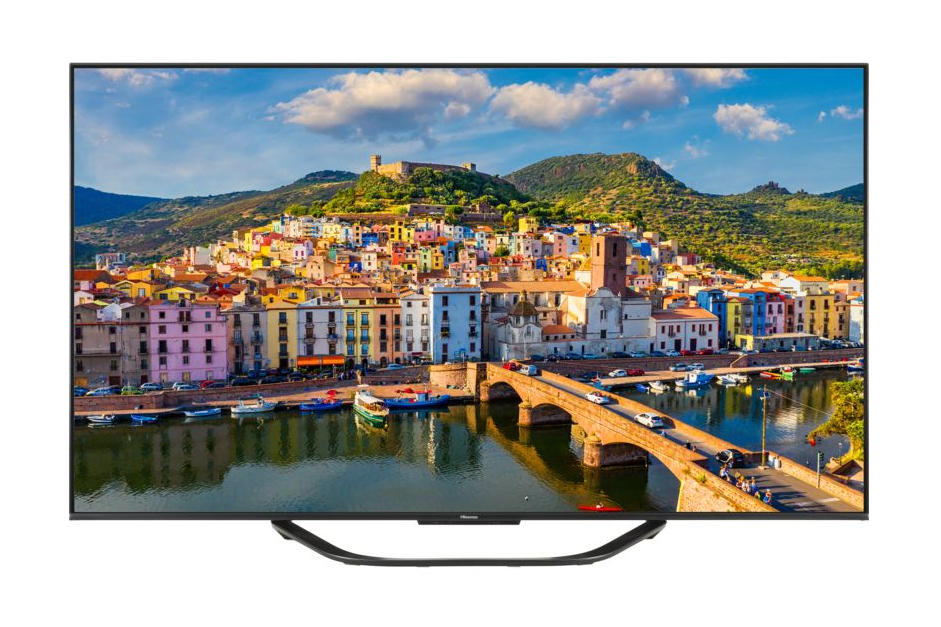
Hisense 65U7KQTUK
Stuff Verdict
Thought your budget wouldn’t stretch to a big, well-specced TV with all the trimmings? Think again…
Pros
- Mighty specification
- Vibrant, high-contrast and convincing images
- Good smart TV features
Cons
- Audio isn’t up to much
- Has definite upscaling limits
| Hisense 65U7KQTUK specs | |
|---|---|
| Display | 4K Ultra HD 3840 x 2160p Mini-LED |
| Supported formats | Dolby Vision IQ, HDR10+, HDR10, Hybrid Log Gamma (HLG) |
| UI | VIDAA |
| Connectivity | 2x HDMI 2.1 (1 x eARC), 2 x HDMI 2.0, Composite, USB 2.0, USB 3.0, Wi-Fi, Bluetooth |
Audio or video, it doesn’t matter; you can rely on Hisense to take any expensive new tech and democratise it. Can you think of another TV brand able to combine quantum dot panel technology with MiniLED backlighting and every worthwhile HDR standard in a TV, and then charge less than £1500 for a 65in version? There’s only one brand that can offer that – Hisense.
Treat it to some native 4K content, ideally with an HDR element to it for good measure, and the 65U7KQTUK really impresses. An HDR10-equipped UHD Blu-ray of Christopher Nolan’s borderline-incoherent Tenet, for example, looks an absolute treat.
For an LCD TV, the 65U7KQTUK does really well with black tones, the colour palette is extensive, and it does good work controlling on-screen movement.
A big screen with a big specification but not all that big a price – and given the right stuff to work with, the Hisense 65U7KQTUK turns in a pretty big performance. At least as far as picture quality is concerned, anyway…
- Read more: Hisense 65U7KQTUK review
The best premium 4K TVs:
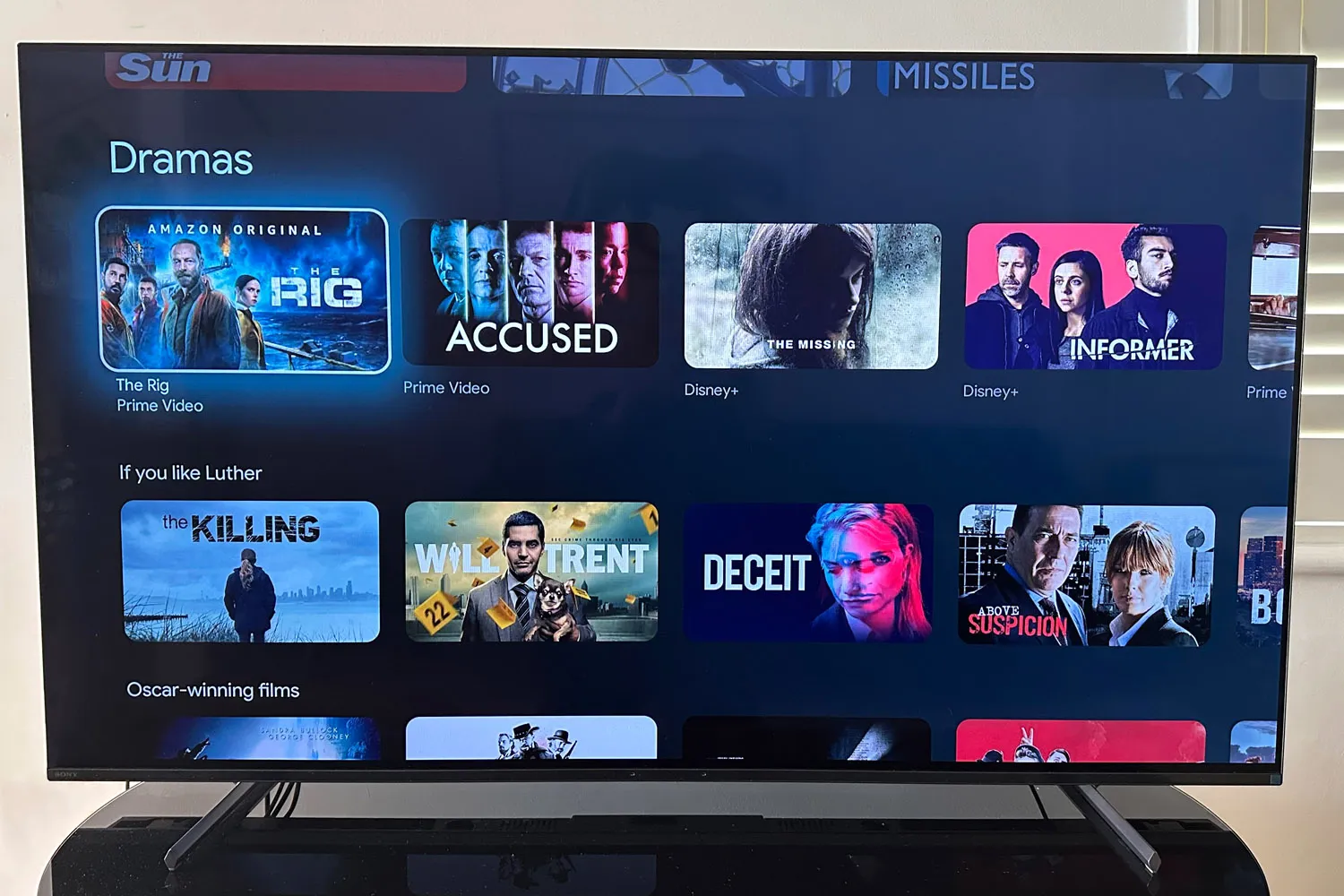
1. Sony XR-55A80L
Stuff Verdict
Sometimes ‘the current thing done really well’ is just as good as ‘the brand-new thing’. This is one of those times
Pros
- Excellent across-the-board picture quality
- Good gaming support
Cons
- Just two HDMI 2.1 sockets
- Not the most wall-hangable design
| Sony XR-55A80L specs | |
|---|---|
| Display | 48in 3840×2160 OLED |
| Supported formats | HDR10, HLG, Dolby Vision |
| UI | Google TV |
| Connectivity | 4x HDMI, 2x USB, Ethernet, Wi-Fi, Bluetooth, Airplay |
In short, the Sony XR-55A80L is a great TV. Subtle, and vibrant, it makes the very best of any content you feed into it. No, it’s not the brightest OLED panel around, but the white tones it creates are clean, and there’s detail and nuance in spades — especially when it comes to accurate colour tones such as those found on skin.
HDR performance is solid, as is motion control, with smooth edge definition too. Combined, all of these attributes result in a beautiful, pleasant viewing experience, bolstered by strong upscaling performance and slick gaming capabilities. You’ll want to upgrade the sound with speakers or a soundbar though, as is the case for most of the picks on our list.
- Read more: Sony XR-55A80L review
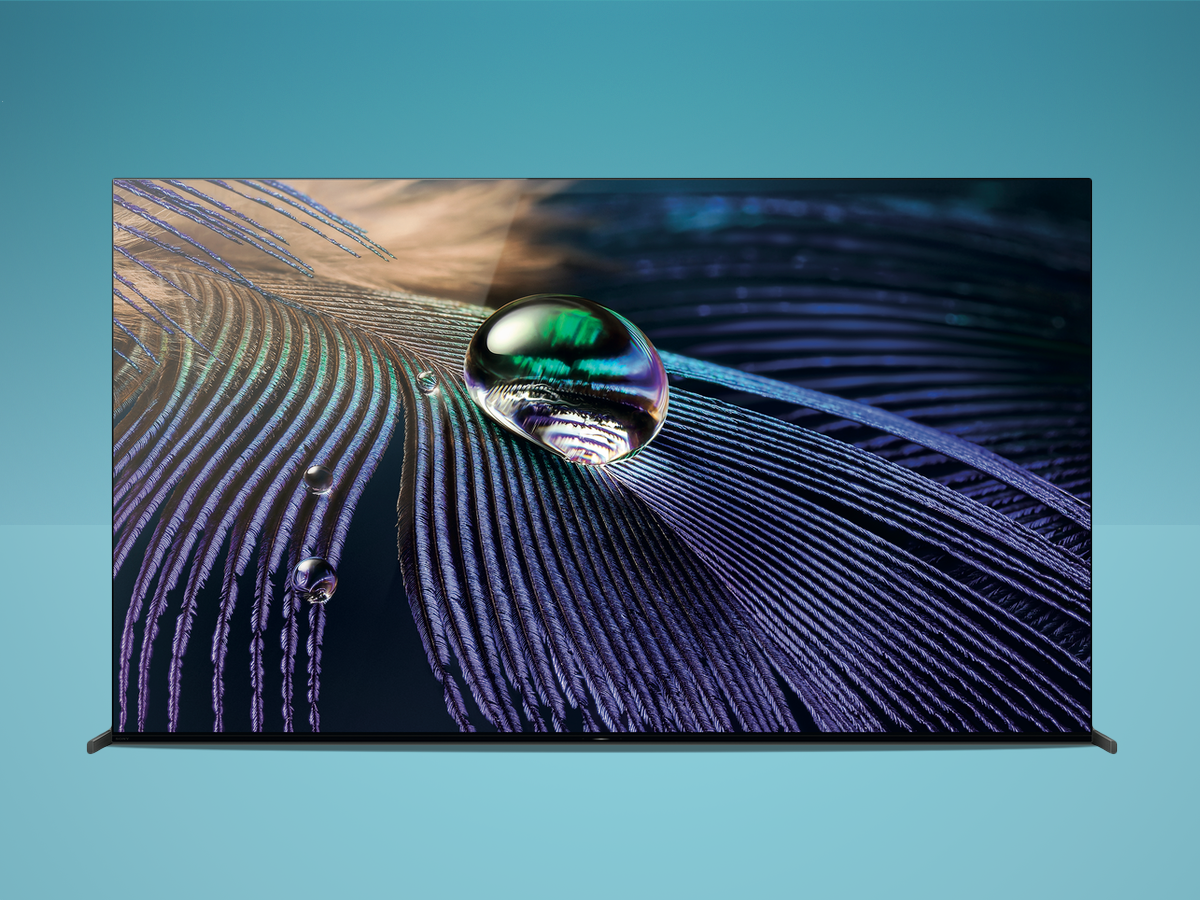
2. Sony XR-55A90J
Stuff Verdict
Everything this TV does, it does to a dizzily high standard. In the end, the price seems fair enough
Pros
- Outstanding picture quality in every respect
- Unusual and effective sound system
- Nice new Google TV interface
Cons
- Not the wall-hangiest TV you can buy
- Not cheap
| Sony XR-55A90J specs | |
|---|---|
| Display | 54.6in 3840×2160 OLED |
| Supported formats | HDR10, HLG, Dolby Vision |
| UI | Google TV |
| Connectivity | 4x HDMI, 3x USB, Ethernet, optical, Wi-Fi, Bluetooth, AirPlay |
Throwing money at something isn’t always a solution. But in the case of the Sony XR-55A90J OLED, it very much is. Yes, it’s super expensive for a 55in television, but it’s also worth every penny. There’s a lot of cutting-edge tech here: the super-fast and deeply intelligent XR processor is present, with Acoustic Surface Audio+ trickery. Google TV has replaced Android TV, which is a major upgrade. Sony’s exclusive Bravia Core streaming service is included, too.
Performance, as the price demands, is profoundly impressive. The A90J is very bright by OLED standards, so contrasts absolutely pop from the screen. This TV can call on a seemingly limitless array of colours, and easily describe minute differences in shade and texture. It handles on-screen motion with casual effortlessness and can bring detail and subtlety to inky black tones. Plus it also upscales low- resolution content without having a panic attack.
The A90J’s feet can sit low or stand high enough to fit a soundbar beneath, but Sony is so pleased with its in-built audio that it’s fitted speaker binding posts on the back panel, so the entire screen can be the centre channel in a surround-sound setup.
- Read more: Sony XR-55A90J review
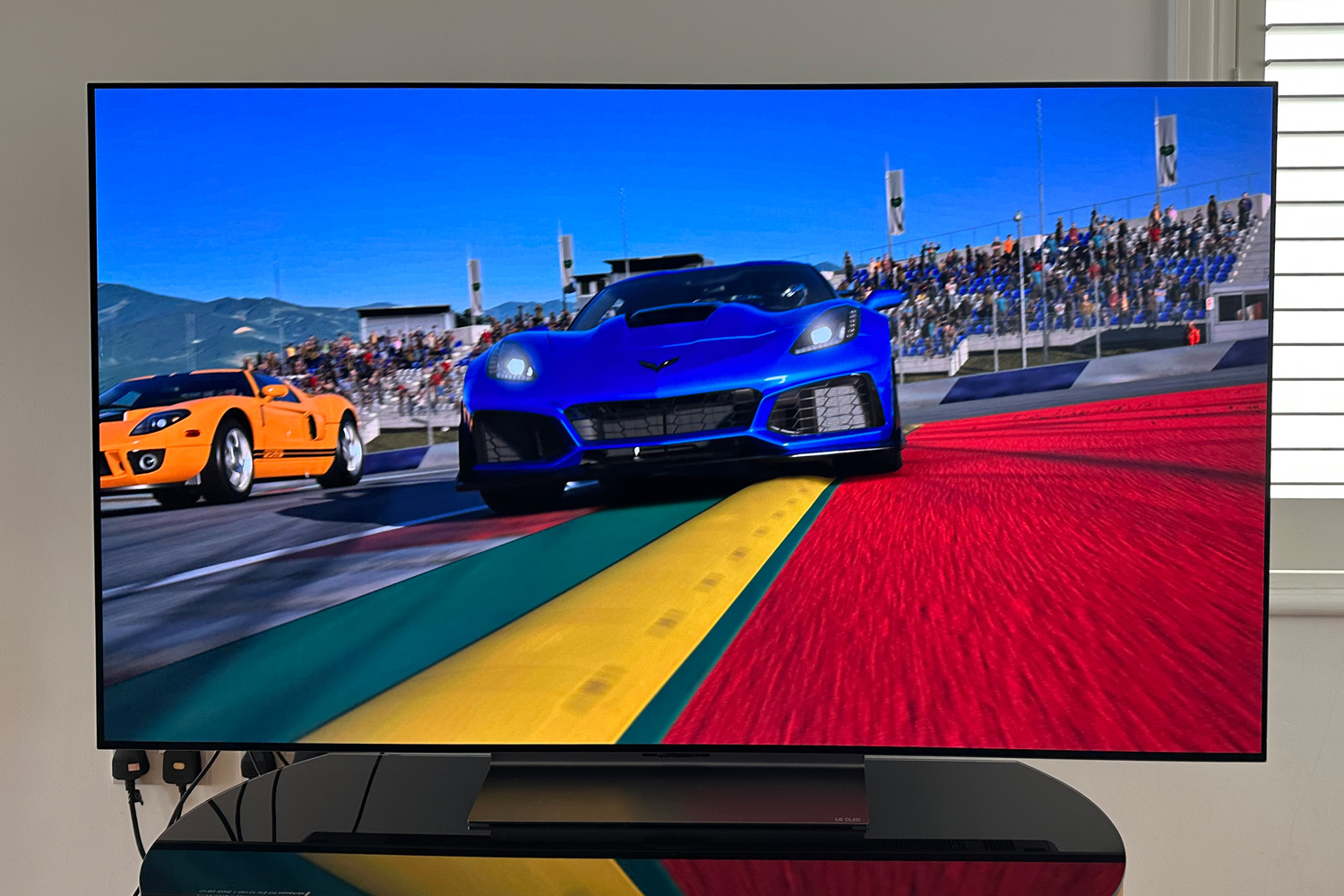
3. LG OLED65C3
Stuff Verdict
Add the C3 to the long list of brilliantly accomplished OLED TVs LG has delivered over the last decade
Pros
- Brilliant all-around picture quality
- Great for gaming
- Upgraded webOS interface
Cons
- Sound is underwhelming
- Not particularly affordable
| LG OLED65C3 specs | |
|---|---|
| Display | 65in 3840×2160 OLED |
| Supported formats | HDR10, HLG, Dolby Vision |
| UI | WebOS 2.3 |
| Connectivity | 4x HDMI, 3x USB, Ethernet, optical, line out, Wi-Fi, Bluetooth |
The LG OLED65C3 has some obvious advantages over the C2 it replaces, not least in its HDR picture processing enhancements and the revision to its UI. Is that enough to tempt C2 owners into a costly upgrade? Probably not. The rest of us, though, can simply be impressed by what is the latest in a long line of high-achieving LG OLED TVs.
From strong gaming and upscaling performance to natural colour balance, true blacks, and wide-ranging contrasts, it’s a joy to behold. As is usually the case though, you’ll want to beef up it stock speakers with some external gear to do justice to the on-screen action.
- Read more: LG OLED65C3 review
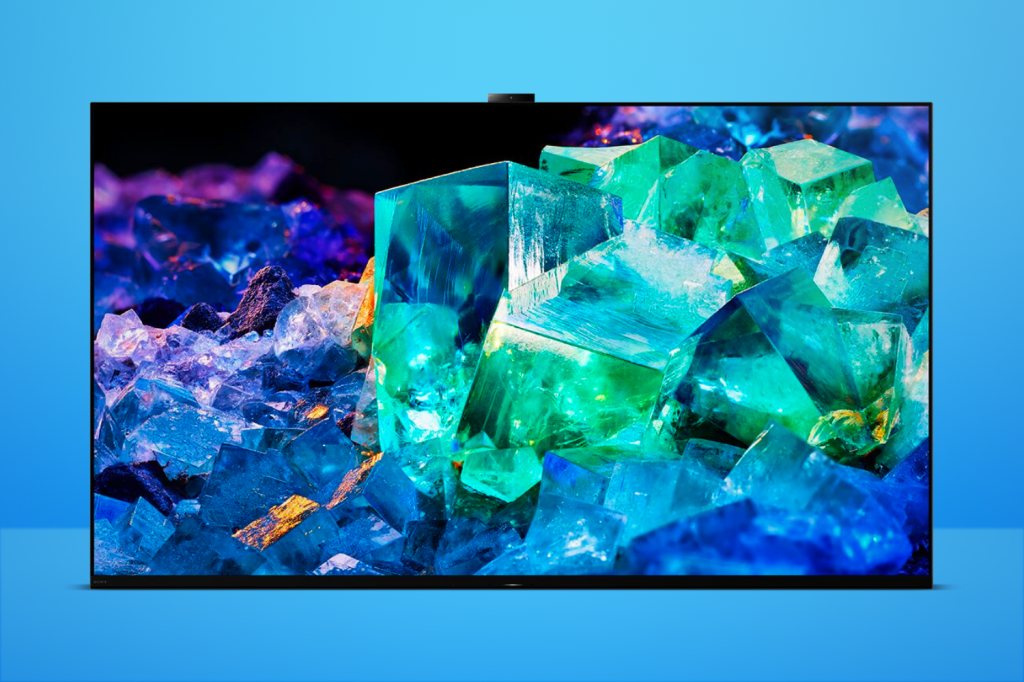
4. Sony XR-55A95K
Stuff Verdict
Unapologetically premium, Sony’s top-spec telly isn’t a huge leap forward, but it still proves that QD-OLED is the real deal
Pros
- Lovely natural picture balance
- More varied bright tones than OLED seems capable of
- Punchy, assertive sound
Cons
- Superfluous Bravia Cam
- Not the great leap forward we might have been expecting
| Sony XR-55A95K specs | |
|---|---|
| Display | 55in 3840 x 2160 QD-OLED |
| Supported formats | HDR 10, HLG, Dolby Vision |
| UI | Android TV |
| Connectivity | 4x HDMI, 2x USB, Ethernet, Wi-Fi, Bluetooth, AirPlay, Chromecast |
First out of the blocks with a QD-OLED telly, Sony’s A95K promises to combine the advantages of OLED – deep blacks and vivid colours – with the brightness of LCD. In practice, it’s one of the best out-of-the-box TVs you can buy.
All-screen from the front, build quality is everything you’d expect from a premium Sony product. Read: basically flawless. Its feature set is similarly superlative, with two out of four HDMI inputs supporting 4K at 120Hz. Less useful is the Bravia Cam, which attaches magnetically to the top. It will one day adjust settings based on ambient conditions, but for now it’s a glorified webcam.
Like all of Sony’s OLED TVs, the A95K’s screen itself acts as a speaker, reinforced by a couple of rear-firing subs. When it comes to fidelity, detail and outright punch, it can sonically match any TV without a separate speaker bar.
Star of the show, though, is the picture. While it isn’t startlingly brighter than the best non-QD OLEDs, the A95K can generate the most convincing and nuanced brightness of any OLED currently available. Detail is high across the board, colour fidelity is effortlessly natural and depth of field is almost three-dimensional, given the right material. All of which means the A95K is as enjoyable as 4K televisions get right now.
- Read more: Sony XR-55A95K review
The best luxury 4K TVs:
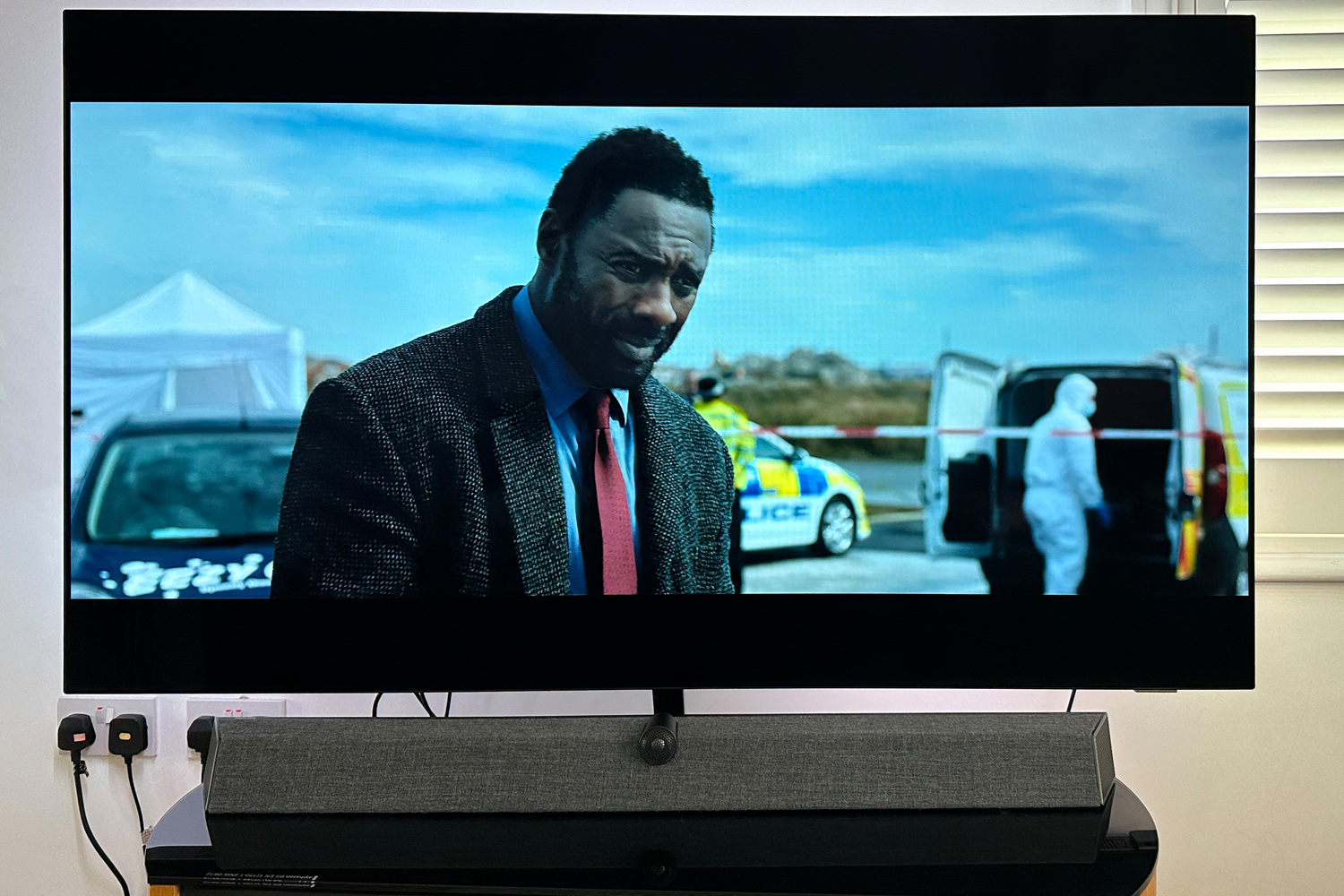
1. Philips 65OLED937
Stuff Verdict
The Philips OLED+937 not only has it where it counts, it has it to an almost indecent degree
Pros
- Bright, vibrant, immersive images
- Big, convincing, immersive sound
Cons
- Takes forever and a day to set up
- Remote control needs a refresh
| Philips 65OLED+937 specs | |
|---|---|
| Display | 65in 3840 x 2160 OLED |
| Supported formats | HDR 10, HLG, Dolby Vision |
| UI | Android TV |
| Connectivity | 2x HDMI 2.1 2x HDMI 2.0, 3x USB, Ethernet, Wi-Fi, Bluetooth, Chromecast |
Ever since Philips began collaborating with Bowers & Wilkins for its high-end TV audio systems, the company has set itself apart with high-quality sound, in addition to the brilliant Ambilight feature. In a market where most televisions seem to be far too similar to each other, this has certainly been a refreshing development. Of course, this sort of differentiation doesn’t come cheap. But it’s worth it.
Philips’ gorgeously large eOLDE set delivers both stunning picture quality, and wide, immersive sound, thanks to the aforementioned partnership. A perfect,t high-quality TV for those who want the best experience with minimal faff, it’ll hit your wallet hard, and your eyes and ears even harder. Worth it.
- Read more: Philips 65OLED+937 review
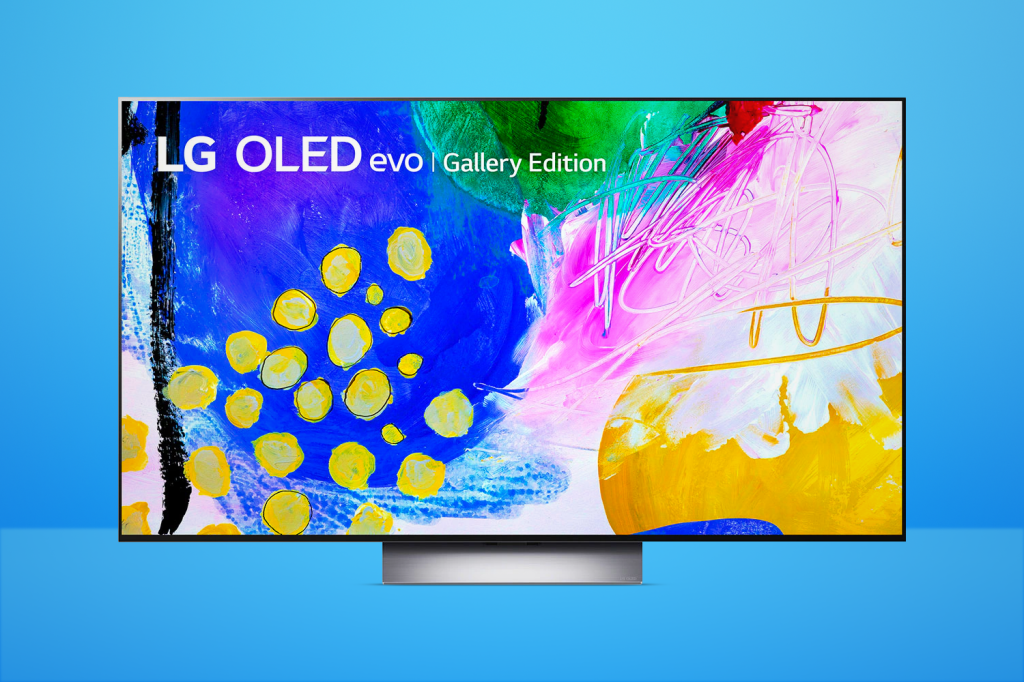
2. LG G2 77in OLED
Stuff Verdict
Picture-perfect quality in a properly premium TV package, the G2 is one of the best and brightest OLED tellies on the market
Pros
- Excellent colour accuracy and perfect inky blacks
- Intuitive smart TV software
- Dazzlingly bright
Cons
- Pricey, and the stand is sold separately
- Sluggish setup process
| LG G2 77in OLED specs | |
|---|---|
| Display | 76.7in 3840 x 2160 OLED |
| Supported formats | HDR 10, HLG, Dolby Vision |
| UI | webOS |
| Connectivity | 4x HDMI, 3x USB, Ethernet, Wi-Fi, Bluetooth, AirPlay, Chromecast |
LG’s long been an OLED pioneer and the G2 is a top-spec telly to cement its reputation. With an upgraded panel, brand-spanking processor and improved heat dissipation, it promises brightness to rival the best LCDs.
LG calls the G2 its “Gallery Edition” for good reason: it’s designed to be wall-mounted. And in 77in guise, it does plenty to justify the framing, as well as the Picasso price tag. Hues are vivd, yet colour accuracy is second to none. Blacks are as inky as you’d expect, while its OLED evo panel is dazzlingly bright. Image clarity is similarly excellent, with clever AI upscaling to make older content look good in 4K. All of which combines to produce a masterpiece and definitely one of the best 4K TV options around.
Besides the occasional bug, LG’s updated webOS interface remains intuitive and clutter-free. A new gaming menu lets you tweak refresh rates, with all four HDMI 2.1 ports supporting 4K at 120fps. The G2’s down-firing speakers also pull off a convincing Atmos experience, simulating virtual surround with decent punch – which you can’t say of many integrated TV speakers.
- Read more: LG G2 77in OLED review
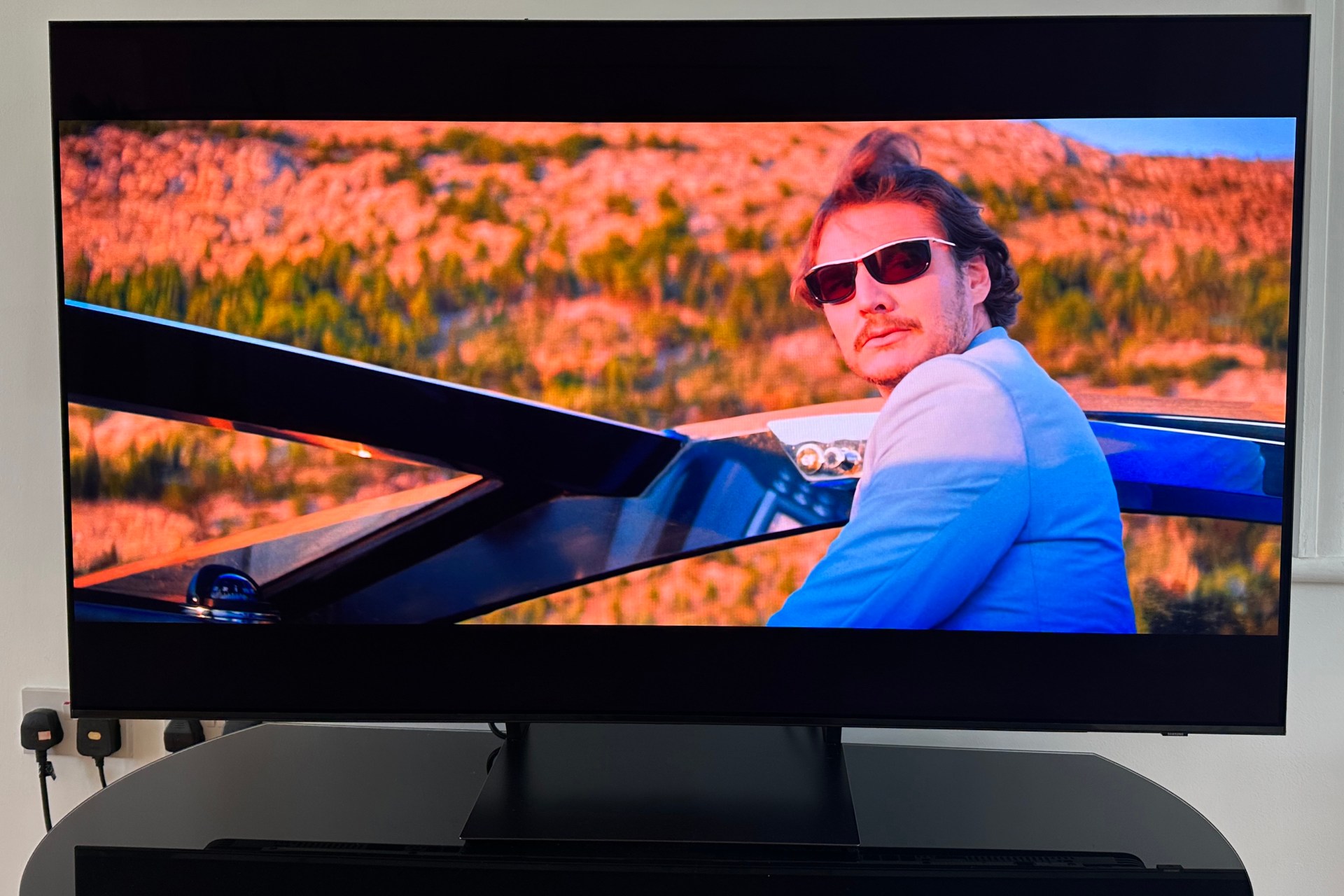
3. Samsung S90C
Stuff Verdict
Samsung has seen the OLED light – and it is good
Pros
- Confident, convincing and absorbing picture quality
- Surprisingly accomplished sound
- Good-looking and well made
Cons
- No Dolby Vision HDR
- Smart TV interface takes its time
| Samsung S90C specs | |
|---|---|
| Display | 65in 3840×2160 OLED |
| Supported formats | HDR10+, HLG |
| UI | Tizen |
| Connectivity | 4x HDMI, 2x USB, Ethernet, optical, Wi-Fi, Bluetooth |
Samsung’s OLED beast serves up glossy blacks and bright whites to deliver some seriously impressive performance, with plenty of nuance and shade in the tone department. Full HD upscaling is, as expected, formidable, with high details and solid contrasts on offer.
Gamers too, will appreciate the specs on offer here, which include more than enough HDMI 2.1 ports to satisfy multiple consoles, along with a low input lag and 4K 144Hz gaming. That’s pretty impressive for a TV whichever way you slice it, beating other 4K/120Hz sets in the refresh rate department.
Best of all, given the fact that most TV speakers tend to sound rather anaemic, the S90C’s built-in audio hardware actually provides a relatively decent experience — one that’s good enough to stop you from automatically hooking up a soundbar. Not that that would be a bad idea, mind.
- Read more: Samsung S90C review
The best 4K TVs in the US:

1. Samsung S95B
Stuff Verdict
You’ll find a rather impressive picture with vibrant colours and the best brightness on an OLED telly… but you’ll have to fiddle around to get there.
Pros
- The brightest OLED we’ve seen
- Vibrant colours, with smartphone calibration
- A beautifully slim design
Cons
- Sluggish software that slows you down
- Picture settings need tweaking for brightness
| Samsung S95B OLED specs | |
|---|---|
| Display | 55in 3840×2160 OLED |
| Supported formats | HDR, HDR10+, HLG |
| UI | Tizen OS |
| Connectivity | 4x HDMI, 2x USB, Ethernet, optical, Wi-Fi, Bluetooth |
The S95B is one of the best 4K TVs for most people in the US, especially for those already used to (and happy with), Samsung’s TV experience, which includes fancy extras like its cloud Gaming Hub.
Gamers will be able to enjoy 4K, 120Hz gaming, thanks to a generous array of HDMI 2.1 ports, and other features like FreeSync.
Being a QD OLED affair, it offers a brighter viewing experience compared to something like the LG C2 OLED, while its single-stand design makes for convenient placement, even in the larger-screened models.
- Read more: Samsung S95B OLED review
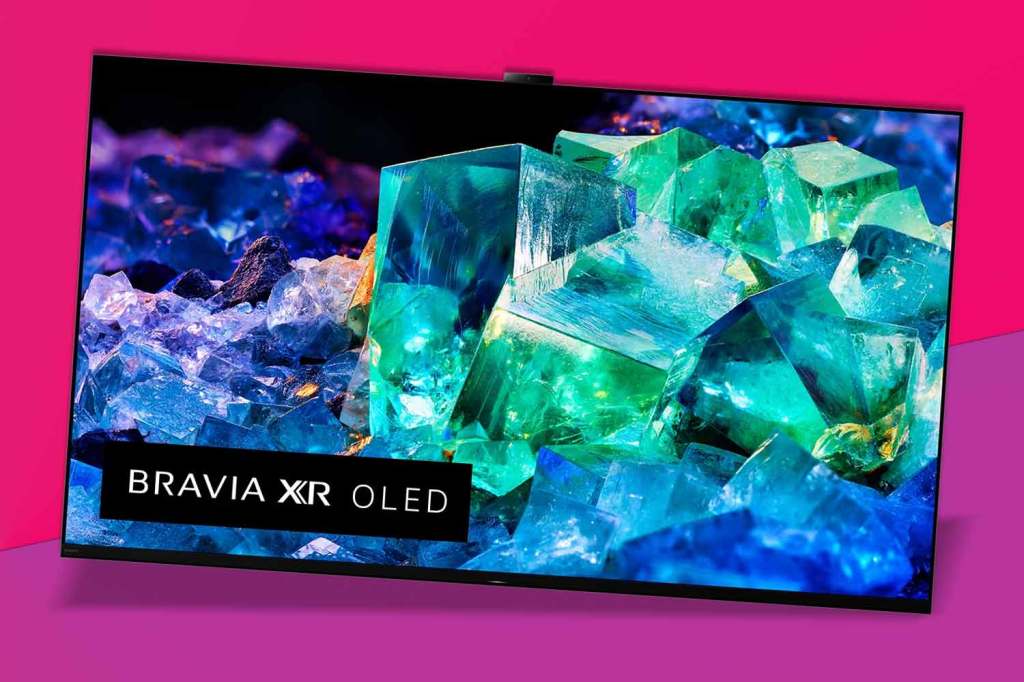
2. Sony Bravia XR A95K
Stuff Verdict
Unapologetically premium, Sony’s top-spec telly isn’t a huge leap forward, but it still proves that QD-OLED is the real deal
Pros
- Lovely natural picture balance
- More varied bright tones than OLED seems capable of
- Punchy, assertive sound
Cons
- Superfluous Bravia Cam
- Not the great leap forward we might have been expecting
| Sony XR-55A95K specs | |
|---|---|
| Display | 55in 3840 x 2160 QD-OLED |
| Supported formats | HDR 10, HLG, Dolby Vision |
| UI | Android TV |
| Connectivity | 4x HDMI, 2x USB, Ethernet, Wi-Fi, Bluetooth, AirPlay, Chromecast |
Sony’s A95K set is one of the most expensive 4K TVs around right now, and with good reason. Like Samsung’s excellent S95B, Sony’s offering also offers a stunning, bright QD-OLED screen, but also throws in some additional advantages — namely, support for Dolby Vision HDR, and Dolby DTS:X audio.
These extras, coupled with the A95K’s impeccable colour accuracy for enjoying content like the creator’ intended, make it one of the best premium TVs around. Until its successor lands, that is.
- Read more: Sony XR-55A95K review
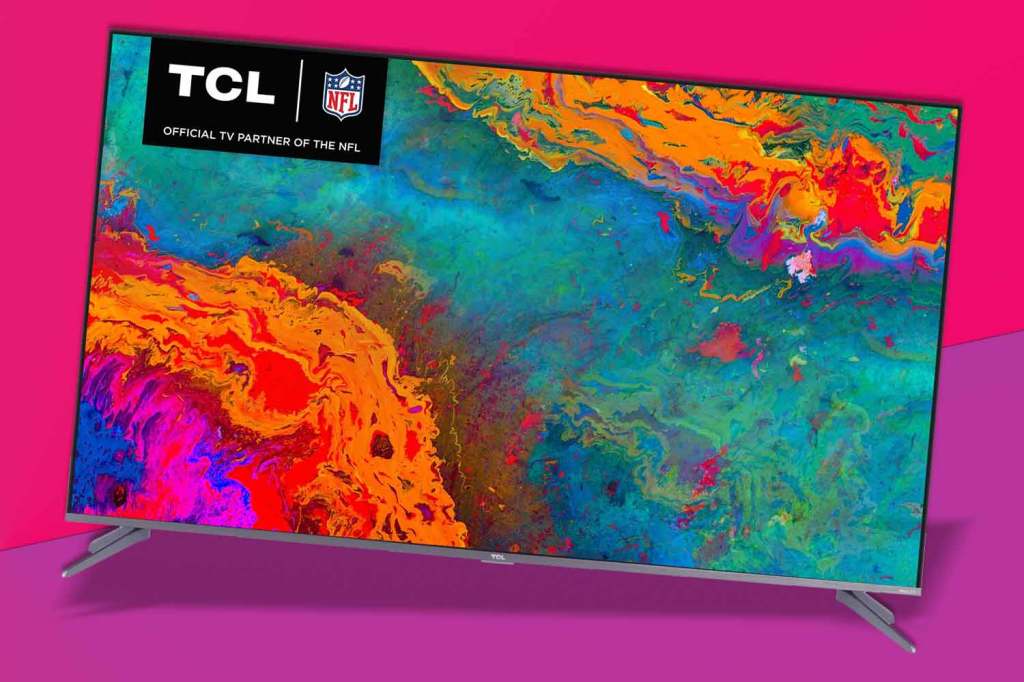
3. TCL 5-Series
Stuff Verdict
A Quantum Dot LED TV at this price is nothing to be sniffed at – this affordable TV is great for gaming and general viewing
Pros
- Great contrast and response time
- Excellent price
Cons
- Not the best viewing angles
- Blooming local dimming
| TCL 5-Series specs | |
|---|---|
| Display | 55in 3840 x 2160 OLED |
| Supported formats | Dolby Vision, HDR10, HDR10+, HLG |
| UI | Roku TV |
| Connectivity | 4x HDMI, USB, Ethernet, Wi-Fi, Bluetooth |
A Quantum Dot LED TV at this price is nothing to be sniffed at, which is why TCL’s 5-Series is our pick for the best budget 4K TV to buy in the US. With support for Dolby Vision, HDR10+ and HLG, you’re getting plenty of options for your money too.
HDR performance is, as expected, not the best you’ll find around, and you might find the highlights lacking in particular. Once you remember its comparative price though, it’s easy enough to forgive —

4. LG C2
Stuff Verdict
Looking for a television that can double up as a gaming monitor? The 42in LG C2 is the perfect option
Pros
- Bright, vibrant picture
- Unbeatable for gaming
Cons
- Not as bright as QD OLED
| LG C2 specs | |
|---|---|
| Display | 42in 3840 x 2160 OLED |
| Supported formats | Dolby Vision IQ, HDR10, HLG |
| UI | LG webOS 22 |
| Connectivity | 4x HDMI, 3x USB, Ethernet, Wi-Fi, Bluetooth, AirPlay 2 |
Despite not having the latest QD OLED tech (and therefore not reaching the same brightness levels offered by the Sony and Samsung offerings on our list), the LG C2 remains one of the best 4K TVs in the US. Plenty bright enough (especially for viewing in dimmer rooms), it offers all the superb blacks and punchy colours that OLED displays are famed for.
Our pick of the range is the 42in model, which is not only easier on your wallet, but also ideal for use as a dual PC monitor/TV setup — especially when you take its more manageable screen size, 4K resolution, HDMI 2.1 support, and 120Hz gaming performance into account.

5. Hisense U8H
Stuff Verdict
Packing in as many features possible, all why maintaining a relatively sensible price tag, the Hisense U8H is a great option if you want something different to the big three brands
Pros
- Great contrast, despite being LED
- Decent gaming features
Cons
- Viewing angles could be better
- International varients are essentially completely different TVs
| Hisense U8H specs | |
|---|---|
| Display | 65in 3840 x 2160 ULED |
| Supported formats | Dolby Vision, HDR10+ |
| UI | VIDAA U6.0 / Google TV |
| Connectivity | 4x HDMI, USB, Wi-Fi, Bluetooth |
Hisense’s U8H is a very solid mid-range offering that serves up a 4K LED screen, powered by Google TV for access to all of your favourite apps and games at the touch of a button. Another win, especially at this price, is support for both HDR10+ and Dolby Vision HDR, which is something that cannot be said of its Samsung rival.
Obviously, given the nature of its LED panel, it can’t compete against the inky blacks and in-your-face immersion offered by OLED alternatives, but it gets plenty bright, with two HDMI 2.1 ports for next-gen gaming at a fluid 120Hz.
How to choose the best 4K TV for you
Buying a television is a big purchase, one that you’ll have to live with for a long time (much longer than a smartphone), so when buying a 4K TV there several crucial factors that should guide your decision-making process.
The first thing you’ll want to consider is the screen size. You need to get a TV that best suits your viewing environment. A larger screen can offer a more immersive experience, but it must fit comfortably within your available space.
There are also plenty of important specs and features you’ll want to look out for, such as HDR, OLED, refresh rates, and viewing angles.
High Dynamic Range (HDR) support is a must when buying a modern television. HDR enhances contrast and colour range, resulting in more vivid and lifelike images. Look for TVs that support popular HDR formats like HDR10, Dolby Vision, and HLG.
The type of panel is also important. OLED panels tend to offer superior contrast and colour accuracy but may come at a higher price point. LED/LCD TVs, on the other hand, are generally more budget-friendly, but can’t match OLED for contrast and colour accuracy.
The refresh rate is a key specification for reducing motion blur. This is especially important if you’re into gaming or watching fast-paced sports. Higher refresh rates like 120Hz or 240Hz can provide smoother motion.
Viewing angles can be important, especially if you have a wide seating arrangement. OLED TVs typically offer wider viewing angles compared to certain LED/LCD models.
Now, most modern 4K TVs are equipped with smart features, such as built-in streaming apps, voice control, internet connectivity, and the ability to stream content from your smartphone. If you have a favourite streaming service, make sure it’s available on the television before you buy it.
If you own multiple game consoles, media players, set-top boxes and streaming sticks, ensuring you have sufficient ports and connectivity options for your devices is crucial. You want to aim for around four HDMI ports, and if you plan to use your TV for gaming with next-gen consoles, make sure these ports have HDMI 2.1 support.
The TV’s audio quality should not be overlooked. While some 4K TVs have better built-in speakers than others, if you’re really serious about audio you’ll want to upgrade to an external sound system, like soundbars or home theater systems.
Finally, it’s important to note that design and aesthetics matter too. You’ll want a TV that fits well with your room’s decor. Slim bezels and sleek designs are popular choices, while you can now also get televisions that look like paintings when in standby mode.
How we test the best 4K TVs
We have used and reviewed most 4K TVs on this list, so you can trust us when it comes to recommending the best television to buy.
We usually spend a week or longer reviewing 4K TVs, testing out all of the software features, picture quality and audio chops. Our reviews are very comprehensive, testing every single aspect of a TV, including UK, viewing angles, and testing them with different media (games, TV, movies, etc).
For more information on Stuff’s rating and review process, read our page on how we test products.
We’ve rounded up a selection of the best auto mowers below, including traditional ones that require laying down a boundary wire (to prevent them from rolling off into the sunset), and more high-tech versions which make use of fancy GPS, cameras, and sensor tech to help keep them on track.
Before you settle on the best robot lawn mower for your needs, it’s wise to double-check the size of your garden, and the angle of your steepest slope. If you don’t, you might end up with one that doesn’t have enough power to get the job done.
And remember — because most robot lawn mowers chop up grass so finely, you don’t have to worry about picking up cuttings after they’re done. In fact, the mulched grass cuttings are a handy source of nutrition, letting your garden flourish with less work required. Clever, eh?
What’s the best robot lawn mower?
The Segway Navimow i105 (read more) is more affordable, can cut shorter and have more smarts than the previous version. AI-assisted satellite mapping means no boundary wire; a 140° camera with built-in Al algorithms detects more than 20 types of common garden objects to dodge.
Other robot lawn mower recommendations
Want an alternative to the Navimow? You got it. Here are a few other top picks, ahead of our comprehensive list of the best robot lawn mowers:
The Yard Force Compact 300RBS (buy now) is one of the cheapest offerings on our list, making it a great entry-level option. Despite its price, it offers a respectable 300m² coverage area.
The Gardena Sileno Minimo 250 (buy now) prides itself on being the quietest mower in its class, the Sileno has a noise level of just 57db(A). Capable of operating in most weather and terrain, it uses a boundary wire with AI tracking to stay on course.
The Worx Landroid L (buy now) has an offset blade for some of the cleanest edge cuts you’re likely to find. It also prides itself on a quicker cut than most, thanks to AI tech for a smarter, faster-turning pattern and cutting layout.
The Ecoflow Blade (buy now) is the most advanced lawn mower out there, resembling a Martian ATV, it’ll navigate your lawn without a perimeter wire and even has an optional Sweeping Kit.
The best robot lawn mowers you can buy today:
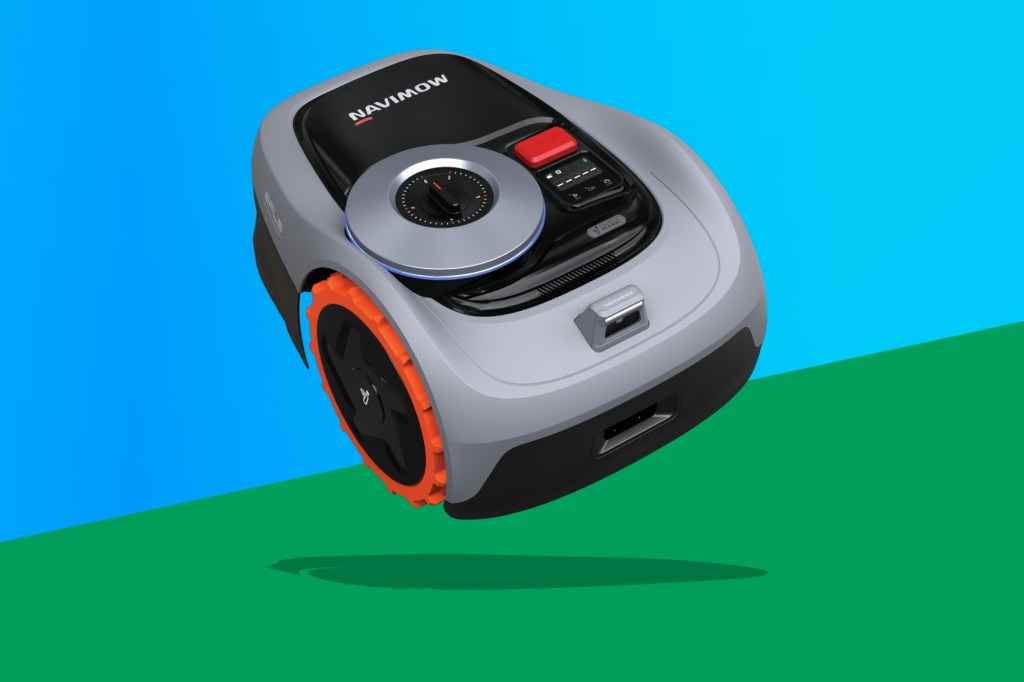
1. Segway Navimow i105
Stuff Verdict
A practically perfect robo-mower in every way, and outstanding value
Pros
- Incredibly easy setup
- Great value for money
- Excellent app control
- Cutting performance
Cons
- Nothing, really
| Segway Navimow i105 specs | |
|---|---|
| Edge type | GPS |
| Coverage | 500m² |
| Cutting height | 2 – 6cm |
Segway’s first-gen Navimow impressed when it launched in the UK barely a year ago; now this new model supersedes it. The i105 and bigger-batteried i108 are more affordable, can cut shorter and have more smarts. AI-assisted satellite mapping means no boundary wire; a 140° camera with built-in Al algorithms detects more than 20 types of common garden objects to dodge. The camera also aids navigation if the satellite signal is poor, helping the mower stay within your boundary.
The new Navimow can also sense a rainy day and automatically hold off when conditions aren’t right for mowing. 4G is an optional extra (£100 including a year’s data), letting you track the mower and tinker with settings wherever you are.
Is it any good?
The Navimow triangulates satellite signals using a separate antenna for precise positioning without a wire. So you have to mount the antenna somewhere with plenty of sky, and the lawn itself shouldn’t be overshadowed by buildings and trees. The antenna mounts on a metal post and connects with a long wire to the mower’s charging dock, so you only need one power socket to serve both. Neat.
Setup was supremely easy out of the box: the app, Bluetooth pairing and Wi-Fi setup all just worked the first time. Then you use your phone like a remote control to take the mower around the lawn perimeter for mapping. It takes a bit of time to master this but it is, frankly, fun. You can store multiple lawns, add fancy stuff to the map – passages, no-mow zones around flowers or hazards – and define whether to straddle the edges of boundaries or not.
With the map made and uploaded, it took a single tap on the app to mow. And this is where the compact Navimow went from impressive to outstanding. I could see from the app that it was mowing the garden in long rows rather than randomly. Progress was visible on screen and the mowing results were efficient and neat. Not a blade of grass was missed and the edging performance was great; then it docked itself to await further instructions.
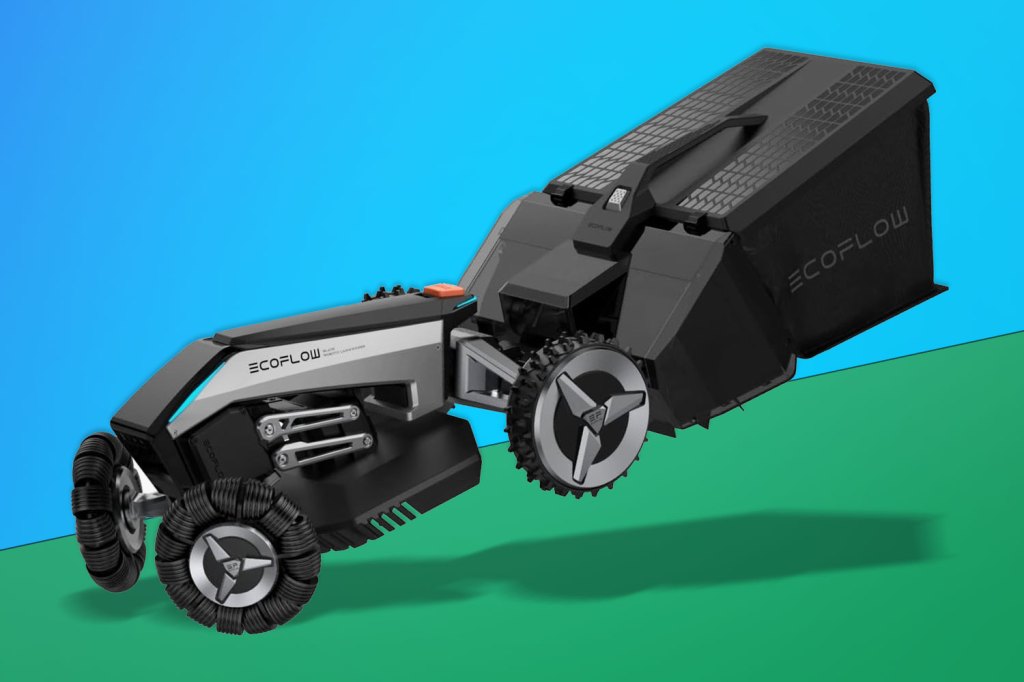
2. EcoFlow Blade with Sweeping Kit
Stuff Verdict
Robo mower of the future with precise navigation, obstacle avoidance, and optional leaf collection capabilities
Pros
- Most advanced robot mower around
- Collects leaves and debris
Cons
- So expensive
- Large and heavy
| EcoFlow Blade with Sweeping Kit specs | |
|---|---|
| Edge type | GPS |
| Coverage | 100m² to 5000 m² |
| Cutting height | 2 – 7.6cm |
The EcoFlow Blade is one of the most advanced robot lawnmowers currently available. Thanks to an impressive array of tech and sensors, it’s able to navigate your lawn to within an inch of accuracy, without the need for pesky boundary wire. And, thanks to a combination of visual sensors and LiDAR, it can intelligently recognise and avoid obstacles as well. Opt for the additional Sweeping Kit, and it will even helpfully collect leaves and other debris, leaving your lawn truly spotless.
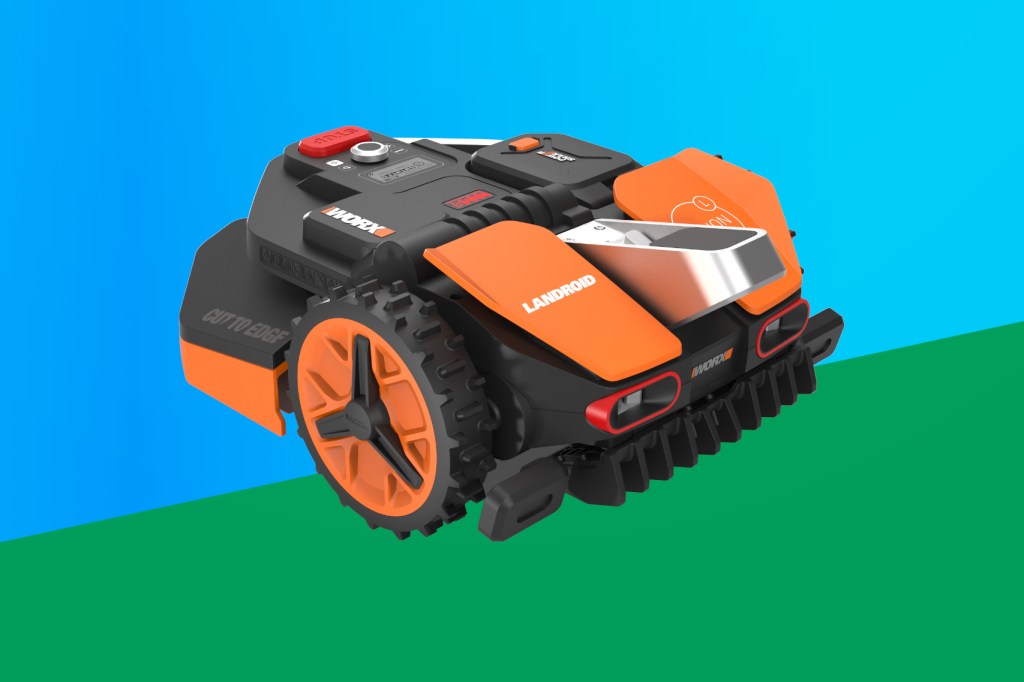
3. Worx Landroid Vision L1300
Stuff Verdict
The Worx just works, mowing well and without costing a fortune
Pros
- Choice of GPS or Perimeter wire
- Consistent mowing
- Great for edges
Cons
- Industrial looking design
| Worx Landroid Vision L1300 specs | |
|---|---|
| Edge type | Perimeter wire or GPS |
| Coverage | 1300m2 |
| Cutting height |
This one doesn’t depend on a boundary wire or GPS to define where to mow: it uses a Full HD camera and AI to navigate. The mower identifies what is and isn’t lawn, aiming to cut up to the grass edge but no further. It also has a rain sensor and can postpone its work for drier conditions if necessary.
The AI evolves, learning from real-world experiences. That knowledge then helps to shape firmware updates, which are delivered over the air to all Vision mowers. This one handles lawns of up to 1300m², which won’t do if you live in Blenheim Palace; other models in the range have maximum mowing areas ranging from 600m² to 1600m².
Unlike some robot mowers, this one can just be popped on the lawn and left to do its thing. But it won’t run over non-grass areas: if you want it to cross a path and mow a second section of lawn, you can fit two RFID markers (supplied) in the grass – one on each side – to tell it where to make the crossing. It also comes with two bendy magnetic strips that you can embed in the lawn to fence off ‘no mow’ zones if you need to protect patches, but ordinary borders should be detected fine.
Is it any good?
The initial setup involved a firmware update (over the air or USB), but I’m assured that this isn’t usually needed. After app setup and charging, the mower set forth for a good explore. It didn’t mow – it just went around the perimeter until it got back to its charging base. It did get stuck once when a wheel overshot a brick border, but this was on me and my poor base placement. It didn’t happen when I set it up better.
Once up and mowing, it handled itself immaculately. Results were impressively consistent, even on the first mow, and the edges were great for a robot. The Worx’s styling is a bit ‘boy racer’ but its performance is hard to fault. It works well out of the box, figuring out the lawn for itself. It’s clever but doesn’t try too hard – this thing is not over-engineered. And while the tech is straightforward, it comes with accessories that let you direct it around more complex lawns.
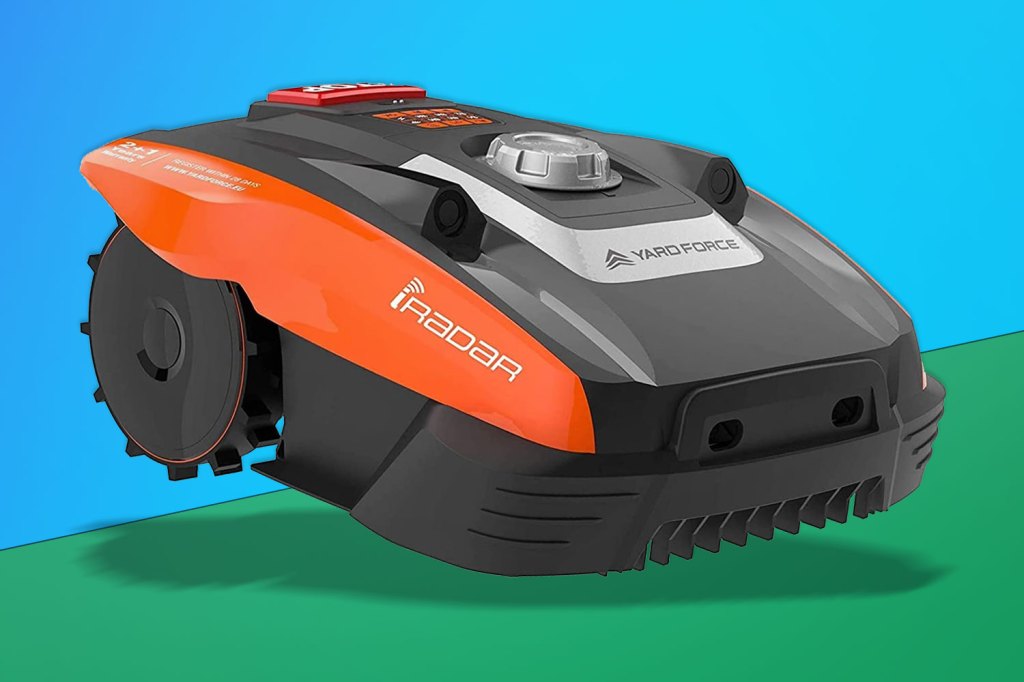
4. Yard Force Compact 300RBS
Stuff Verdict
Fully automated lawncare at the touch of a button, the i-Radar technology allows the machine to move effortlessly around your lawn while avoiding obstacles
Pros
- Great obstacle avoidance
- Affordable price
Cons
- Random cutting pattern
| Yard Force Compact 300RBS specs | |
|---|---|
| Edge type | Perimeter wire |
| Coverage | 300m² |
| Cutting height | 2 – 5.5cm |
Yard Force’s entry is one of the cheapest offerings on our list, making it a great entry-level option. Despite its price, it offers a respectable 300m² coverage area, which you can manually set yourself using a boundary wire. Its iRadar ultrasonic sensor tech helps it avoid obstacles, while Bluetooth for app control, coupled with the ability to return to its charging station when rain is detected, make for some impressive functionality at this price.

5. Stihl iMow 6
Stuff Verdict
If you don’t mind installing a wire, the Stihl offers precise, trusty mowing
Pros
- Flashy design with lights
- Large mowing area
- Quiet mow and excellent finish
Cons
- Needs a wire across the middle of your lawn
| Stihl iMow 6 specs | |
|---|---|
| Edge type | Perimeter wire |
| Coverage | 3000m² |
| Cutting height | 2 – 6cm |
Here’s the only mower on test that works with a perimeter wire. In fact, it also needs a wire across the middle of the lawn – this guides the mower home to its docking station and also splits the garden into two independent zones.
This all-new model has a swing-tip blade system, a new design, jazzier lights and a new interface: large, simple buttons on top let you mow, stop, send it home or get info. The My iMow app has the same features as previous models, including scheduling, but adds controls such as changing the cutting height (17 choices between 20 and 60mm) or telling it to only mow one side of the lawn.
The iMow 6 has a generous mowing area of up to 3000m² and sits in the middle of Stihl’s 2024 range. The pricier Evo model (£2799) adds a 4G SIM card, so it doesn’t need to be in Bluetooth or Wi-Fi range for app control.
Is it any good?
This one mows quietly and the finish is excellent. Its three free-swinging blades ensure a clean cut and rotation changes direction regularly to extend their lifespan. Initial wire setup is straightforward, but dealer setup (from around £200) is best for large or complex gardens. There’s no drop sensor, but run the perimeter cable in from the edge, loop it around that pond and back out again and the iMow will cross the double wire OK but won’t go inside the single-wire loop. Clever.
And the app is nicely intuitive. It’s easy to schedule mowing and adjust settings, while an onboard sensor detects rain and pauses to protect wet grass, rescheduling to make up lost time. It also adapts speed to the terrain for an even cut, and works out the best way back to the docking station to avoid leaving tracks by going over the same route each time.
It will slow down when it detects an obstacle, only lightly touching it (yes, I stood in front of it repeatedly to test this). Security includes geofenced controls that lock if it’s taken away from its garden. I’ve tested previous models of the Stihl iMow and this is quite literally a cut above. And that wire gives supreme accuracy.

6. Husqvarna Automower 320 Nera
Stuff Verdict
Pricey but precise… though the next model up is even better
Pros
- Can handle steep slopes
- Comes with dealer setup
Cons
- Very expensive
- This model doesn’t have radar
| Husqvarna Automower 320 Nera specs | |
|---|---|
| Boundry type | GPS or perimetre wire |
| Coverage | 2200 m² |
| Cutting height | 2 – 6cm |
Bought solo, the Nera is a regular robo-mower that needs a perimeter wire. But I tested it with the Epos kit (taking the total to £4417), which makes it a modern machine that navigates via satellite location with no wire required.
It looks very cool, but be warned: because both the mower and the Epos kit need a good satellite link, it won’t cope well if your lawn is under tree cover. Two devices means it needs two outdoor power sockets too. The satellite mapping sets the perimeter and can also be used to map stuff like trees or garden furniture. The mower can navigate narrow paths too, varying its route to avoid leaving ugly tracks. It handles slopes well thanks to a pivoting front axis, but exactly how well is complicated: it can handle up to 50% in the middle but only 25% at the perimeter.
Is it any good?
Dealer setup is standard with the Epos, so a chap from Autocut delivered it and set it up. He figured out line-of-satellite-sight placement then navigated the Nera via an app, driving it like an RC car and laying digital waypoints at each turn to map the perimeter. Thanks to the satellite, pins are precise. The mowing results were impressive. Those digital waypoints ensure accuracy: very little grass was left unmowed at the edges, just a few centimetres.
But it doesn’t sense objects: instead, it bumps into them, stops, folds away its blades and turns to head in another direction. This works, but at this price, it’s surprising that it doesn’t have a camera or similar. Pricier Automowers use radar to sense and stop short of obstacles; if you’re going to the expense of a Nera with Epos, might as well go all the way with the 430X or 450X.
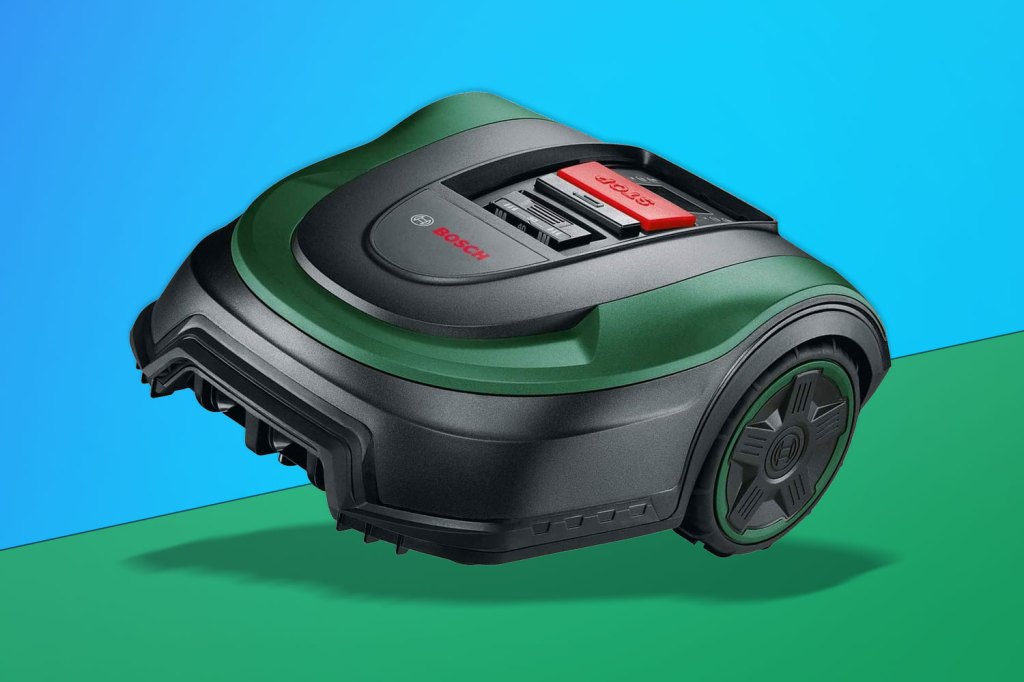
7. Bosch Indego S 500
Stuff Verdict
Like neat lines in your lawn? This is the robot lawn mower for you
Pros
- LogiCut is great for neat cutting
- Generally very smart
Cons
- Set up can take a while
- On the expensive side
| Bosch Indego S 500 specs | |
|---|---|
| Edge type | Perimeter wire |
| Coverage | 500m² |
| Cutting height | 3 – 5cm |
The standout feature of this Bosch robot lawn mower is its LogiCut feature, which maps out your lawn to enable cutting in efficient, parallel lines, making for a faster session compared to some rivals. A MultiArea feature also lets it cut additional lawn areas, while it’s also clever enough to pass through passages as narrow as 75cm between its boundary wires. It also starts each session by cutting the borders of your lawn, for a neat, tidy finish,
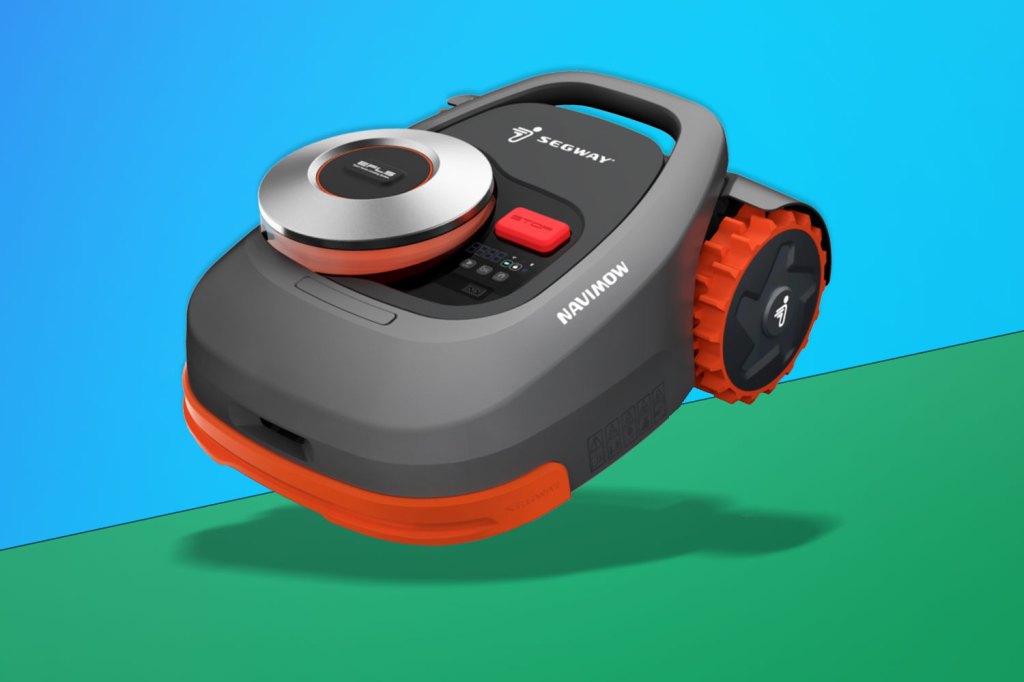
8. Segway Navimow
Stuff Verdict
If you’ve a large lawn or multiple lawns, you can’t go wrong with the Navimow. Customisable and comprehensive
Pros
- Quiet and refined
- Great safety features
- A lot of customisation
Cons
- Setup not as simple as promised
- Some antenna difficulties
| Segway Navimow specs | |
|---|---|
| Edge type | GPS |
| Coverage | 3000m² |
| Cutting height | 3 – 6cm |
Yes, Segway also makes a robot lawn mower, and it’s an impressive feat of grass-cutting engineering, thanks to its ability to accurately navigate your garden without the need for perimeter wire. With a rugged build and large tread wheels for coping with mud and rough terrain, it’ll trundle along merrily without complaint. Spring for the newer object recognition VisionFence Sensor module, and it’ll happily deal with obstacles too.
- Read more: Segway Navimow review

9. Ambrogio ZR Evo
Stuff Verdict
Small, portable, affordable. Mows straight out of the box, but check it will work with your lawn edges
Pros
- Compact design
- Plug in and play
Cons
- Height adjustment requires screwdriver
- Has issues with level borders
| Ambrogio ZR Evo specs | |
|---|---|
| Edge type | AI vision |
| Coverage | 1000m² |
| Cutting height | 2.5 – 7cm |
This novel mini robot mower only has a cutting width of 18cm but who cares? There’s no rush because you don’t have to do the work. It trundles around for hours tending to your lawn. If necessary, it recharges then goes out a second time.
The Ambrogio is tiny. It weighs half as much as most robot mowers. It looks like a remote-controlled truck and you can pick it up easily with one hand – most are heavy to lug.
It features Bluetooth but not WiFi, so you need to be near it to change settings and schedules. Or when ordering get an optional, factory-fitted GSM Connect module to add 4G. This includes two years of data and adds geofencing and tracking as well as remote control from afar.
It uses high-frequency radar and AI analysis to sense grass, comparing it to a vast database. If it senses ‘not grass’ then it turns around, so it’s no good for lawns with stepping stones or bare patches. An ultrasonic cliff sensor spots drops but the sensitivity can be tuned, so it copes with a bumpy lawn yet doesn’t fall down steps.
You adjust cutting height manually with a special screwdriver. An onboard rain sensor means it can reschedule mowing if conditions are wet. And the blade should last at least a year because it reverses direction every 100 hours of mowing.
Is it any good?
The first thing that stands out about the Ambrogio is that you can mow immediately, ‘drop and go’. Take it out of the box, pop it on the lawn and press Start. You don’t need to program it or even set up the charging dock. Mowing uses onboard sensors, with no mapping. You DIY the rest. There’s no perimeter wire, just a short wire to guide the mower to its dock.
I was half-impressed with the performance. The mowing results were good, with a border of 10cm of unmown grass only on the edges beside a wall. This reduces to 7cm over time. But level borders were more of a challenge. If you have a level border at least 25cm deep, like a patio, the Ambrogio works brilliantly: it senses where the grass ends and overshoots on purpose, straddling the edge just enough to mow it all. But I tested it on a lawn which, like many gardens, had a single row of bricks separating the grass from the borders. This just wasn’t deep enough to meet its specs, so the mower crossed the brick, sometimes savaged the primroses and got stuck.
The mower has two chunky rear wheels, smaller castors at the front. The front axle is self-levelling, to keep four wheels on the ground at all times. Usually, if the mower overshot the brick border, it pulled itself back fine. But sometimes it got stranded, one castor stuck over the edge, and sent my phone a push notification to rescue it.
You can adjust sensitivities via app but really the solution is to tweak the garden. The easiest way was to rake out a little bit of soil on the border side of the brick. The mower’s ultrasonic cliff sensor detects drops of at least 5cm.
Get your borders compliant and mowing is impressive as long as you don’t have stepping stones or bare patches. The size and ability to ‘drop and go’ makes it the most portable robotic mower I’ve seen. You can carry it through the house and pop it on your front lawn. Hell, you could even mow a friend’s lawn… and who wouldn’t invite you for lunch if you promised to mow the lawn?! Stuff says Small, portable, affordable. Mows straight out of the box, but check it will work with your lawn edges.
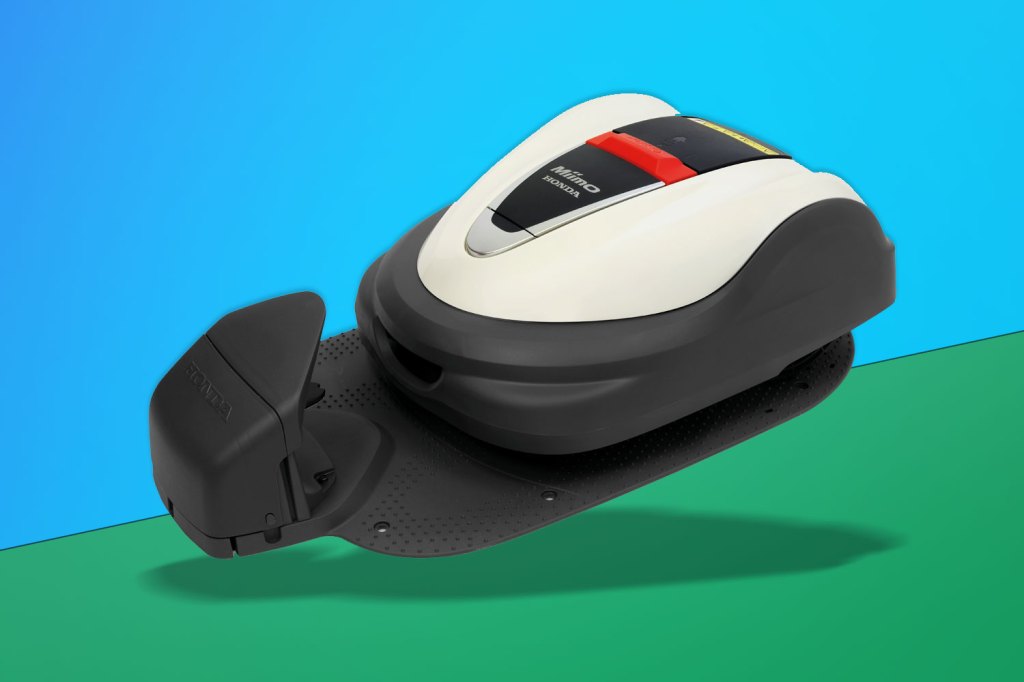
10. Honda Miimo HRM 3000 Live
Stuff Verdict
This robot mower form Honda is perfect if you have a huge lawn
Pros
- Massive cutting area
- Plenty of features
Cons
- Mobile connectivity could be better
| Honda Miimo HRM 3000 Live specs | |
|---|---|
| Edge type | Perimeter wire |
| Coverage | 4000m² |
| Cutting height | 2 – 6cm |
Top of Honda’s robotic range, the HRM 3000 Live has a huge 4,000m² mowing area (around an acre), mowing for around 90 minutes at a time before recharging for the next session. Its 3G/4G SIM card enables remote app monitoring from anywhere, while GPS tracking lets you view the mower’s location and create a geofenced operating area to protect against theft. Perimeter wire and a charging dock are included, while sensors detect bumps (objects, pets, people) and lifting or tilting, stopping the blades automatically.
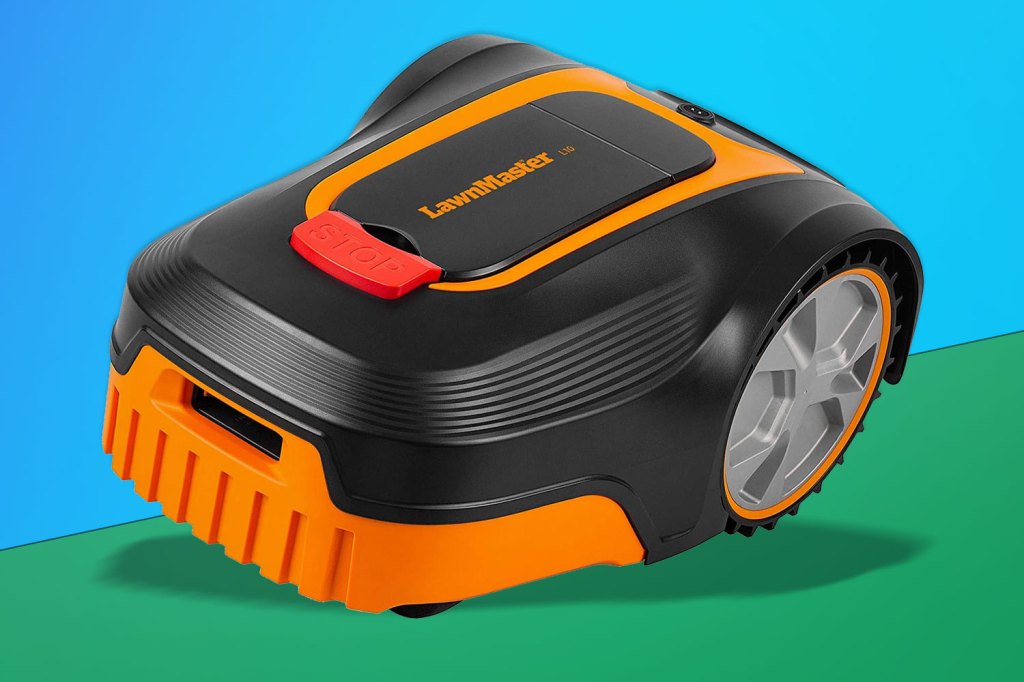
11. LawnMaster L10
Stuff Verdict
Don’t want to spend a tonne of money? The LawnMaster L10 is very affordable
Pros
- Affordable price
- No fussing once its setup
Cons
- No app control
- Random cutting pattern
| LawnMaster L10 specs | |
|---|---|
| Edge type | Perimeter wire |
| Coverage | 400m² |
| Cutting height | 2 – 6cm |
A great stepping stone into the world of robot lawn mowers, this wallet-friendly model is a simple, solid, reliable option, which uses boundary wire to get the job done. Once set up, the LawnMaster L10 does its thing automatically, and can be set to mow each day, or every other day depending on the size of your garden. It does all this without an app, for even less fuss. Self-charging, quiet, and with adjustable cutting heights, there’s a lot to love, especially at this price.

12. Husqvarna Automower 435X AWD
Stuff Verdict
The Husqvarna Automower 435X has all-wheel drive to challenge the most challenging terrain
Pros
- Great at tackling tough terrain
- AI smarts
Cons
- Very expensive
| Husqvarna Automower 435X AWD specs | |
|---|---|
| Edge type | GPS |
| Coverage | 3500m² |
| Cutting height | 3 – 7cm |
The Range Rover of the robot mowing world, with all-wheel drive, GPS – including theft tracking – and the ability to create different zones for different bits of your garden, the 435X AWD has enough power to mow lawns of up to 3,500m2 with slopes of up to 70%. The 435X looks like a small Bentley and costs much the same as a second-hand car, but if you’re looking for the ultimate robot mower, you’ll grin every time you see it and every time you look at your lawn.

13. Worx Landroid L
Stuff Verdict
You’ll get super tidy lawn edges thanks to these offset blades
Pros
- Learns you lawn
- Offset blade for tidy edges
Cons
- Expensive
| Worx Landroid L specs | |
|---|---|
| Edge type | Perimeter wire |
| Coverage | 2000m² |
| Cutting height | 2 – 5cm |
There’s plenty to love about Worx’s offering. It’s got an offset blade, for a start, which means a tidier edge than most rivals. Its charging station, too, has been thoughtfully designed to allow grass to grow through the grid-like base, letting it blend in with the rest of your garden. It’s also clever enough to learn about your specific lawn, automatically building itself the perfect schedule according to the growth rate of your grass. It doesn’t get much easier than that.
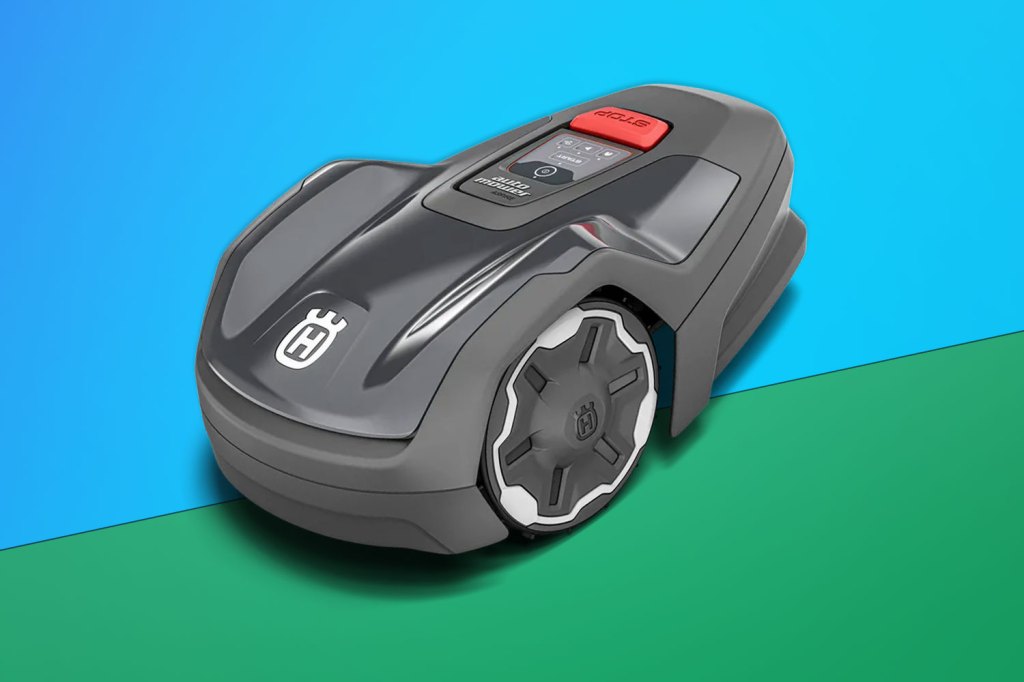
14. Husqvarna Automower Aspire R4
Stuff Verdict
A robot lawn mower that fits into your smart home with Google and Alexa integration
Pros
- Sleek all-black design
- Smart assistant integration
Cons
- Not the largest cutting area
- Cutting height range only 2.5cm
| Husqvarna Automower Aspire R4 specs | |
|---|---|
| Edge type | Perimeter wire |
| Coverage | 400m² |
| Cutting height | 2 – 4.5cm |
The Aspire R4 is fully compatible with smart home setups like Google Home and Alexa, and is clever enough to adjust its sessions according to your lawn’s growth rate. Special sensors let it navigate the slimmest of passages with ease, while a frost guard feature interrupts the mowing schedule in cold conditions, to help protect your precious grass. As with many of the other premium mowers in this list, it can easily be rinsed clean too, making for minimal maintenance.

15. Flymo EasiLife 250 Go
Stuff Verdict
A reliable robot mower from everyone’s favourite mower brand
Pros
- Fuss-free option
- Automatic scheduling based on weather
Cons
- Small cutting area
- No screens or programming for those who like to tinker
| Flymo EasiLife 250 Go specs | |
|---|---|
| Edge type | Perimeter wire |
| Coverage | 250m² |
| Cutting height | 2 – 5cm |
Ideal for small to medium gardens, the 250 Go is a fuss-free option that lacks screens or complex programming. Instead, it’s capable of automatically adjusting itself to a schedule based on the weather, although you can also tweak things via an app. The intelligent guide wire also allows for programmable starting points if you’re looking to cut multiple cutting areas of lawn, while it’s also capable of navigating through narrow passages without trouble.
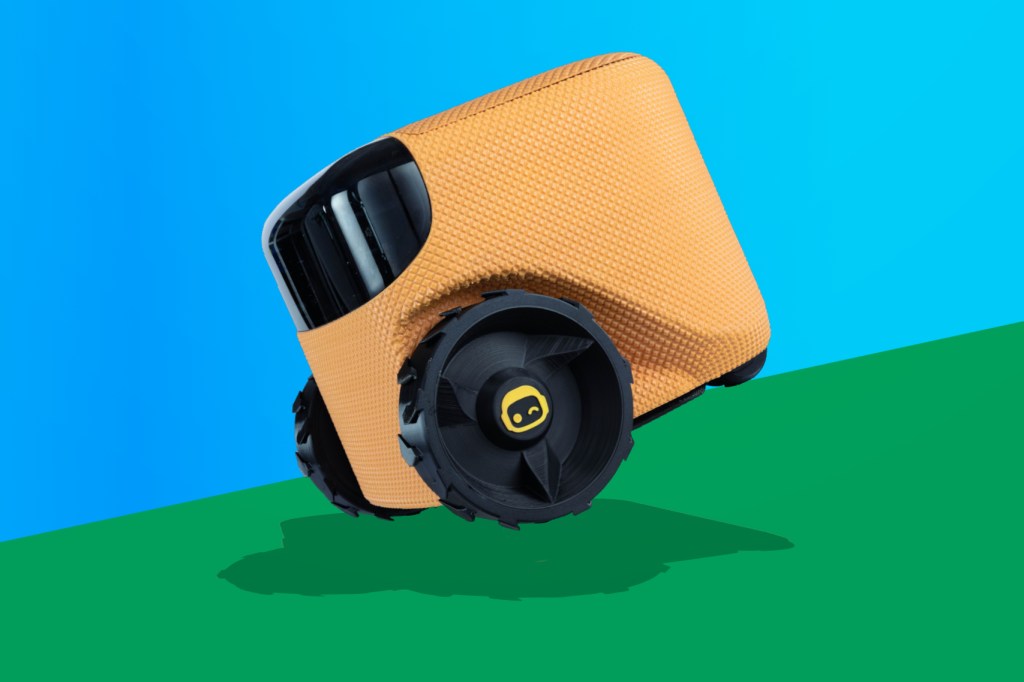
16. Eeve Willow
Stuff Verdict
Beautiful and customisable; pity about the lack of display and controls
Pros
- Great obstacle detection
- Highly customisable
Cons
- Texture holds onto dirt
- Power cable too short
| Quick specs | |
|---|---|
Eeve’s long-awaited mower (crowdfunded as the Toadi) needs no perimeter wire… but it does need you to rethink what you expect garden tech to look like.
The Willow is available in C-3PO Gold, Solo Silver or Leia White (what, no Vader Black?). So yes, it’s designed by nerds, for nerds. You won’t find it at your local garden centre. It’s highly customisable, and you can also add a herbicide sprayer, while future plans include a leaf shredder, a brush and an edger.
Is it any good?
The compact Willow is the best-looking of this bunch, although the textured finish looks sure to hold onto dirt – especially in white. The little dock is contactless; it’s hard to tell if the Willow is charging. And the 1.5m power cable is too short for most garden setups. But if you have a patio on the same level as the lawn, it can dock there and drive itself to the grass.
App setup is easy: hold the QR code in front of the mower’s camera to pair up. You’ll see a satellite map; now draw the lawn and dock. This doesn’t set a mowing path – it just gives the Willow an idea of how much time to budget for a mow. Then it does a short exploratory trip to find edges and obstacles – in my case this left a weird set of lines on the lawn till next time.
I struggled with setup at times but the Willow has 4G built in for remote access. With your permission, an expert calls to help set this up. (4G is disabled after the first month unless you subscribe, but Eeve can activate it at any time, for example to locate the mower if it’s stolen.)
The lawn was a bit tufty at first but obstacle detection was great: the camera sensed trees, toes and climbing frames, and turned just short of them. Not so good was edge performance, which left 30cm unmowed. I got this down to 20cm by selecting the ‘Daredevil’ setting… but any more daring and it got stuck. The ambitious planned add-ons mean this is potentially more than a mower. But the absence of a display or buttons means it can be hard to fathom what it’s up to.
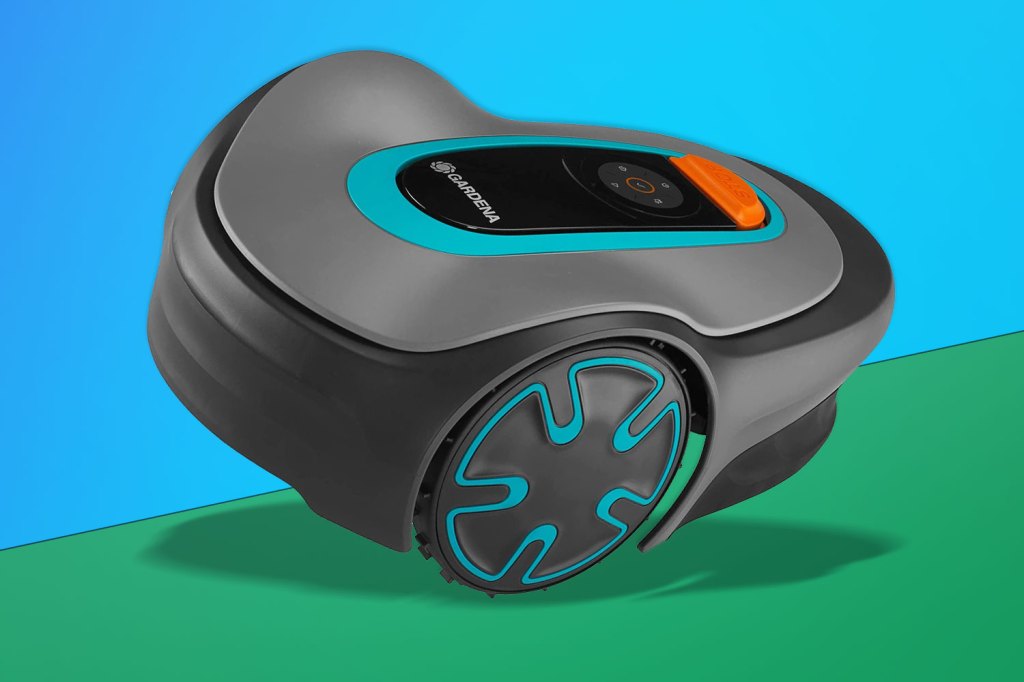
17. Gardena Silenio Minimo 250
Stuff Verdict
This super-quiet lawn mower is the one for you if you’ve got noise sensitive neighbours
Pros
- Super quiet motor
- All weather operation
Cons
- Small cutting area
| Gardena Silenio Minimo 250 specs | |
|---|---|
| Edge type | Perimeter wire |
| Coverage | 250m² |
| Cutting height | 2 – 4.5cm |
The Sileno prides itself on being the quietest mower in its class, with a noise level of just 57db(A), making it ideal for close-knit neighbourhoods. Able to operate in all weather and terrain, it can also be easily rinsed off with a hose for quick and easy cleaning. Although it relies on boundary wire, it still uses clever AI for accurate mobility, and offers some pretty appealing functionality at a reasonable mid-range price.

18. Husqvarna Automower 405X
Stuff Verdict
This mower uses AI smarts to create the most efficient mowing pattern
Pros
- Efficient cutting
- Super smart with plenty of features
Cons
- Scheduling is a little fiddly
| Husqvarna Automower 405X specs | |
|---|---|
| Edge type | Perimeter wire |
| Coverage | 600 m² |
| Cutting height | 2 – 5cm |
The 405X is packed with features, including the ability to create temporary stay-out zones via an accompanying app. On-board GPS creates a map and registers parts of your lawn it’s already covered, letting it create a more efficient mowing pattern. With a weather timer, smart home integration, GPS theft protection, and more, it’s a premium choice for those with lawns up to 600m².
How to buy the best robot lawn mower
When purchasing a robot lawn mower, several key factors should guide your decision to ensure you select the best model for your yard or garden.
First and foremost, you’ll want to consider the size and terrain of your lawn. Different models come with varying cutting widths and coverage capacities. It’s crucial to assess whether your lawn is flat or has slopes, as some robot mowers are better equipped to handle uneven landscapes.
The size of your lawn will also determine what battery life you’ll need the robot lawn mower to have. Make sure the robot mower’s battery life is sufficient to cover your entire lawn in a single mowing session.
Secondly, pay attention to the cutting height and cutting options provided by the robot mower. You’ll want to look for models that offer adjustable cutting heights to match your preferences. Some mowers even feature multiple cutting modes like mulching or side discharge, providing additional versatility when mowing.
The cutting system and blades of the mower should not be overlooked. Most robot lawn mowers use rotating blades underneath – it’s a good idea to look at the cost of replacements as these can often get damaged.
The navigation system and sensors are critical parts of a robot mower, and this has seen a massive change in recent years. Older robot lawn mowers use boundary wires, which you’ll need to place around the edge of your lawn. The robot will then bounce around inside the boundary wire. Newer models now feature GPS and other sensors, which makes the setup and obstacle avoidance much easier.
These more modern robot mowers will also often come with smart features, such as smartphone connectivity. Like the best robot vacuums, this enables you to schedule mowing sessions, monitor progress remotely, and make adjustments as needed.
If you plan you leave your mower outside rain or shine, you’ll have to look out for a model with weather resistance. This allows the robot mower to withstand various weather conditions, including rain and UV exposure.
You’ll be happy to know that the best robot lawn mowers are typically quieter than their traditional counterparts. This is important because your robot mower will be working a lot more regularly than a traditional mower. But, while the noise levels are generally quieter, the levels can still vary, so if you don’t want to annoy your neighbours, look for models with lower decibel (dB) ratings.
Lastly (although by no means least), if you’re worried about safety, most mowers have tilt sensors that halt blade rotation if the mower is lifted. You can also look for more advanced safety features, such as collision sensors to prevent accidents with obstacles.
If you prefer to get the job done yourself and don’t want a robot stealing your job, check out Stuff’s guide to the best cordless lawn mowers for wire-free mowing.
]]>From portable party starters to properly hefty stereos, the round-up below features our pick of the top outdoor speakers for every space and budget. Some can slip in a backpack, while others require more muscle to move. Size aside, each option in our list is designed to deliver sweet beats outside while shrugging off surprise showers.
Not sure which is best for your picnic party? We’ve also shared some handy buying tips to help you decide. The playlist’s up to you. Once you’ve read this list, you might want to check out Stuff‘s guide to the best Bluetooth speaker, which is full of great options as well.
What’s the best outdoor speaker you can buy?
The best outdoor speaker for most people is the Tribit StormBox Micro (buy now). Despite its incredibly compact size, it still produces crisp, clear, loud, and bassy results, with the added benefit of a waterproof rating for true on-the-go performance. Easy to take anywhere and affordably priced, it won’t let you down.
Other outdoor speaker recommendations
Don’t feel like grabbing the Tribit StormBox Micro? No worries. There are plenty of other candidates for the best outdoor speakers for you:
The Bang & Olufsen Beosound Explore (buy now) is available in a range of lovely plain and pastel colours and combines Bang & Olufsen’s sound and design expertise to create a hardy outdoor speaker that sounds as good as it looks.
The Ultimate Ears Wonderboom 3 (buy now) is capable of impressive sound, offering enough juice to blast out tunes for 14 hours, with the ability to float on water for maximum pool fun (it can even be submerged).
The best outdoor speakers you can buy today:
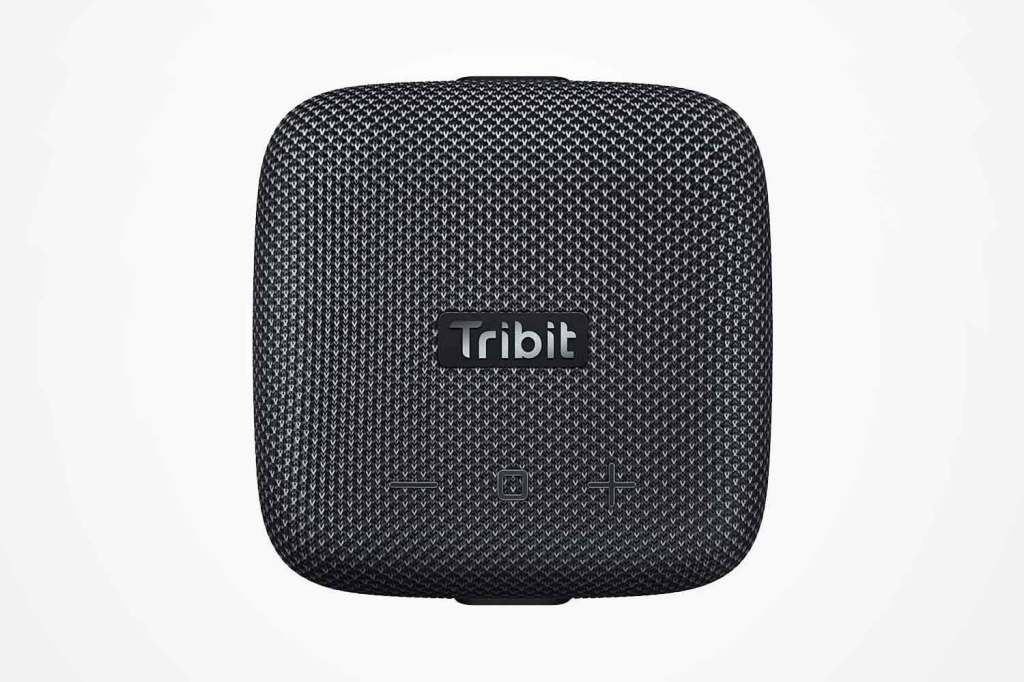
1. Tribit StormBox Micro 2
Stuff Verdict
Compact, affordable, and sounds great for its size – this is the best outdoor speaker around
Pros
- Sounds good despite diminutive size
- USB-C charging
- App features a nice extra
Cons
- Not the best at loud volumes
| Tribit StormBox Micro specs | |
|---|---|
| Waterproof rating | IP67 |
| Battery life | 12 hours |
The award-winning StormBox Micro 2 is a seriously tiny speaker that’s won fans over with incredible power, clarity, and bass for its size. Despite its pocketable stature, it still offers 12 hours of use per charge, with fast USB-C charging thrown in for good measure.
An IP67 waterproof rating lets it shrug the elements off with ease, while a handy clip lets it attach to anything from bags and handlebars, to poles and tree branches.
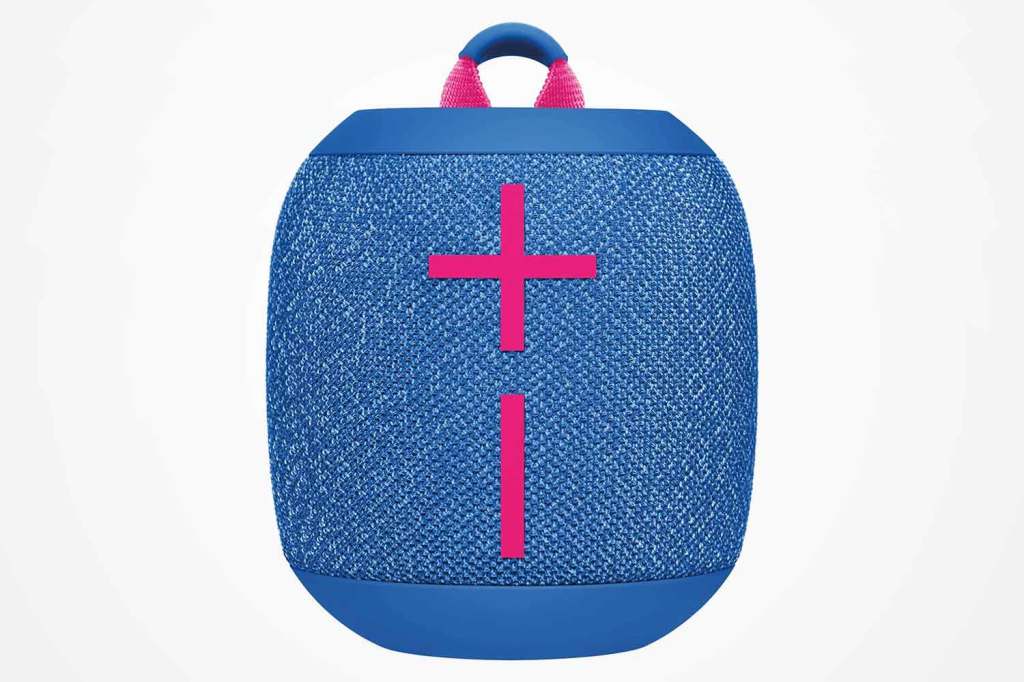
2. Ultimate Ears Wonderboom 3
Stuff Verdict
Bright and fully waterproof, the Wonderboom 3 is perfect for pool parties
Pros
- Fun design
- Fully waterproof
- Sounds great
Cons
- microUSB charging
| Ultimate Ears Wonderboom 3 specs | |
|---|---|
| Waterproof rating | IP67 |
| Battery life | 14 hours |
Capable of impressive sound despite its more compact package, the Wonderboom 3 offers enough juice to blast out tunes for 14 hours, with 360-degree sound ensuring that no one misses any notes.
Waterproof, dustproof, and with the ability to float on water for maximum pool fun (it can even be submerged), it’s an ideal solution for those looking for a hardy compact speaker in a wide range of bright colours.
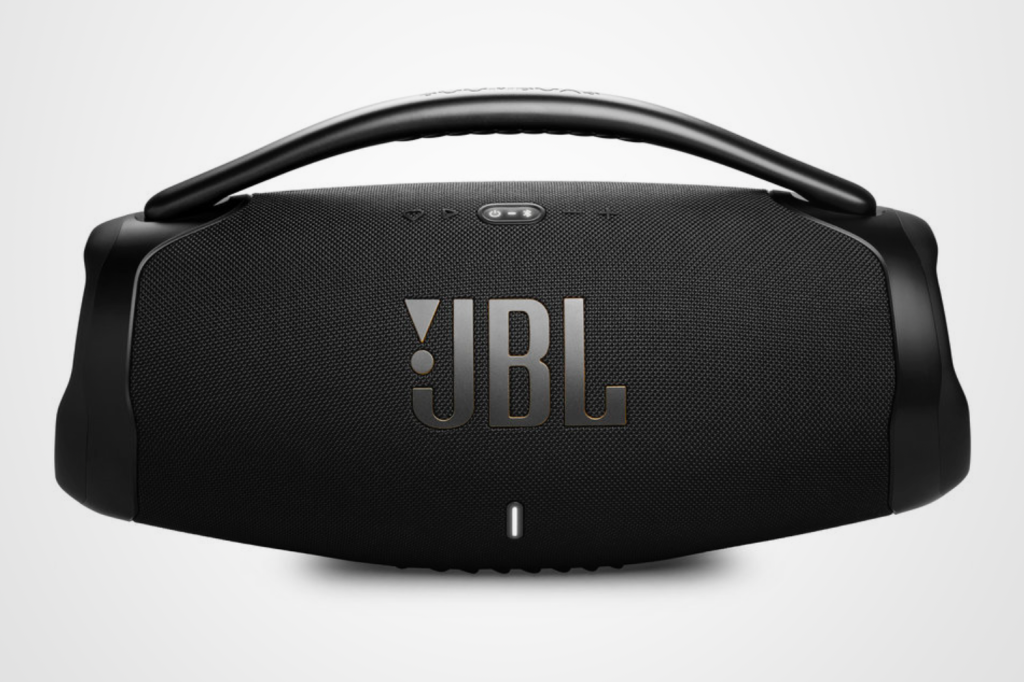
3. JBL Boombox 3 Wi-Fi
Stuff Verdict
If you’re after loud, bassy sound, then the JBL Boombox is the outdoor speaker for you
Pros
- Loud and bassy sound
- In-app EQ
Cons
- Heavy and large
- On the expensive side
| JBL Boombox 3 Wi-Fi specs | |
|---|---|
| Waterproof rating | IP67 |
| Battery life | 24 hours |
Forget tepid beer and charred patties: backyard grilling is all about that bass. And if meaty tunes are on the menu, this waterproof whopper is what you need. Beefy at 6.7kg, it pairs an 80W sub with two passive radiators to fatten up the beats. Plus this edition is seasoned with Wi-Fi. Still hungry? Use PartyBoost to create a sonic salad with compatible JBL jukeboxes.
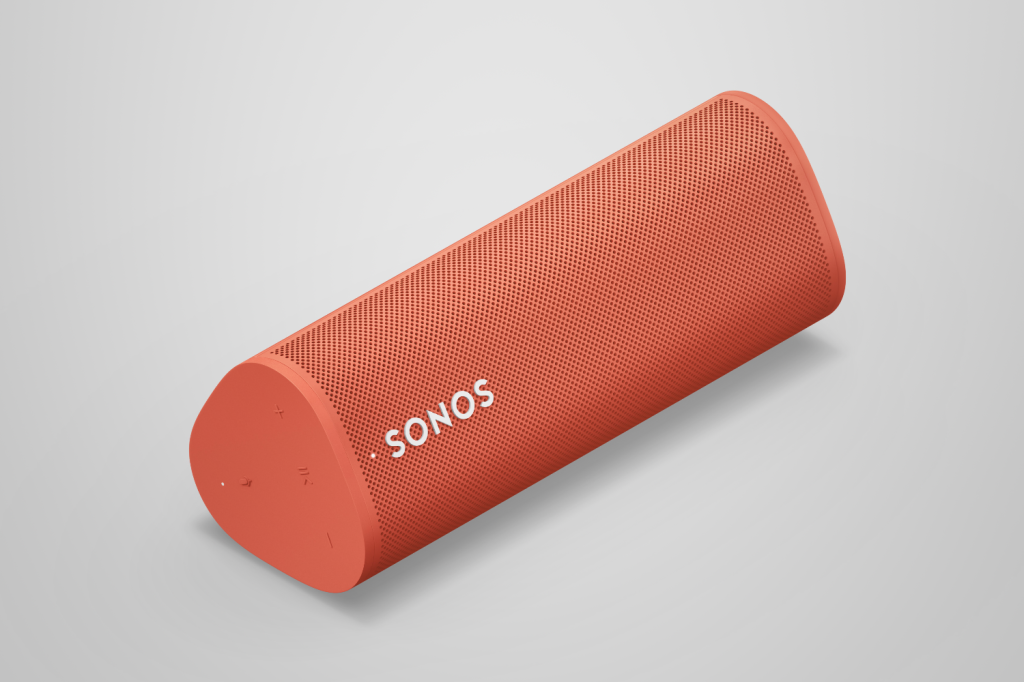
4. Sonos Roam
Stuff Verdict
An attractive, portable speaker with solid sound quality which works across Bluetooth and Wifi, the Sonos Roam ticks all the boxes
Pros
- Great design
- Excellent connectivity options
- Lightweight
Cons
- Bass is a touch gratuitous
| Sonos Roam specs | |
|---|---|
| Waterproof rating | IP67 |
| Battery life | 10 hours |
From main stage to acoustic tent, open-air audio is served in many settings. Don’t know your way around an equaliser? This satchel-friendly Sonos does the adjusting for you: shift to a different arena and Auto Trueplay tunes the output to suit your surroundings. Its premium build is worth of a headline slot, while IP67 waterproofing makes it an all-weather performer.
- Read more: Sonos Roam review

5. Bose SoundLink Flex
Stuff Verdict
This is a stylish speaker from Bose that packs water resistance and PositionIQ smarts
Pros
- Sleek, portable design
- Clear sound
Cons
- Not the most rugged
- Fixed EQ
| Bose SoundLink Flex specs | |
|---|---|
| Waterproof rating | IP67 |
| Battery life | 12 hours |
Boat parties might be a holiday highlight, but a submerged speaker will soon sink the vibes. Keep the fun afloat with this hardy hailer: buoyant by design, it’ll bob back up if you drop it in the drink. A steel grille and silicone shell reinforce its hardcore credentials, while PostionIQ smarts optimise the audio based on its orientation – whether hanging dry or lying on deck.
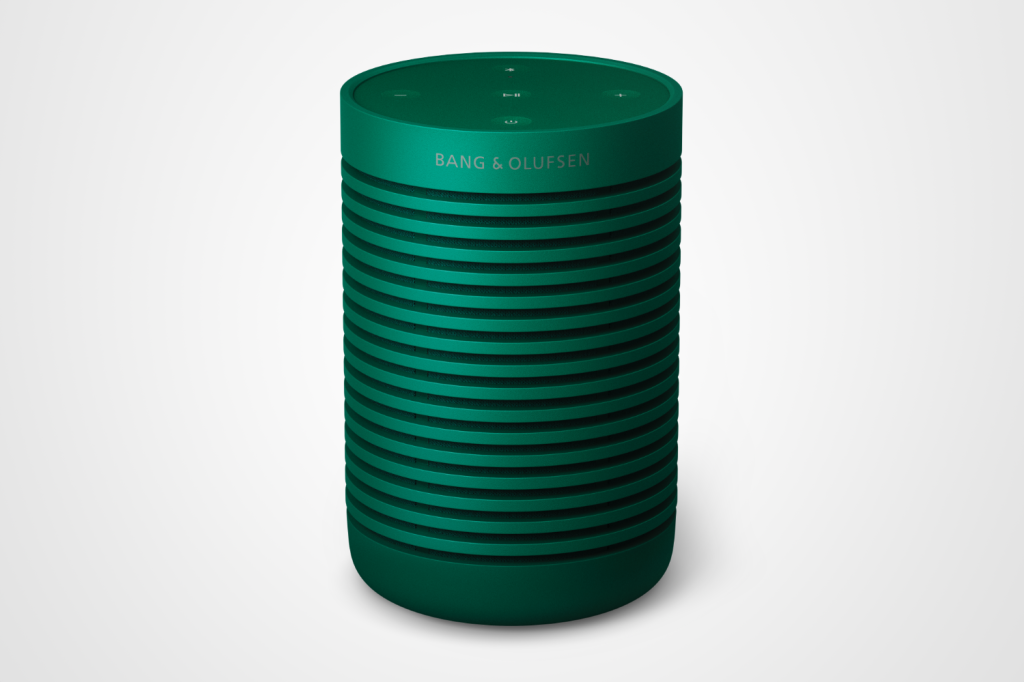
6. Bang & Olufsen Beosound Explore
Stuff Verdict
Mega battery life and a stylish design make this outdoors speaker standout
Pros
- Stylish yet durable design
- Excellent long battery life
Cons
- Physical controls aren’t the best
- No mic
| Bang & Olufsen Beosound Explore specs | |
|---|---|
| Waterproof rating | IP67 |
| Battery life | 27 hours |
Nothing says rugged like a built-in carabiner. Made small but tough, B&O’s clippable barrel is designed to take a beating. At 637g, its anodised aluminium armour can survive adventures without being a burden on your backpack.
Beneath its sheath lives a battery good for 27 hours, as well as drivers that deliver omnidirectional audio refined for the great outdoors.

7. Sony SRS-XG300
Stuff Verdict
The Sony SRS-XG300 brings the bass with a dedicated Mega Bass button
Pros
- Thumping bass
- Great app
Cons
- Forgettable looks
- On the expensive side
| Sony SRS-XG300 specs | |
|---|---|
| Waterproof rating | IP67 |
| Battery life | 25 hours |
Sony’s rather attractive minimalist speaker has curves in all the right places, along with the promise of clear sound, with plenty of bass to get things thumping. And if you aren’t convinced by the latter, the addition of a dedicated Mega Bass button should soon put your mind at ease.
With an IP67 water and dustproof rating, 25 hours of battery life, and some subtle lighting effects thrown in for good measure, it manages to combine all the right elements without being too gaudy.
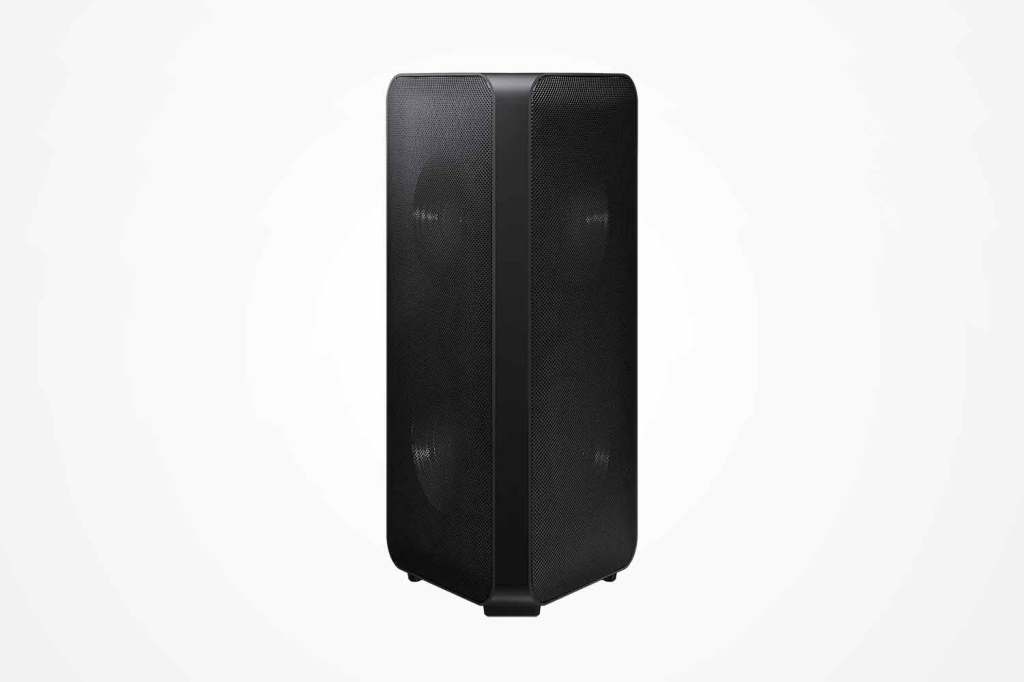
8. Samsung ST40B Sound Tower Speaker
Stuff Verdict
With 160W and RGB lights, this tower speaker from Samsung will be the centrepiece of any party
Pros
- Loud
- RGB lights built-in
- Play from multiple connected devices
Cons
- Only IPX5 rated (splash proof)
| ST40B Sound Tower Speaker specs | |
|---|---|
| Waterproof rating | IPX5 |
| Battery life | 12 hours |
If you need some serious audio chops for your next house/pool party, look no further than Samsung’s 160W tower. With a wide soundstage capable of reaching the far corners of even the largest gardens (with plenty of bass to match), your guest will love it.
Though we can’t say the same for any close neighbours. IPX5 water resistance offers peace of mind, while 12 hours of battery life is a respectable figure for something of this size and power. Built-in RGB lights, and the ability to play music from multiple connected devices are welcome additions to an already impressive bit of kit.
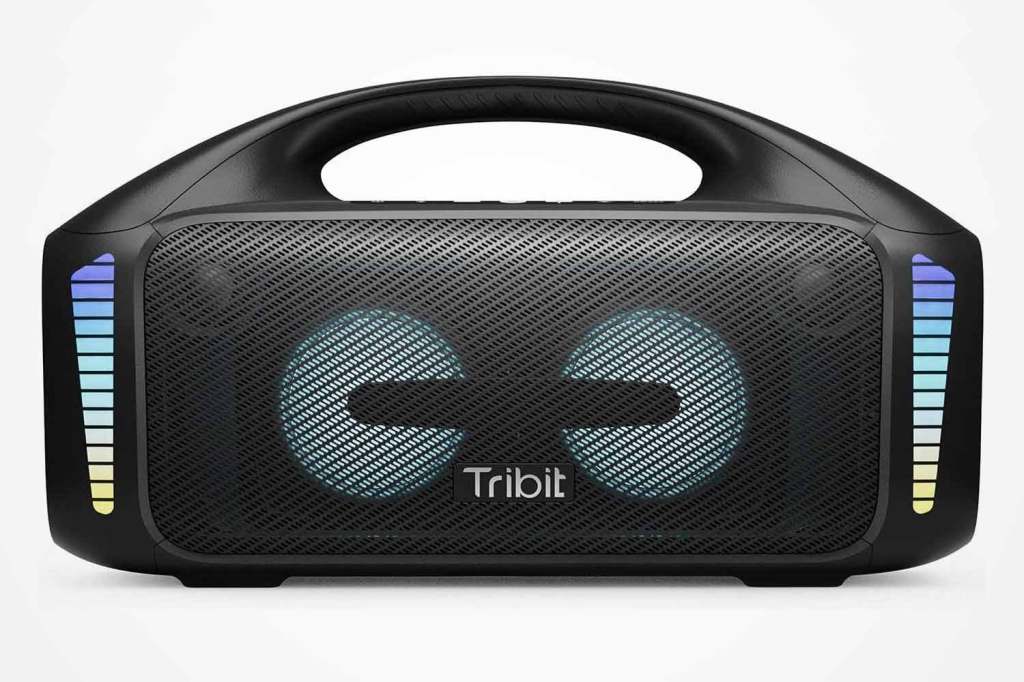
9. Tribit StormBox Blast
Stuff Verdict
This speaker is a party in a box, with IPX7 waterproof rating making it ideal for outdoor gatherings
Pros
- Great room-filling sound
- RGB lighting effects
- Charges other devices with USB-C
Cons
- No dust resistance
- XBass is not it
| Tribit StormBox Blast specs | |
|---|---|
| Waterproof rating | IPX7 |
| Battery life | 30 hours |
With a room-filling 90W power output and IPX7 waterproof rating, Tribit’s aptly-named StormBox Blast is ready for any party, inside and out. Its crisp, clear, and bassy results are matched by accompanying RGB lighting effects which, naturally, put on a light show in time with the music (in addition to indicating the current volume level).
You can switch the effects/colours on offer, or turn them off entirely if you’re after something more low-key, while a handy built-in handle and impressive 30 hours of battery life round off the specs rather nicely.
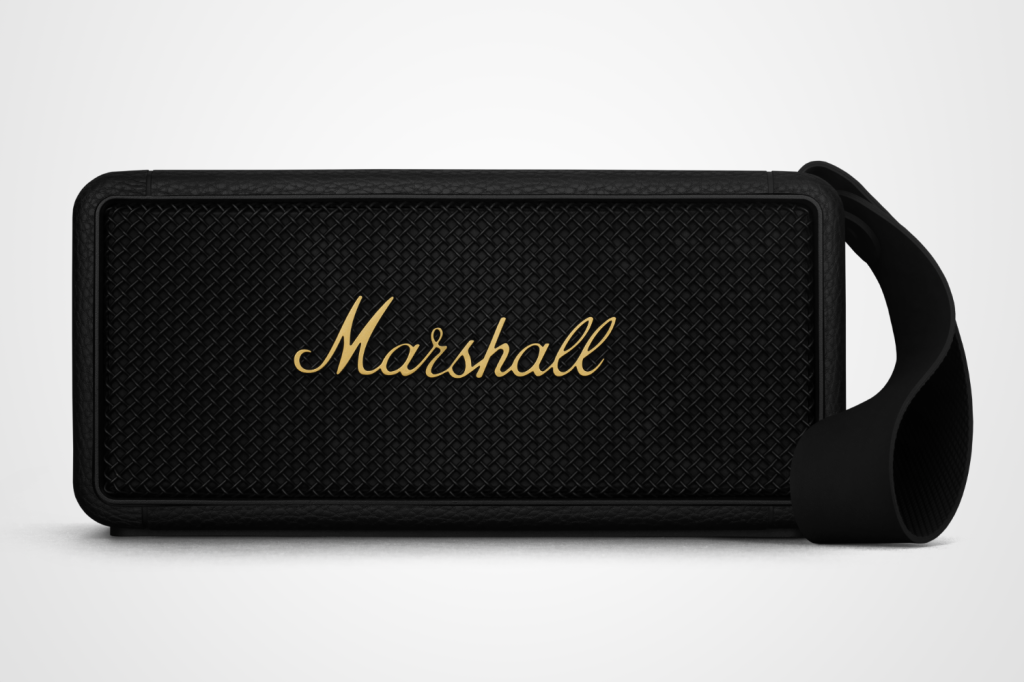
10. Marshall Middleton
Stuff Verdict
An outdoor speaker with a rich sound and distinctive retro looks, it’s made from recycled plastic
Pros
- Distinctive design
- Rich sound
Cons
- Design won’t be for everyone
- Expensive
| Marshall Middleton specs | |
|---|---|
| Waterproof rating | IP67 |
| Battery life | 20 hours |
Between big gigs and tour bus benders, life on the road can take its toll. Luckily, this mini amp from Marshall has the build to match its rock-star styling. Reassuringly solid at 1.8kg, the mighty Middleton is dustproof and water-resistant.
A multi-directional driver setup immerses all your roadies in the post-show playlist, while Stack mode lets you build a wall of sound. Its sturdy shell also uses recycled plastic, because nothing says punk like sustainability.
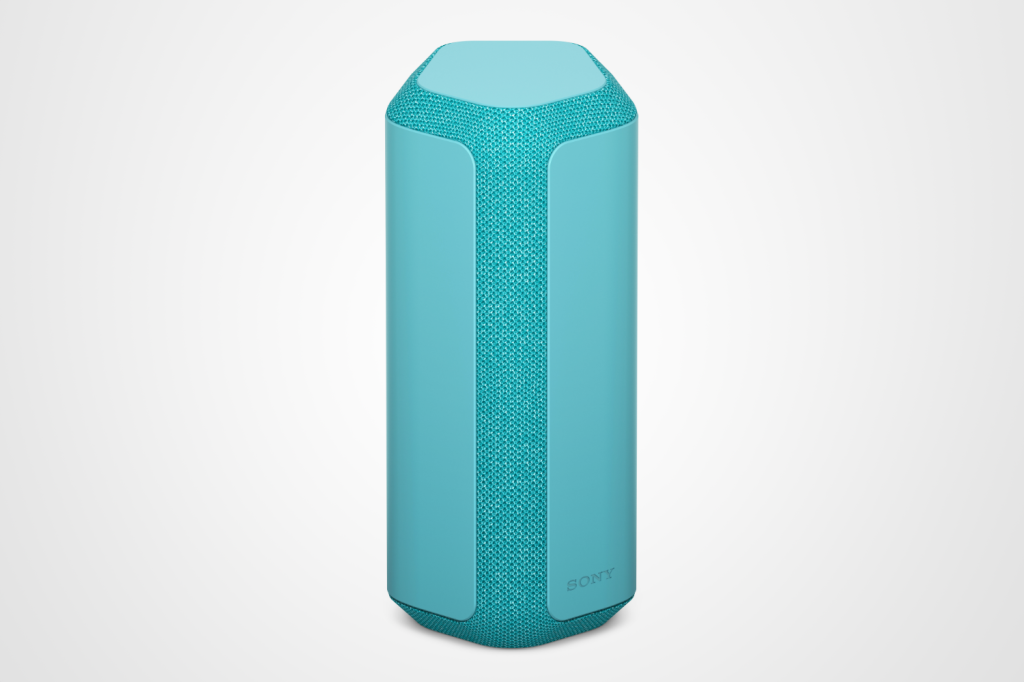
11. Sony SRS-XE300
Stuff Verdict
This Sony speaker packs plenty of audio smarts, with a-typical driver setup and shock-tested design
Pros
- Packs plenty of smarts
- Durable design
Cons
- No AUX input
- App is a bit rubbish
| Sony SRS-XE300 specs | |
|---|---|
| Waterproof rating | IP67 |
| Battery life | 24 hours |
Putting the ‘fun’ in fundamental scientific principles, this pentagonal player employs the physics of diffraction to spread the aural energy. Channelling sound through a narrow slot, it distributes waves over a wider area. The result? A consistent listen, front and side.
Shock-tested and shielded against the elements, it also saves battery by adjusting for background noise, while non-circular diaphragms use pressure to amp up the punch.

12. Ultimate Ears Hyperboom
Stuff Verdict
This megalithic cuboid hits the right angles: with power in spades, it majors on outdoor oomph
Pros
- Integrated mic
- Four audio source support
Cons
- Low water resistance rating and no dust proofing
- Weight makes it difficult to carry
| Ultimate Ears Hyperboom specs | |
|---|---|
| Waterproof rating | IPX4 |
| Battery life | 24 hours |
Toddlers might be entertained by empty boxes, but it takes more than cardboard to start a proper party. This megalithic cuboid hits the right angles: with power in spades, it majors on outdoor oomph. An IPX4 rating means it’s safe to splash, while an integrated mic helps it adapt the boom to the room. And thanks to four sources, you can divide the DJ duties.
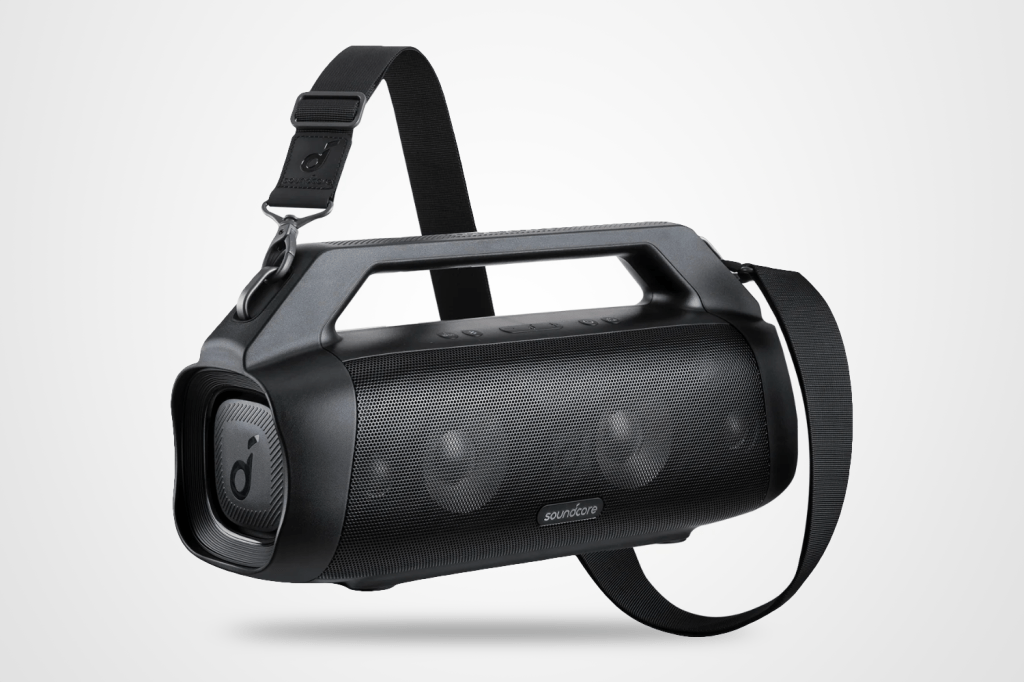
13. Anker Soundcore Motion Boom Plus
Stuff Verdict
A modern boombox with IP67 water resistance – this comes with a carry strap for even the most remote parties
Pros
- Handy carry strap
- EQ app is good
Cons
- Not the best build quality
| Anker Soundcore Motion Boom Plus specs | |
|---|---|
| Waterproof rating | IP67 |
| Battery life | 20 hours |
Trekking wisdom dictates that shoulders are for supplies. The trouble is, there are only so many melodies you can make by drumming on mess tins. Leave the backpacks to your hiking buddies and haul this hi-fi into the hills. Lug it by belt or handle and your reward will be 20 hours of punchy waterproof audio. Adjust it via the Soundcore app for better backcountry beats.
How to buy the best outside speaker
Buying an outside speaker is a lot like one of the best wireless speakers, Bluetooth speakers, or even the best cheap Bluetooth speakers.
Of course, the most important thing about buying an outdoor speaker is its weather resistance, since outdoor speakers will be exposed to the elements. It’s crucial, then, that the speaker you buy has some form of weather resistance or weatherproofing. Look for speakers with an IPX rating that indicates their resistance to water and dust. The higher the ratings, for example, IP55, IP56, IP57 etc, the more protection you’ll get.
It’s important to note that outdoor environments often require speakers with higher power ratings to overcome ambient noise and cover a larger area. So if you’re planning a backyard bash, you’ll want to consider the wattage of the speakers to ensure they can deliver the volume you need without distortion.
Consider also how you plan to play music from your outside speaker. Bluetooth speakers are easy to set up and use with mobile devices, while Wi-Fi speakers might offer better range and multi-room capabilities.
Once you’ve read this list, you might want to check out Stuff‘s guide to the best Bluetooth speaker, which is full of great options as well.
]]>That’s why we’ve rounded up some of the very best gas and charcoal outdoor grills to help make your buying decision that little bit easier.
If you’re in the UK, then you can check out our guide to the best BBQ.
What’s the best outdoor grill?
We reckon the Blackstone 4-Burner Griddle (buy now) is one of the outdoor grills in the US, thanks to the sheer convenience offered by its massive flat griddle surface area. Perfect for smash burgers, stir-fries, and much, much more, it’s as versatile to use as it is easy to clean.
Other best outdoor grill recommendations
If the Blackstone 4-Burner Griddle isn’t your cup of tea, no worries. There are plenty of other grills we know you’ll like.
The Traeger Timberline XL (buy now) has a gargantuan capacity, 24+ hour slow cooks, an induction side burner, and delicious, smokey results. What’s not to love?
The Nexgrill Deluxe 2-Burner Grill (buy now) is compact, smart, and with foldable shelves for an even tinier footprint, this no-nonsense gas-powered grill is ideal for smaller spaces.
The Napoleon Phantom Prestige 500 (buy now) is clad in black, with a generous capacity and handy infrared side burner for sharing steaks, this is one handsome (and capable) bit of grilling kit.
The best outdoor grills in the US you can buy today:

1. Blackstone 4-Burner Griddle
Stuff Verdict
If you can get past the lack of a flame-grilled finish, this is easily one of the best outdoor grills in the US that money can buy.
Pros
- Quick cooking
- Built-in air fryer!
Cons
- No flame grilling
- Build quality could be better
| Blackstone 4-Burner Griddle specs | |
|---|---|
| Fuel | Gas |
| Weight | 265.2 lbs |
Some people are put off by the lack of grill grates on a BBQ, which means they’re forever missing out on the joy that flat griddles can bring to your outdoor cooking game — and this gas-powered offering from Blackstone is one of the best ones around.
Its large flat surface makes it ideal for producing perfect smash burgers, thanks to the vast surface area on offer, making for complete contact with patties for a truly crispy finish. Anything from stirfries, and vegetables, to pancakes, steak, and more are all fair game, while built-in air-fryer drawers will come in incredibly handy for side dishes like fries.
If you can get past the lack of a flame-grilled finish, this is easily one of the best outdoor grills in the US that money can buy.
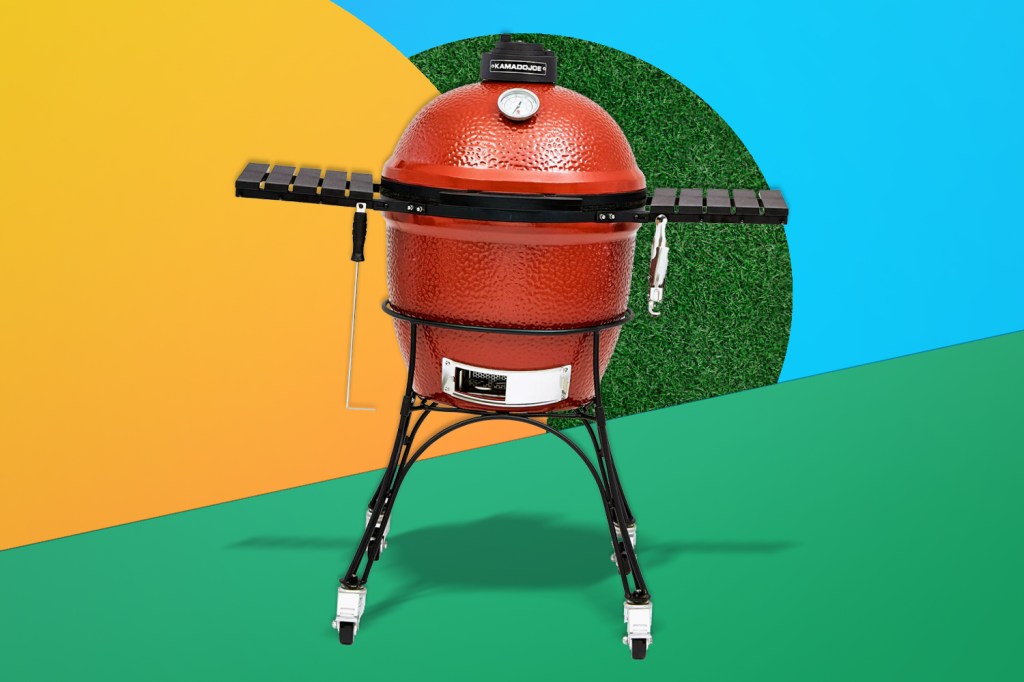
2. Kamado Joe Classic Joe 18in Charcoal Grill
Stuff Verdict
Kamado Joe’s most popular entry level grill imparts a rich, smoky flavor to meats, fish and vegetables.
Pros
- Ash draw for easy cleanup
- Perfect for smoking
Cons
- Can take a while to heat
- Not ideal for big cookouts
| Kamado Joe Classic specs | |
|---|---|
| Fuel | Charcoal |
| Weight | 188 lbs |
Instantly recognisable and undeniably eye-catching, Kamado Joe’s 18in charcoal grill features a thick-walled, heat-resistant shell that locks in delicious smoke and moisture for sumptuous slow-cooked perfection.
Its two-tier system lets you tackle multiple dishes at once, while a cast iron top vent lets you maintain consistent air settings for smoking at temps from 225F all the way up to a smouldering 750F.
With a whole host of compatible accessories to let you mix and match cooking styles, the results are bound to be as delicious, while cleanup is easily taken care of by a handy slide-out ash drawer.
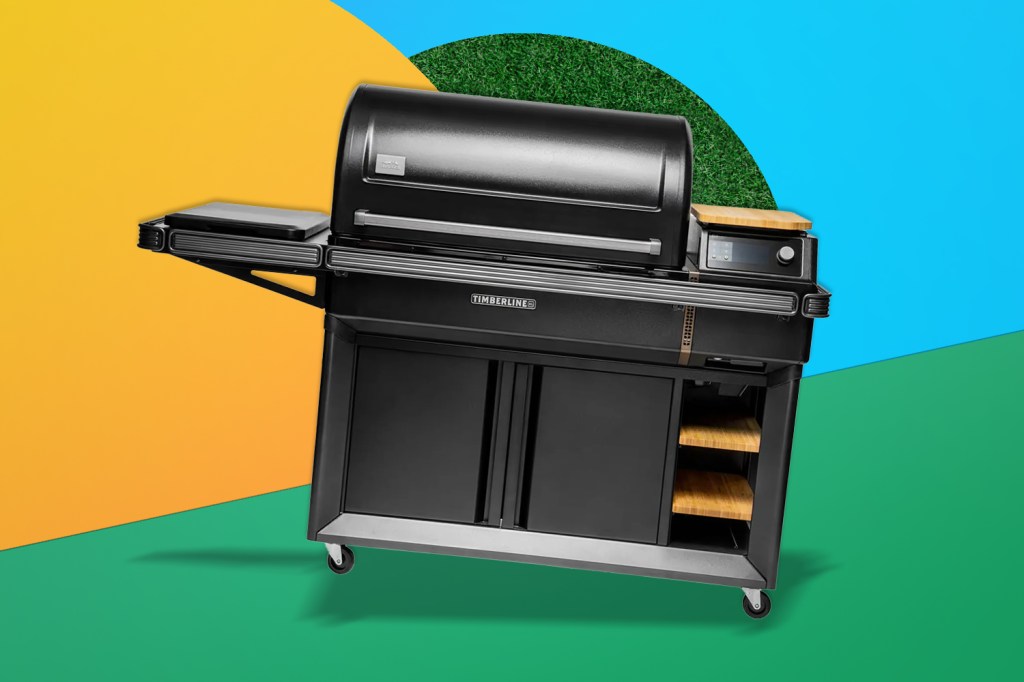
3. Traeger Timberline XL
Stuff Verdict
From classic slow-smoked BBQ to gourmet multi-course meals, there’s nothing this impressive Timberline can’t do.
Pros
- Consistent cooking temperatures
- Ultimate wood-fired flavour
Cons
- Very expensive
- Is Wi-Fi really necessary in a grill?
| Traeger Timberline XL specs | |
|---|---|
| Fuel | Wood pellet |
| Weight | 289 lbs |
The Traeger Timberline XL is a premium bit of kit for those who love deliciously juicy, smokey, slow-cooked delicacies. Capable of slow-cooking and smoking its contents for more than 24+ hours, the fall-off-the-bone results will make you a legend in your circle of BBQ enthusiasts.
It’s all thanks to a built-in capacious wood pellet container (complete with automatic pellet feeder), which, combined with a handy app, lets you keep on top of cook times and temps too. This means you can spend more time with guests, and/or chilling inside while the Timerline XL works its magic.
With enough space for 12 chickens, 16 rib racks, or 12 pork butts (and a built-in induction cooktop for cooking and searing side dishes), this is an investment that will pay mouth-watering dividends for years to come.
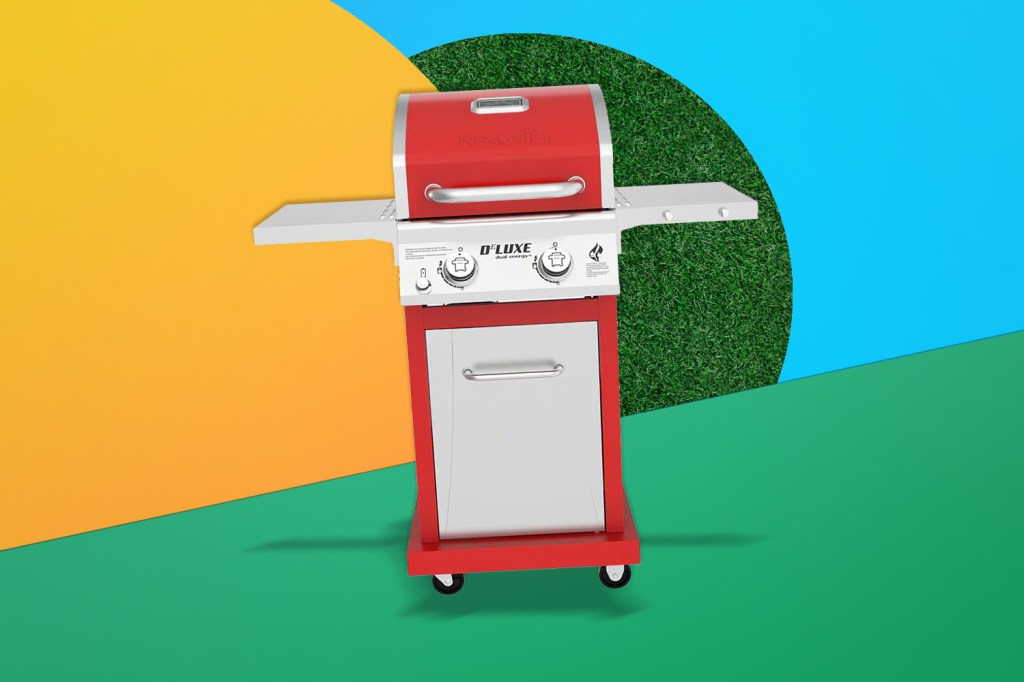
4. Nexgrill Deluxe 2-Burner Grill
Stuff Verdict
This compact two-burner grill is ideal for smaller places where space is a premium.
Pros
- Compact design
- Flame tamers prevent flare-ups
Cons
- Not for big parties
- Tricky to assemble
| Nexgrill Deluxe 2-Burner Grill specs | |
|---|---|
| Fuel | Gas |
| Weight | 81 lbs |
This compact two-burner grill is ideal for smaller places where space is a premium, with folding side shelves reducing its total footprint to impressively minute levels.
While it might not be enough to feed an entire Superbowl party, it’s more than enough for small gatherings, and can be converted for use with natural gas quickly and easily, thanks to dual energy valves.
With angled stainless steel flame tamers to prevent dripping and flare-ups, wheels for easy transportation, and slick electronic ignition, it’s a masterclass in compact flame-grilled convenience.
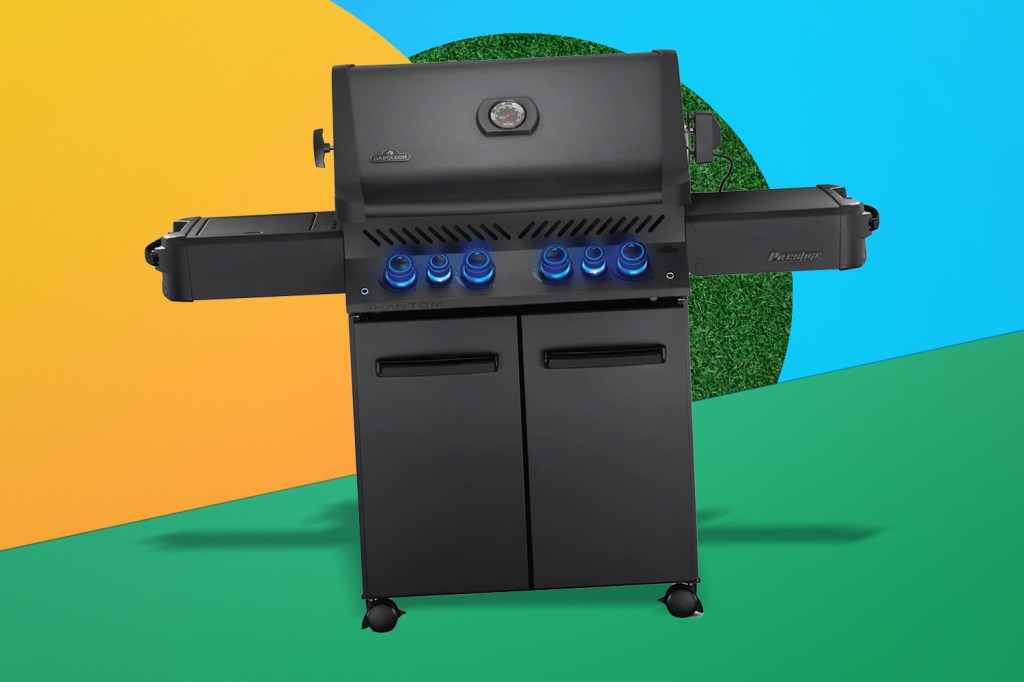
5. Napoleon Phantom Prestige 500
Stuff Verdict
Grill in style with the premium Phantom matte black grill, complete with RGB LEDs. Oh, the grilling performance is flawless, too.
Pros
- Matt black design with RGB LEDs
- Reliable ignition system and built-in thermometer
Cons
- On the expensive side
| Napoleon Phantom Prestige 500 specs | |
|---|---|
| Fuel | Gas |
| Weight | 203 lbs |
Black never goes out of fashion. It’s stealthy. It’s mysterious. It absorbs light like no one’s business. And if you yourself embrace the shadows, then you can’t get a more suitable grill than the Phantom Prestige from Napoleon.
Clad in black from lid to wheel, its imposing presence is matched only by its barbequing prowess. Standout features include a large 500-square-inch cooking area, a warming rack, an infrared side burner (perfect for searing steaks), and even a rotisserie kit.
Throw in a reliable ignition system, built-in thermometer, and LEDs for comfortable low-light use, and you’ve got yourself a grill that Bruce Wayne himself would be proud to have lurking in the nooks of the Batcave.
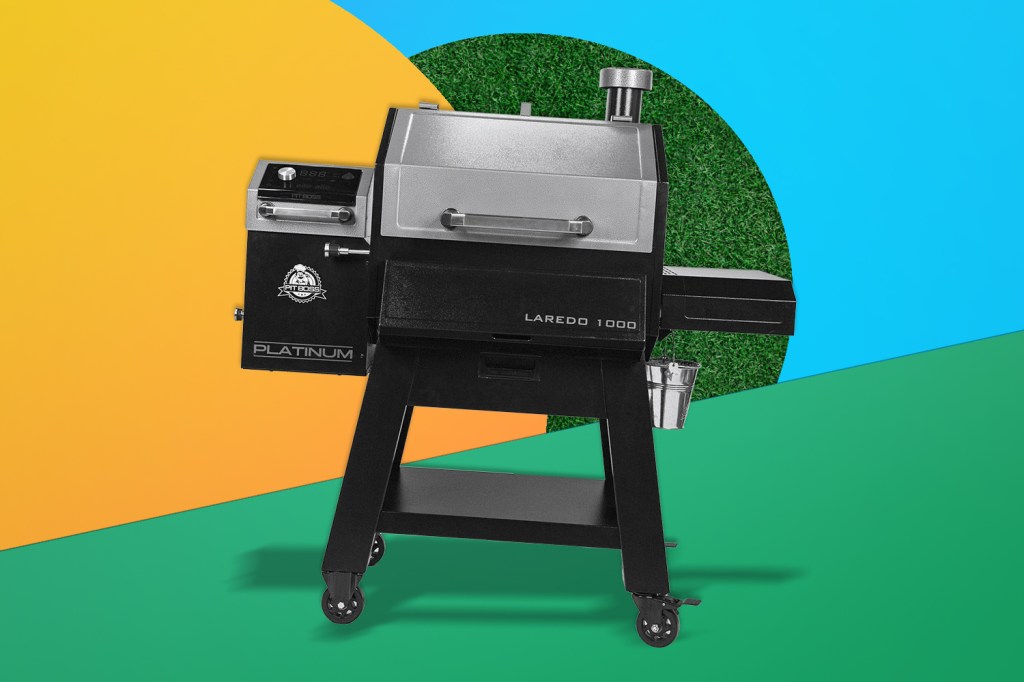
6. Pit Boss Platinum Laredo 1000
Stuff Verdict
This affordable grill is packed with impressive features, including app connectivity, included meat probes, built-in lighting and an ash cleanout system.
Pros
- Affordable alternative to Traeger
- Two meat probes included
Cons
- Not great as a smoker
- Takes a while to reach temperature
| Pit Boss Platinum Laredo 1000 specs | |
|---|---|
| Fuel | Wood pellet |
| Weight | 181 lb |
Pit Boss’ more compact pellet grill and smoker is a more affordable alternative to Traeger’s Timberline XL, making it more suitable for those tight on space and/or budget.
With a smart black/chrome finish, it looks the business, with app connectivity for letting you manage your cook remotely and two stainless steel meat probes included for extra accuracy.
Built-in grill lighting will come in handy for nighttime cooks, while an ash cleanout system makes for a tidier post-meat coma cleanup.
How to buy the best outdoor grill
In the market for an outdoor grill or barbecue? There are several important factors to keep in mind to ensure you make the right choice for your outdoor cooking needs.
The first thing you’ll need to decide on is the type of grill you want. You can choose from three main options: charcoal, gas, or electric grills (more on that in the next section).
Size matters definitely matters when it comes to grills – think about how many people you typically cook for. Do you regularly host larger gatherings and special events, or do you cook a few burgers at the weekend for yourself and your partner? A grill that’s the correct size will make your life much easier.
If you don’t need a large grill, then you could consider a portable grill, which allows you to grill in multiple locations.
Grill material is another crucial aspect to consider. Stainless steel or cast iron grates are highly recommended due to their durability and their ability to retain heat effectively.
This also has an impact on the ease of cleaning and maintenance (this is essential for the long-term care of your grill). You’ll want a grill with removable grates and a drip pan for efficient grease collection.
If you’re serious about outdoor cooking, heat output is paramount for achieving that perfect sear and cooking various types of food effectively. You’ll want to check the grill’s BTU (British Thermal Units) rating to gauge its heating power and suitability for your needs.
On top of this, you’ll want precise temperature control for achieving consistent cooking results. Opt for a grill with adjustable controls to fine-tune the heat to your liking.
For really serious grillers, some models come with extra features such as side burners, warming racks, rotisserie kits, and integrated thermometers.
Charcoal vs. Gas vs. Electric
Are you having trouble deciding between a charcoal, gas or electric grill? Here’s a rundown of the pros and cons of each model.
Charcoal grills offer a unique, almost primal, grilling experience, characterized by their ability to impart a smoky flavour to food. They excel in achieving high temperatures, making them ideal for searing steaks and achieving a crispy exterior on meats.
However, charcoal grills come with a learning curve, as lighting and temperature control can be more challenging. Cleanup can also be messy due to charcoal ash, and they typically take longer to preheat.
They are, however, affordable and portable, making them a popular choice for many.
Gas grills provide unparalleled convenience, starting quickly with the push of a button and offering precise temperature control. They are known for consistent and even heating, making them versatile for various cooking techniques. They also produce minimal mess and are relatively easy to clean.
Gass grills do, however, lack the smoky flavour of charcoal, you can enhance it by adding wood chips or chunks. Gas grills can be more expensive upfront, but they come with features like side burners and rotisserie attachments. They also require a steady supply of propane tanks or a natural gas connection.
Finally, electric grills are incredibly user-friendly, ideal for beginners and versatile for both indoor and outdoor use. They don’t require any fuel; you simply plug them in, and they’re ready to cook within minutes.
While they lack the smoky flavour of charcoal or gas, they offer even heating and consistent results. Electric grills are compact and may lack the cooking area of larger gas or charcoal models.
They are, of course, dependent on access to electrical outlets, which may not be practical in all outdoor settings.
Now check out the best camping accessories.
]]>Some providers like BT and Virgin offer their own mesh network add-ons with select packages that work specifically with their home hubs; other router makers incorporate mesh smarts into their modems to tempt you into staying with the same brand if you expand your network.
In truth, it doesn’t really matter which network you opt for as most will work with your provider. They’re not exactly cheap, but could come in cheaper than a kneejerk reaction to upgrade your broadband package. Here are some that we like the look of.
What’s the best mesh Wi-Fi system?
The Amazon eero 6 mesh (buy now) offers up Wi-Fi 6 speeds for a lot less, that’s why we think it’s the best mesh Wi-Fi network for most people. Amazon’s eero system adds plenty of bang for your buck, with friendly, curvy looks to match.
Other mesh Wi-Fi system recommendations
Before we jump into the full list of the best mesh Wi-Fi systems you can currently buy, here’s a quick look at our top three alternative selections:
The Netgear Orbi WiFi 6E RBKE963B (buy now) has slick, menacing looks and an expensive price tag, but packs blistering-fast speeds of up to 10.8Gbps.
The Google Nest Wi-Fi Pro (buy now) are sweet-like mesh devices that have a delightfully glossy, curvy look to them that belies their utilitarian function.
The Devolo Magic 2 (buy now) is an affordable powerline/mesh network adaptor that might not offer the absolutely latest specs, but they’re still more than enough to offer speedy flexibility for most people’s needs.
The best mesh Wi-Fi routers you can buy today:
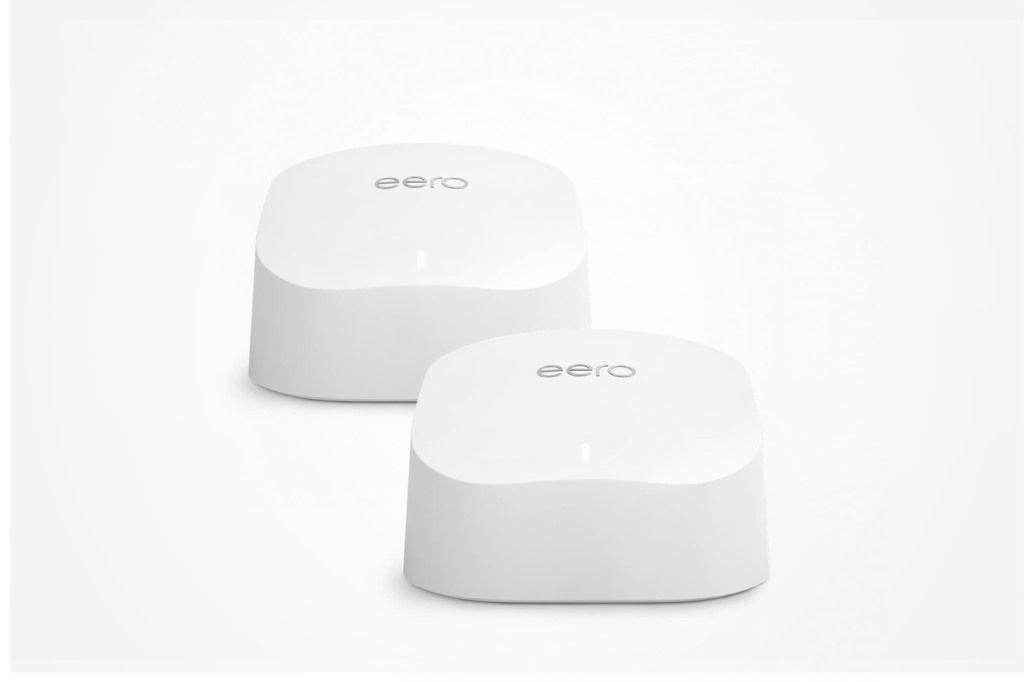
1. Amazon eero 6 mesh Wi-Fi 6 router system
Stuff Verdict
If you’re after Wi-Fi 6 speeds for a lot less, then Amazon’s eero system offers plenty of bang for your buck, with friendly, curvy looks to match
Pros
- Great performance
- Easy to setup and manage
- Affordable price
Cons
- Extra features require a subscription
- No USB connectivity
| Amazon eero 6 mesh Wi-Fi 6 router system specs | |
|---|---|
| Speed | 900 Mbps |
| Coverage | 3000 sq f |
| Extra features | eero Secure (extra cost) |
If you’re after Wi-Fi 6 speeds for a lot less, then we think Amazon’s eero system offers plenty of bang for your buck, with friendly, curvy looks to match.
Capable of supporting speeds up to 900 Mbps (and with a pair of routers covering 140 square metres), they’re clearly not as souped-up as Netgear’s super-premium Orbi rivals above. But it’s hard to argue against the still-decent features, combined with the far, far more palatable price.
Throw in built-in Zigbee smart hub powers, Alexa support, and support for more than 75 devices, and you’ve got one of the best home mesh router setups for most people.
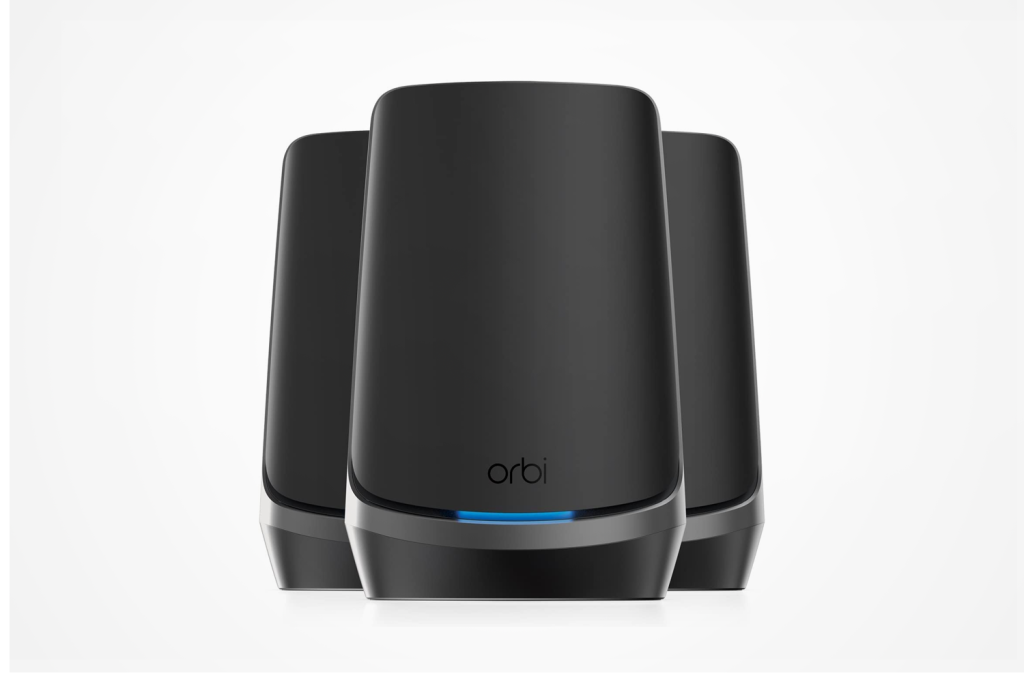
2. Netgear Orbi WiFi 6E RBKE963B
Stuff Verdict
With slick, menacing looks and an expensive price tag, the Orbi packs blistering-fast speeds of up to 10.8Gbps
Pros
- Ultimate performance
- Large coverage
Cons
- Very expensive
- Some features require subscription
| Netgear Orbi WiFi 6E RBKE963B specs | |
|---|---|
| Speed | 10.8Gbps total |
| Coverage | 7500 sq. ft |
| Extra features | Orbi App + Netgear Antivirus + Netgear Parent Controls |
The first thing you’ll notice about the Orbi RBKE963B (beyond its delightful model number), is its slick, menacing, and oh-so-stylish black paint job. While it also comes in white, we’re hopelessly besotted by its Sith-like looks — but less so with its absolutely eye-watering price tag.
Comfortably the most expensive option on our list, it’s a choice for only the most bleeding-edge users, who want one of the fastest, most high-end setups around, with the gear and workload to match.
With blistering-fast speeds of up to 10.8Gbps, along with the latest 6GHz band to support the latest Wi-Fi 6E devices, you’ll be enjoying unhampered speeds with any Wi-Fi 6-toting PCs, smartphones, and more.
With multiple ethernet ports per router and two satellites covering a massive area of around 700 square metres between them, this is one of the very best home internet solutions around, period. If you’ve got the cash, and the need for speed, look no further.

3. Google Nest Wi-Fi Pro
Stuff Verdict
If you’re after something different, glossy, and minimal, this is a great option if you’re a fan of the Google ecosystem
Pros
- Minimal, pebble-like design
- Great app and software
Cons
- More affordable rivals
- Limited settings
| Google Nest Wi-Fi Pro specs | |
|---|---|
| Speed | 4.2 Gbps |
| Coverage | 3400 sq ft |
| Extra features | Proactively monitors and fixes common issues, guest networks, Matter support, Thread, parental controls |
Google’s homegrown Wi-Fi 6E mesh router system will turn heads with its fat Tic Tac-like design, and it won’t be for everyone. But if you’re after something different, glossy, and minimal, then there’s a certain charm to them that we can’t argue against.
Looks aside, they offer a very reasonable package for the price, with the latest Wi-Fi standards, nippy speeds, and up to 120 square metres of coverage per individual unit.
Amazon’s eero system has it beat when it comes to value for money, but if you’re a fan of the Google ecosystem and/or love the curvy design, then this is the option for you.

4. Devolo Magic 2
Stuff Verdict
More affordable than mesh Wi-Fi, the Magic 2 banishes internet black spots with powerline power
Pros
- Easy setup
- Ideal for areas where Wi-Fi can’t reach
Cons
- Performance depends on home wiring
- Not as fast as Wi-Fi 6
| Devolo Magic 2 specs | |
|---|---|
| Speed | 2400Mbs wired / 1800Mbs Wi-Fi |
| Coverage | Wherever there’s mains power |
| Extra features | None |
While the Devolo Magic 2 is technically one of the best powerline adaptors, it’s we think it deserves a place on this list because it also doubles up as a mesh network, offering the ultimate in wired/wireless flexibility.
Capable of reducing dead zones and providing important devices like PCs with Ethernet connectivity, this is a fairly inexpensive way to get the best of both worlds. Sure, there are faster alternatives out there, but its Wi-Fi speeds should still be more than enough for most people, especially at this price.
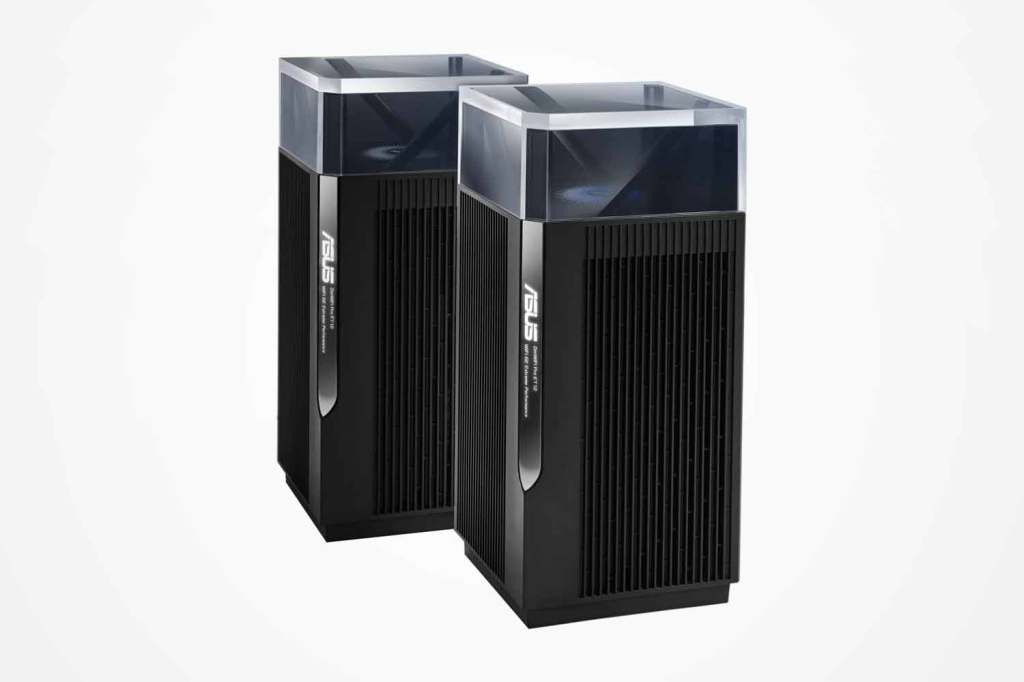
5. Asus ZenWiFi Pro ET12
Stuff Verdict
Justifing its eye-watering price with a Wi-Fi 6E mesh system, with blistering top speeds of 11Gbps, covering an area of 6,000 sq ft
Pros
- Easy to install
- Future proof performance
Cons
- Bold design won’t fit all decors
| Asus ZenWiFi Pro ET12 specs | |
|---|---|
| Speed | 11000 Mbps |
| Coverage | 6,000 Sq. ft |
| Extra features | VPN, DDNS, content filtering |
If you’re serious about home networking and don’t mind paying through the nose for one of the best offerings out there, then you might want to consider the high-end Asus ET12.
It justifies its eye-watering price with a Wi-Fi 6E mesh system, with blistering top speeds of 11Gbps, covering an area of 6,000 sq ft. Other standout features that we appreciate include a 6 GHz band to minimise interference, the ability for 12 simultaneous streams, clever RangeBoost Plus technology, and a design that looks like it’s been lifted from the dashboard of an alien starcruiser.
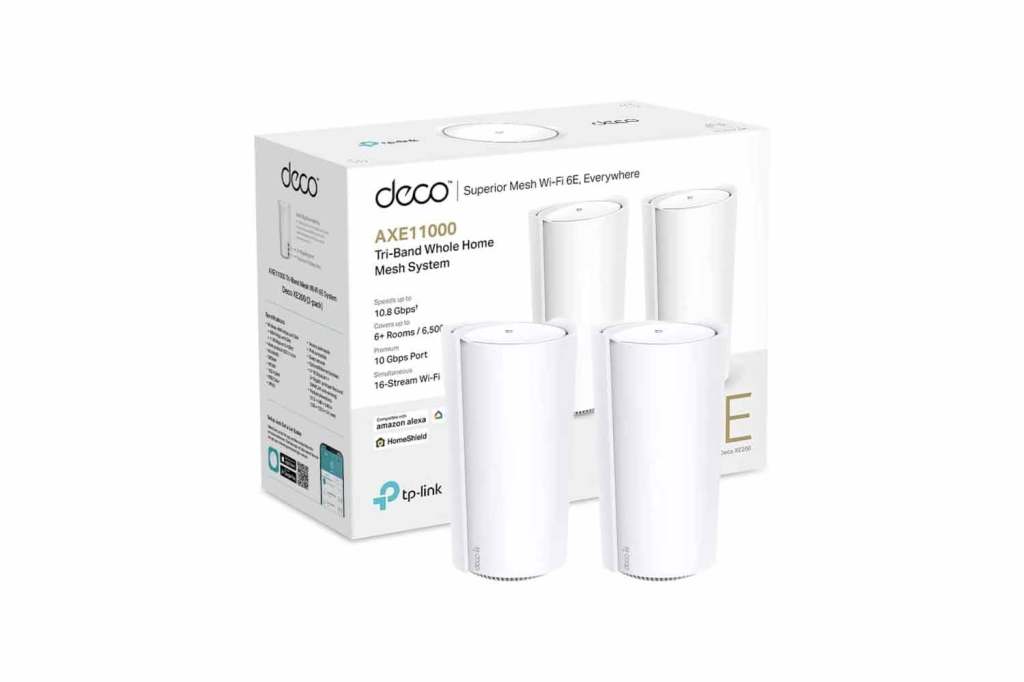
6. TP-Link Deco XE200
Stuff Verdict
The best mesh routers for most people looking to squeeze every last bit of performance out of their network
Pros
- Stunning speeds
- Wi-Fi 6E
- Simple setup and good app
Cons
- Clinical design
| TP-Link Deco XE200specs | |
|---|---|
| Speed | 4804 Mbps (6 GHz) + 4804 Mbps (5 GHz) + 1148 Mbps (2.4 GHz) |
| Coverage | 6500 ft2 |
| Extra features | TP-Link HomeShield |
TP-Link’s new Deco XE200 is packed to the circuit boards with the latest and greatest tech, making it one of the best home mesh routers currently available.
Using a 6 GHz band to minimise congestion (with speedy, robust connectivity to boot), it’s powered by an AI-Driven Mesh, which intelligently learns your network environment to provide the best Wi-Fi setup for your home. Not only that, but it’s capable of supporting a massive 200 devices at once, over a generous 6,500 sq ft range, covered by two mesh devices.
Throw in 16-Stream Wi-Fi (which provides simultaneous data transmission with 16 streams for greater bandwidth so multiple users can stream, game and work without problems), and you’ve got yourself a seriously comprehensive bit of kit. You’ll pay a hefty price for it, mind, but if you and your family are forever streaming, downloading, uploading, and generally hammering away at your network, this could be the solution for you.

7. TP-Link Deco PX50
Stuff Verdict
The Deco PX50 stands out from the crowd by offering something that’s truly unique, mixing powerline and mesh Wi-Fi
Pros
- Affordable price
- Can reach the hardest to reach spots
Cons
- Powerline doesn’t work with all houses
- Speed depends on powerline
| TP-Link Deco PX50 specs | |
|---|---|
| Speed | 574 Mbps (2.4 GHz) + 2402 Mbps (5 GHz) + 1500 Mbps (powerline) |
| Coverage | 4500 sq.ft |
| Extra features | HomeShield security |
The Deco PX50 stands out from the crowd by offering something that’s truly unique, and, quite frankly, extremely useful.
At first glance, this pair appears to be like any other mesh router offering, with an understated black and white cylindrical design that’ll help them blend in with the rest of your smart home setup. Their real beauty though, lies in their built-in powerline skills.
Rather than relying on wirelessly chaining up their Wi-Fi signals, so to speak, individual PX50 units can rely instead on powerline technology to share their connections, making them an absolute godsend for larger homes and/or those with incredibly thick walls.
Not only are you getting up to 1500 Mbps Wi-Fi 6 speeds, but a pair will also comfortably cover up to around 420 square metres. If you’re worried about having to spend more on a triple-pack with other brands, then the PX50’s built-in powerline magic could save you some cash, with more reliable performance to boot.
- Read more: Best powerline adaptors
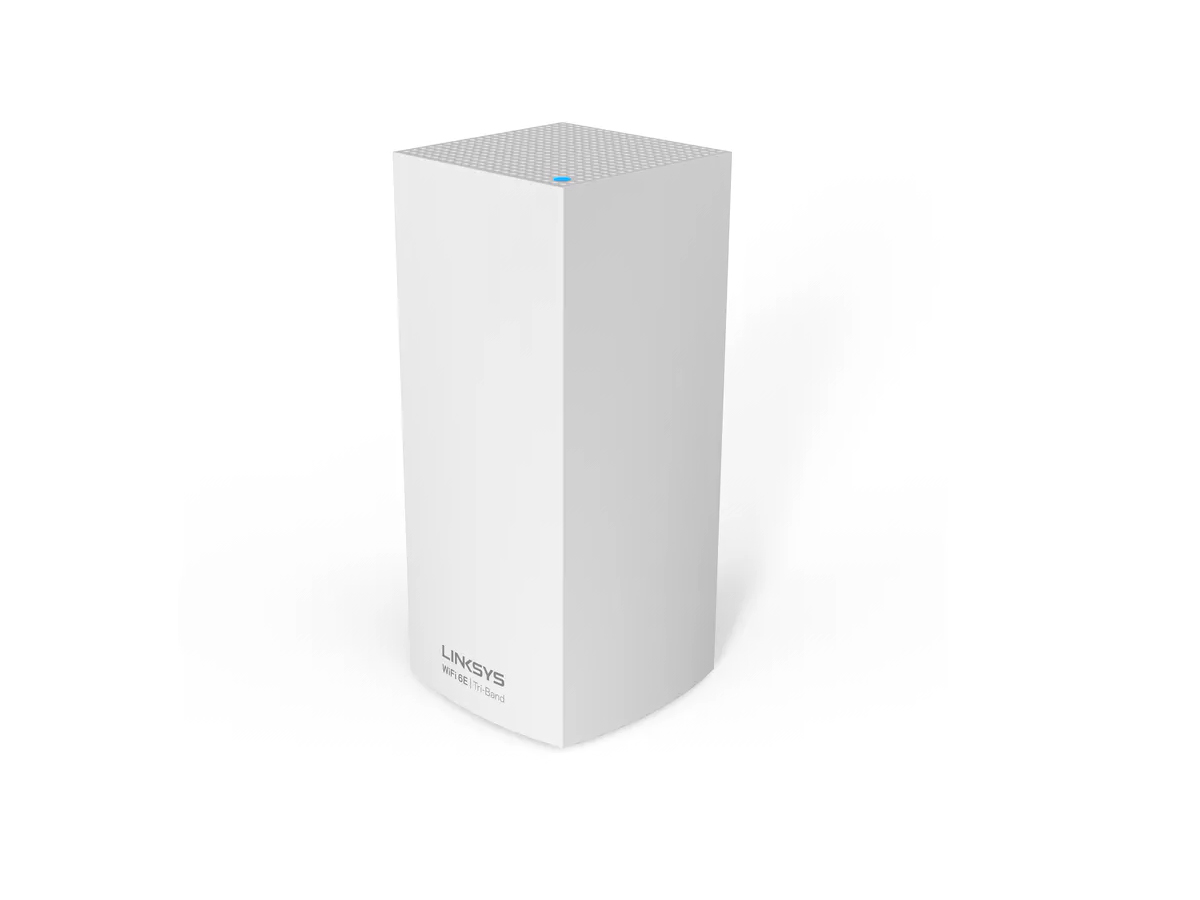
8. Linksys AXE8400
Stuff Verdict
Yes, Linksys is expensive, but it’s capable of managing the demands of more than 65 devices
Pros
- Simple setup
- Bags of bandwidth
Cons
- Clinical design
- Not the fastest out there
| Linksys AXE8400 specs | |
|---|---|
| Speed | 5.4 Gbps total |
| Connectivity | 5400 sq ft |
| Features | Parental controls, |
Linksys was hot off the blocks in 2017, launching one of the first true home Wi-Fi mesh networks. In truth, we found the original Velop system to be pretty buggy and the nodes suffered from numerous dropouts.
But superfast broadband wasn’t built in a day… and now Linksys has something new. The AXE8400 system retains the brand’s usual straight-up tower-like design, only now it packs in Wi-Fi 6E technology for blazingly fast speeds and superspreading of the good sort: bandwidth. In fact, Linksys says it can manage the demands of more than 65 devices.
The catch is that it’s very expensive indeed – about a grand for a three-node pack – but then, each node is supposed to be good for 3000ft2 of coverage. It’s worth noting that the AXE8400 is also backwards-compatible.
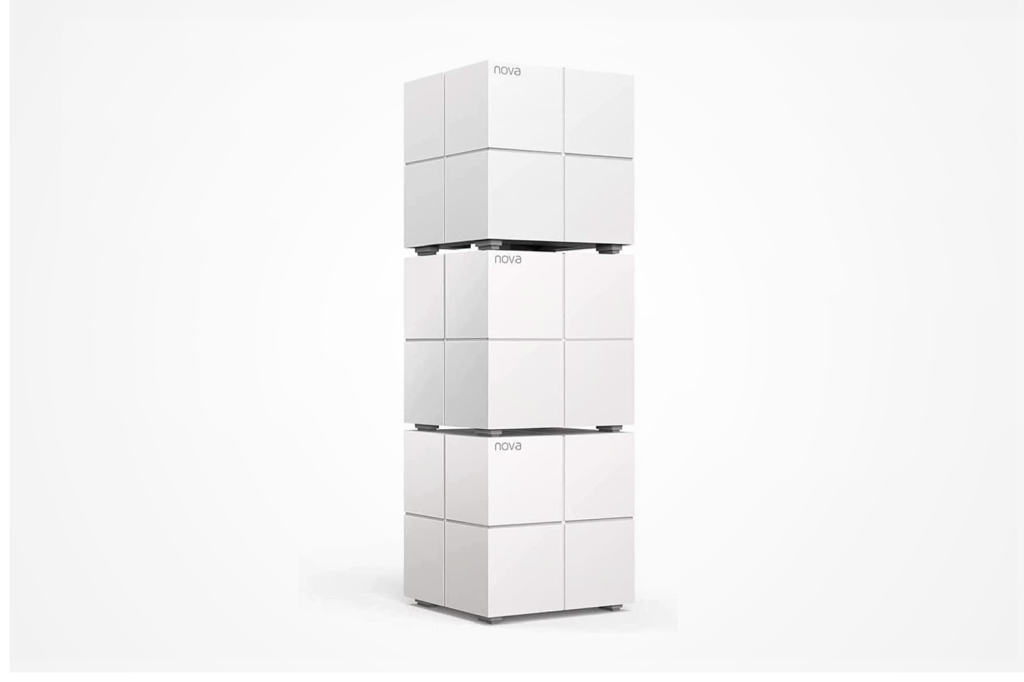
9. Tenda MW6 dual-band mesh Wi-Fi system
Stuff Verdict
Three mesh units at this price make for one of the best value options around
Pros
- Very cheap price
- Simple and great coverage
Cons
- No advanced features
| Tenda MW6 dual-band mesh Wi-Fi system specs | |
|---|---|
| Speed | Undisclosed |
| Coverage | 6000 sq ft |
| Extra features | None |
Three mesh units at this price make for one of the best value options around in our opinion, with a total covered area of up to 500 metres square making for a formidable whole-home solution.
Naturally, you’ll be compromising a bit on speed and tech, with older Wi-Fi 5 on the cards. Still, max speeds up to 300 Mbps on 2.4GHz and 867 Mbps on 5GHz are far from shabby, and should still be more than enough to meet even the needs of heavy users.
If you need to cover a lot of space and aren’t fussed about reaching the absolute best top speeds (which most of us rarely need anyway), then we think this is a great, sensible option, with the added bonus of futuristic-looking cubes thrown in for good measure.
How to choose the best mesh Wi-Fi system for you
Mesh routers are an amazing solution for covering each and every corner of your house in strong, speedy Wi-Fi. Rather than relying on a single router which wouldn’t be able to cover such large distances, mesh nodes placed around your home ensure a strong and stable connection, while acting as a single access point to connect to, no matter what room you’re in.
The very best mesh Wi-Fi systems will come with advanced features like a 6 GHz band to minimise interference, the ability for multiple simultaneous streams for busy households, and the latest Wi-Fi 6 and 6E standards for maximum futureproofing.
You might not need all those though, and often, you can pick up a cheaper solution with specs that are more than good enough for your needs. Read through our suggestions below, click on the links to learn more, and see which one is best for you.
How we test the best mesh Wi-Fi systems
Our experienced expert reviewers have tried countless mesh Wi-Fi routers over the years, and have included ones that have been personally tested where possible.
Elsewhere, we’ve looked at specs, brand quality, and customer reviews to pick the products we feel will be the best for most people, across a variety of budgets.
For more information on Stuff’s rating and review process, read our page on how we test products.
Trouble is, there are almost too many Sky services and packages to choose from, which is where we come in. We’ve searched high and low for the best Sky deals, and have highlighted some of our top picks below. Happy viewing and/or surfing…
Best Sky broadband deals

Sky has numerous broadband deals on offer, with speeds up to 900Mb/s. We’ve highlighted the best deals below, but you’re welcome to check out this full range of Sky broadband deals directly, if you prefer.
- Sky 145Mb/s Ultrafast Broadband / £28/month, 18 months, £0 setup fee: If you’re after Sky broadband with no extras, this 145Mb/s package is definitely your best bet, costing only £1 more a month than the 36Mb/s package.
- Sky 500Mb/s Ultrafast+ Broadband / £34/month, 18 months, £0 setup fee: Fancy faster speeds for a little more? the 500Mb/s package has you covered.
- Sky 900Mb/s Gigafast Broadband / £42/month, 18 months, £0 setup fee: If speed is everything, then you can’t go wrong with this top-tier package. It might be overkill for some, but if you’re regularly dealing with large downloads in the form of things like large AAA games and multiple simultaneous streaming across different rooms, then this is the package for you.
Best Sky TV and broadband deals
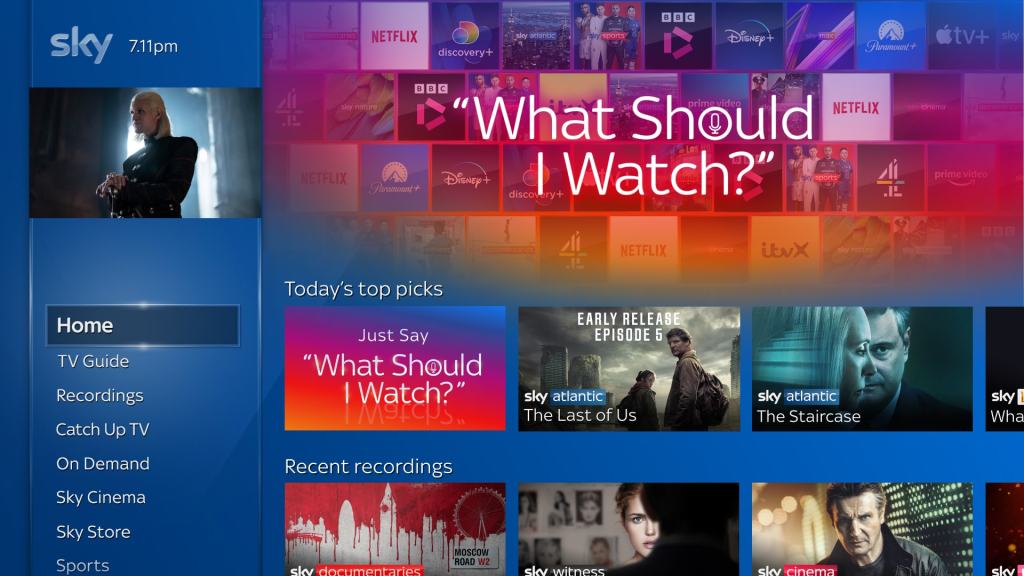
If you’d like a mix of TV and broadband, there are a few choice deals available below, or you can check out Sky’s full range of TV and broadband deals.
Note, for the packages that include Sky Stream (aka, Sky’s dishless streaming box), it’s worth noting what it actually includes — over 300 channels (plus over 100 channels to Freeview), and award-winning Sky Exclusives and Originals. It’ll cost you extra if you want to add things like Sky Sports, Sky Kids, or Sky Cinema.
- Sky Stream, Netflix Standard with Ads & Ultrafast 145Mb/s Broadband / £39/month, 18 months, £0 setup fee: This bundle includes a Sky Stream box (extra subscriptions required), along with the ad-tier version of Netflix, and a broadband package that should be more than fast enough for most people.
- Sky Stream, Netflix Standard with Ads & Ultrafast 500Mb/s Broadband / £39/month, 18 months, £0 setup fee: The same as above, but with a huge leap in broadband speed, up to 500Mb/s. There’s also a 900Mb/s package for £53 a month, but we reckon this particular package hits the price-to-performance sweet spot.
Best Sky TV deals

Already got your internet sorted? Then check out Sky’s full range of TV deals. Our personal picks are below:
- Sky Stream, Sky TV & Netflix / £31/month (£0 for the first month), 31-day rolling contract: This bundle includes a Sky Stream box (including Sky Entertainment consisting over over 300 channels, plus 100+ channels of Freeview, Sky Exclusives, and Originals), along with the ad-tier version of Netflix. The first month is free, after which it’s £31. We particularly like that this is a rolling contract too, which is ideal if you don’t want to commit for a year or more.
- Sky Stream, Sky Sports, Sky TV & Netflix / £46/month (£20 for the first month), 18 months: The same as above, but with the addition of nine dedicated Sky Sports channels.
- Sky Stream, Sky Cinema, Sky TV & Netflix / £36/month (£10 for the first month), 18 months: And if you like movies, this is the package for you, thanks to the inclusion of Sky Cinema.
Best Sky Glass deals
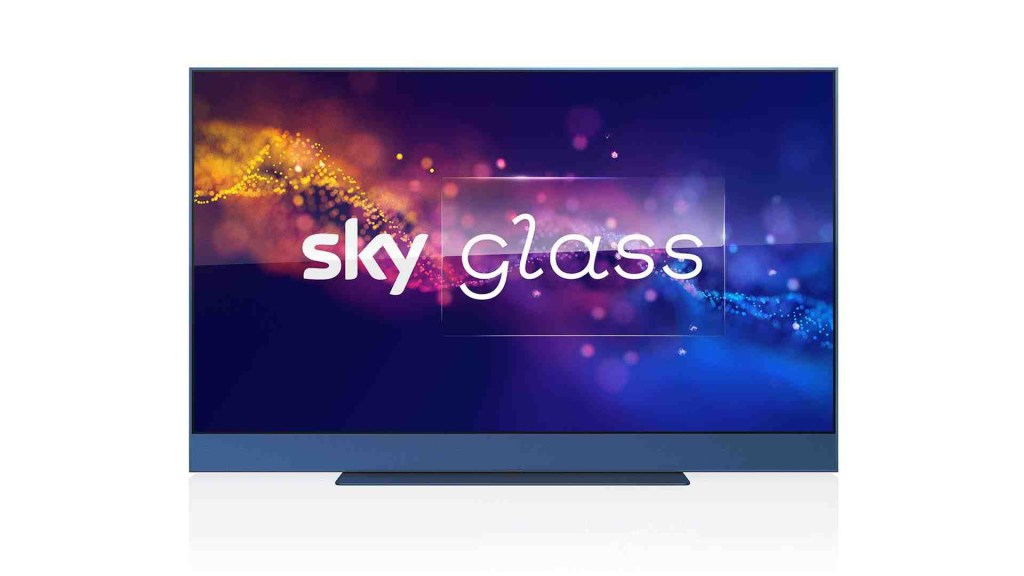
Got your sights set on the Sky Glass TV? Luckily for you, there are plenty of deals for that too.
- Sky Glass 43in UHD TV / £14/month 0% APR, or £699 upfront when taken with a Sky TV & Netflix subscription (£0/month for 3 months, then £26/month): If you’re really looking for an all-in-one, zero hassle solution, then you might as well go for a Sky Glass package which covers not only a new telly, but also Sky TV to help kick things off. Available in 43in, 55in, and 65in sizes.
Best Mobile deals
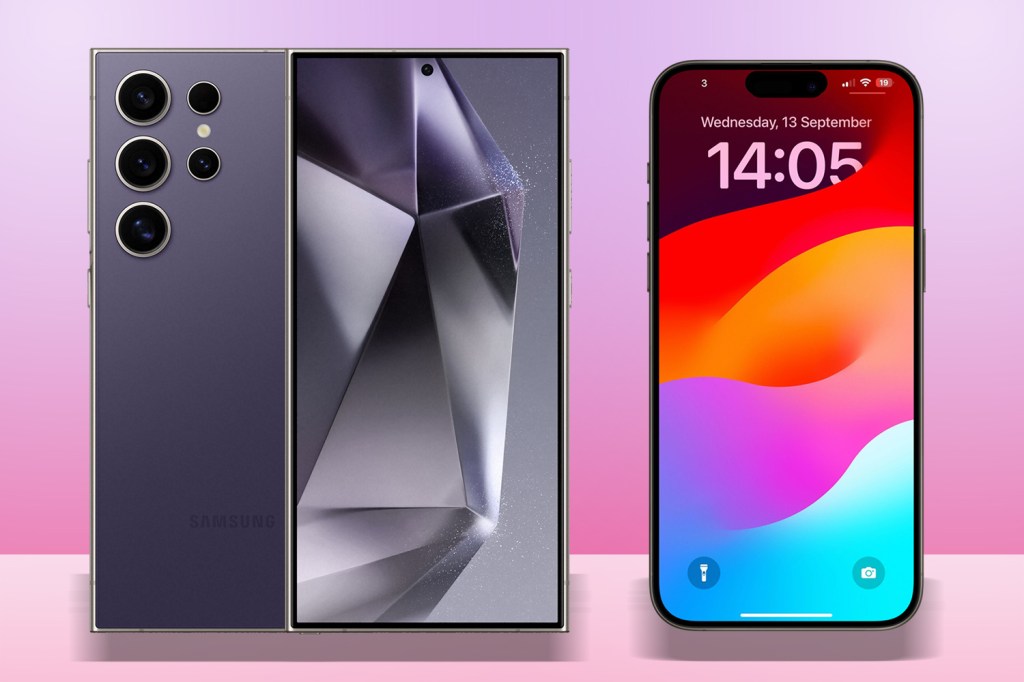
There are also all manner of deals for Sky Mobile. We’ve picked a couple of our favourites below:
- iPhone 15 Pro Max / From £35/month: Apple’s latest and greatest handset can be yours from as little as £35 a month for the 256GB model, although that only includes 100MB of data. The 25GB/month plan will bump the monthly cost up to a still-respectable £47.
- Samsung Galaxy S24 Ultra / From £41/month: Samsung’s stunning do-it-all flagship is available from £41 a month for the handset only. This goes up to £56 a month if you want a generous amount of data, around the 50GB/month mark.
- Read more: Sony Xperia 1 VI review: the golden ratio
Its biggest draw is a whopping 5000mAh battery which, while not a world record holder, is certainly more than acceptable, with two days of use promised per charge. That might not be enough for a week in the desert at Burning Man, but it’s still ideal for a weekend getaway if you’ve forgotten your charger. Sony is also touting its Xperia Adaptive Charging technology, which promises to ensure that the batter stays healthy for three years by continuously monitoring the handset’s charging process to prevent unnecessary strain.
Despite its 6.1-inch Full HD+ OLED display, the Xperia 10 VI is a relatively lightweight handset, tipping the scales at a respectable 164g (the iPhone 15, for comparison, weighs 171g). This, combined with its hardy resin body material, Gorilla Glass Victus, and IP65/68 waterproof and dustproof performance, should offer peace of mind while you’re throwing tumultuous cider-fuelled shapes in a field somewhere.
Round the back, you’ll find a dual camera setup serving up three focal lengths (16mm, 26mm, and 52mm) for shooting, along with OIS and a 2x optical zoom equivalent. Sony is also targeting Reel Enthusiasts with a Video Creator app which generates short videos from your captured photos and video footage.
Another feature worthy of note is an honest-to-goodness, 100% organic, 3.5mm headphone jack which, in this day and age, is an absolute treat. It’ll also go some way to helping preserve that precious battery life, sapping far less energy than Bluetooth headphones or speakers. Sony’s DSEE Ultimate upscaling tech also aims to upscale audio from things like streaming services to a higher, uncompressed quality.
If that all floats your boat, you’ll be pleased to hear that the Xperia 10 VI will be available in Blue, Black and White from the middle of June onwards for £349 / €399 (US pricing and release information TBC). Pre-orders start from the 15 May, directly from Sony or Amazon.
]]>